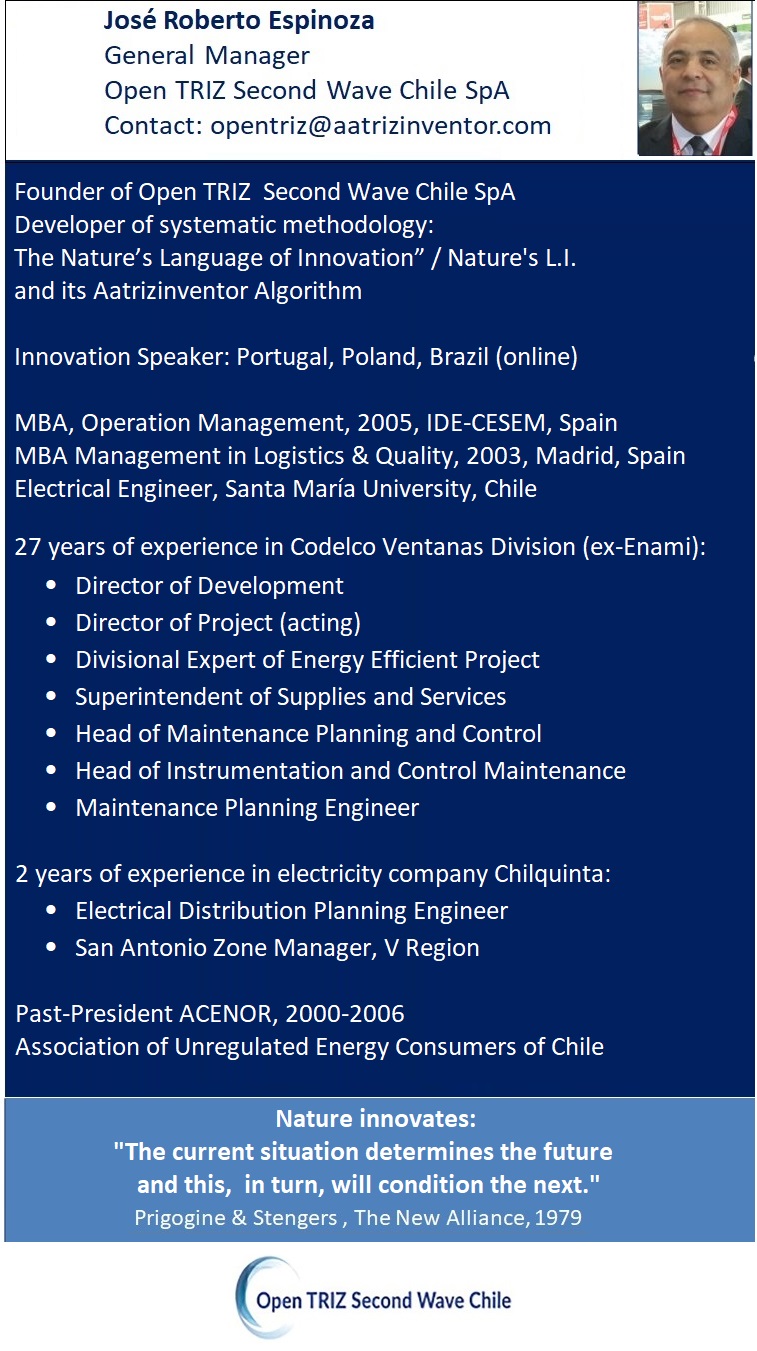AATRIZINVENTOR ALGORITHM OF NATURE'S L.I. INNOVATION METHODOLOGY
5 CASES STEP BY STEP
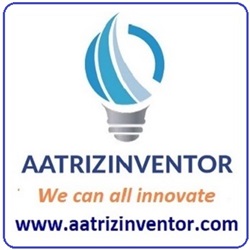
Select Topic:
This manual presents the integrated innovation methodology known as "Nature's Innovation Language" or Nature's L.I., along with its application algorithm called Aatrizinventor. Here, the main characteristics of this methodology are applied, and 5 case studies are formulated and solved step by step. These are as follows:
a. Improving the service of hot coffee in a plastic cup affected by burning customers' hands
b. Designing the best Lego toy for children affected by designer paradigms
c. Improving a person's action to move a reluctant animal to walk
d. Ensuring stable navigation of a ferry affected by water ingress into the cargo space
e. Improving the extraction of the door visor lock pin from the ferry's cargo space affected by jamming in the male-female parts of the closing mechanism
It's important to note that innovation has multiple perspectives, as its aim is to satisfy ever-evolving needs. Therefore, innovation is not an exact science. It requires the combination of relational and logical thinking skills.
Relational thinking is an idea generator that enables the discovery of connections between seemingly divergent concepts and combines them into a coherent solution that relates to the posed innovation challenge. This type of thinking is innovative and is comfortable exploring different methods and alternative solutions.
On the other hand, logical thinking is methodical and tends to be less flexible. It focuses on details and prefers clear and precise definitions to achieve a consistent solution that is enduring and robust. Logical thinking is organized, systematic, and thrives when the processed information is well-founded.br>
Nature's L.I. facilitates the task for relational thinking, selecting real-world solutions applicable to the formulated innovation challenge, where the innovator must be capable of interpreting them and proposing a coherent solution. In other words, that it is perceived clearly and precisely by all individuals involved in successfully addressing the innovation challenge intended to be solved.
Furthermore, Nature's L.I. also aids logical thinking by recommending real-world solutions that have been evaluated. This provides confidence to the Innovator to implement a solution consistent. In other words, that it is capable of enduring over time under the same circumstances that gave rise to it, so that it solves the innovation challenge in a permanent manner.
In summary, the success of innovation is a shared responsibility between the Innovator and Nature's L.I.
1.1 Genesis and Scope of Nature's L.I.
The Nature's Language of Innovation, also known as Nature's L.I., is an innovation methodology that combines existing practices of improvement and innovation. It recognizes in nature the source of innovation parameters and inventive principles that guide innovation-evolution processes. Contradictions between parameters and the principles that resolve them determine sustained changes in nature, whether in humans, other living beings, or material or abstract objects that have the ability or desire to interact with others.
Nature 'knows': for the same problem, the same solution
The innovation methodology known as "The Language of Nature's Innovation" or Nature's L.I. has been developed by combining concepts from various theories. Concepts from the Theory of Constraints (TOC), developed by Eliyahu M. Goldratt, have been utilized to formulate operational problems and innovation challenges. Elements from the Theory of Inventive Problem Solving (TRIZ) and its Contradiction Matrix, introduced by Genrich Altshuller, have been incorporated to derive solutions based on real-world and nature-inspired solutions. Additionally, the Morphological Analysis Method (A.M.), created by Fritz Zwicky, has been applied, which suggests, among other recommendations, solving problems one by one.
This combination of ideas has enabled the identification of a powerful innovation methodology that encompasses a universal definition of innovation parameters and the inventive principles from TRIZ. The results obtained so far have provided an initial understanding of the language of innovation in nature. It is noteworthy that the concept of an innovation language in nature was suggested by Ilya Prigogine, Nobel laureate in Chemistry in 1977, in his book "The New Alliance", co-authored with Isabelle Stengers in 1979.
Nature's L.I. recognizes that the classical Contradiction Matrix from TRIZ, derived from engineering, contains the universal innovation solutions of the world, based on the 39 innovation parameters and the 40 inventive principles identified by TRIZ. Nature's L.I. has provided them with a broader description beyond engineering. In the new conception proposed by Nature's L.I., the 39 parameters are divided into 24 parameters for undesired effects and 10 parameters for needs to satisfy. These mentioned parameters and principles come with an updated and universal description, allowing their application in any realm of nature and human development. If you're not familiar with this Matrix, you can refer to Chapter 17 of this Manual for more information. It's not necessary to memorize it or perform calculations with it.
Nature's L.I. states and shows evidence in its book 'The Nature's Language of Innovation', Amazon, Kindle' that through this methodology, it's possible to obtain the innovation-evolution solutions of Nature and Human Development since their creation:
Nature innovates
Nature's L.I recognizes that the solution of problems and innovation challenges is multivariable, that is, each case can include several innovations
parameters, which means that it is necessary to solve a set of contradictions that are consistent with each other. Based on abductive thinking, it
is assumed that the set of contradictions contains the solution sought, which can be found with a rigorous and exhaustive review of the identified
contradictions. This process has been systematized through the own development of a mathematical algorithm called Aatrizinventor.
Nature's L.I., using its Aatrizinventor algorithm, offers speed and focus to find solutions to multivariable innovation problems and
challenges. From a physical contradiction, up to twenty technical contradictions are evaluated, which when solved allow to achieve the
desired objective.
Nature's L.I. through its Aatrizinventor algorithm, it helps to listen more to this innovative nature.
Nature's L.I. invites you to access a highly systematic way to obtain accurate and reliable innovation solutions, to satisfy your real or potential needs in any field
of human development, including those that you consider impossible to satisfy.
Book "The New Alliance", 1979
1.2 Management Map for Systematic Innovation
Nature's L.I. it is integrated with other improvement and innovation management methodologies, according to the following management map:

More information about Nature's L.I. will be seen in the following Topics of this Manual.
1.3 The Future of Jobs Report 2020, World Economic Forum
Nature's L.I. it completes its formulation precisely in times of crisis and pandemic, where the needs for change require speed and focus.
To measure the contribution that Nature's L.I. can deliver to the change processes that will be required post-pandemic, the main findings of the report
'The Future of Jobs Report 2020', published by the World Economic Forum in October 2020, are shown below, as a referential context.
The key findings of the report are as follows:
I. The pace of technology adoption is expected to remain unabated and may accelerate in some areas.
II. Automation, in tandem with the COVID-19 recession, is creating a ‘double-disruption’ scenario for workers.
III. Although the number of jobs destroyed will be surpassed by the number of ‘jobs of tomorrow’ created, in contrast to previous years, job creation is
slowing while job destruction accelerates.
IV. Skills gaps continue to be high as in-demand skills across jobs change in the next five years.
V. The future of work has already arrived for a large majority of the online white-collar workforce.
VI. In the absence of proactive efforts, inequality is likely to be exacerbated by the dual impact of technology and the pandemic recession.
VII. Online learning and training is on the rise but looks different for those in employment and those who are unemployed.
VIII. The window of opportunity to reskill and upskill workers has become shorter in the newly constrained labour market.
IX. Despite the current economic downturn, the large majority of employers recognize the value of human capital investment.
X. Companies need to invest in better metrics of human and social capital through adoption of environmental, social and governance (ESG) metrics and matched
with renewed measures of human capital accounting.
XI. The public sector needs to provide stronger support for reskilling and upskilling for at-risk or displaced workers.
The indicated conclusions show enormous challenges to face the future and solutions must come from many areas of human endeavor, with speed and focus.
1.4 Contribution from Nature's L.I.
For now, Nature's L.I. focuses on challenge IV., referring to skills gaps. 'The Nature's Language of Innovation' can be a direct
support to satisfy 5 of the 10 skills associated with problem solving, which according to The Future of Jobs Report 2020 will be required by 2025
(The Future of Jobs Report 2020 : 2.3 Emerging and Declining Skills).
Below are the TOP 10 skills gaps and which ones may have direct support from Nature's L.I.

1.5 Nature’s L.I. and Logical and Relational Thinking in productive and service companies
The aforementioned report from the World Economic Forum establishes as a first priority gap the need to improve the ability to
'Analytical thinking and innovation'. For Nature's L.I. Analytical thinking should be divided into two strands, based on the work of Ungvari, Steven, (1998),
'(TRIZ) OE = Improving TRIZ Results by Dynamically Matching Tools to Teams', which identifies two types of thinking relevant to problem solving and innovation
challenges:
Logical Thinking, which is associated with the characteristics necessary for the execution and continuity of the business and
Relational Thinking, associated with characteristics necessary for business change and innovation.
Below is a graph with the characteristics of both thinking.

In a successful Innovation Team, these two types of thinking must necessarily be integrated, being common that logical thinking occupies operational positions
in productive and service companies, while relational thinking dominates in R&D areas. Without this integration, when organizations face challenges of problem
solving or driving innovation, these two types of thinking come into contradiction, since in the short term they have different obligations that can make the
challenge fail. Resolving this contradiction is the first step for change, which companies must address. Using the methodology presented here, as described in the book mentioned in the following section 2.4 titled 'The Nature's Language of Innovation,' this contradiction was examined. Summarizing the conclusions, an early integration and active participation in innovation processes that develop relational thinking are recommended for Logical Thinking. On the other hand, for Relational Thinking, the recommendation is to carry out an integrated and systematic management of information associated with the innovation challenge, providing speed and focus to the innovation process. Surprisingly, this is precisely what the Aatrizinventor algorithm achieves, meaning it self-justifies.
Given the necessary integration, Open TRIZ Second Wave Chile SpA recommends implementing the Nature's L.I. systematic innovation methodology in companies, as detailed below.
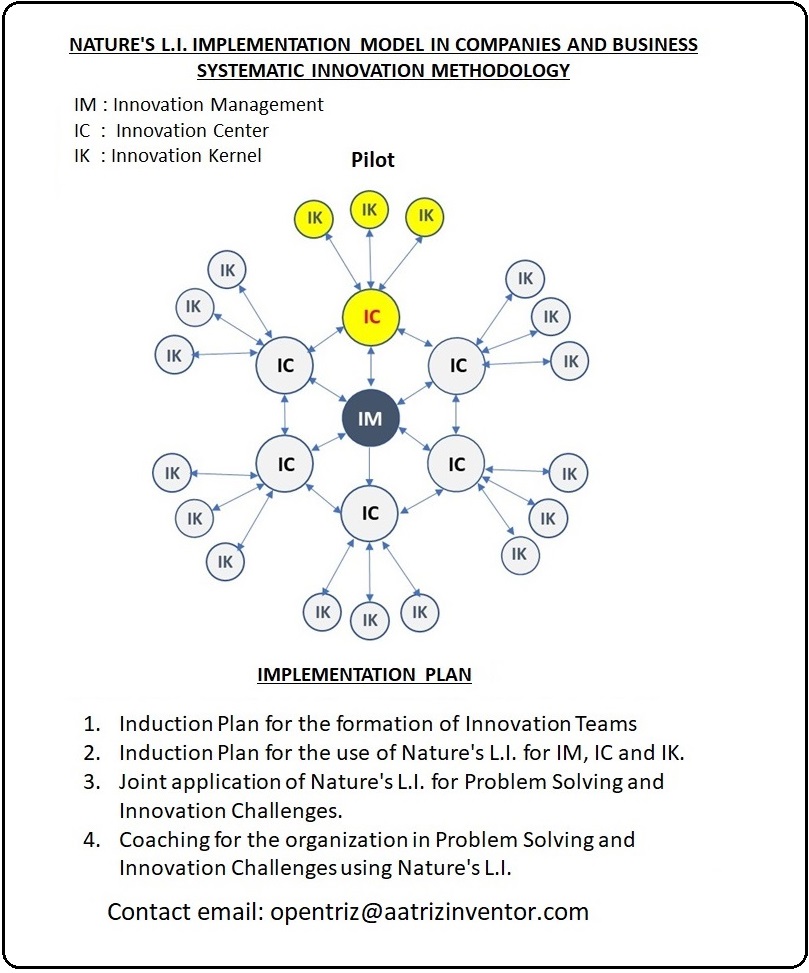
Nature's Innovation Language, Nature’s L.I., is a systematic innovation methodology that finds solutions
in a fast, focused and effective way to satisfy the needs of the people.
The success of this methodology is based on the fact that the Innovation Team or Problem Solver has a deep understanding of its activity, process or system, where the challenge to solve lies, also called endogenous knowledge, as described by Paul Romer,
co-winner of the 2018 Nobel Prize in Economic Sciences.
This methodology invites you to access a highly systematic way to obtain accurate and reliable innovation solutions, to satisfy your real or potential needs in any field of human development, including those that you consider impossible to satisfy. It enables solutions to be found without making trade-offs, by using defined and unique rules that are based on a systematic methodology, integrating existing mutually supportive theories of innovation.
2.1 Applied Concepts in Nature's Language of Innovation
* Theory of constraints - TOC
Developed by Eliyahu M. Goldratt who, among other concepts, applies the Evaporation Cloud (EC), also known as a conflict cloud or conflict resolution
diagram (CRD). This is a logical tool that aims to identify the elements of a conflict or dilemma in order to make developing win-win solutions
easier, with no constraints limiting it.
The EC diagram takes the form of a set of five boxes. The Innovation Team identifies two opposing wishes, which represent the conflict (D and D ');
the need (dissatisfaction) that each desire tries to satisfy (B and C); and a common goal or objective (A) for both needs.
Nature's L.I. postulates that innovation challenges are multivariable, then transforms this original EC diagram by applying a Multivariable
Modified Evaporation Cloud, called MMEC Diagram, see Topic 7 of the Manual, which from two opposing wishes or physical contradiction (D and D ') allows to
identify up to 4 effect undesirables causes of dissatisfaction (B, C, D, E) and one need to satisfy (A) for a desired objective.
Making a simile, you go from simultaneously solving two opposing problems or desires with TOC, to solving with Nature's L.I. up to 20 simultaneous problems.
The fulfillment of this objective is achieved by solving the existing multiple technical contradictions
between A, B, C, D and E, using the classic TRIZ Contradiction Matrix.
* Theory of inventive problem solving - TRIZ
TRIZ is based on a comprehensive patent investigation, conducted by Genrich Altshuller, a patent inspector for the Russian Navy, initiated
in 1946 . His fundamental discoveries are :
- Typical Invention Levels: 1. Apparent Solution (32%), 2. Improvement (45%), 3. Invention Within Paradigm (18%), 4. Invention Outside Paradigm
(4%), and 5. Discovery (1%). The objective of TRIZ and therefore Nature's L.I. is to increase inventive solutions, levels 3 and 4, and minimize levels 1 and 2.
- Solution cycle of an inventive problem: From a specific problem, this is transformed into a general TRIZ problem with which a general TRIZ
solution is obtained. With the real and specific knowledge of the problem, a specific conceptual solution of minimum cost and maximum benefit/cost
ratio is obtained.
- Innovation Parameters/ Contradictions TRIZ: An innovation problem or challenge is determined to exist when two engineering parameters are in contradiction
to achieve a given goal. That is, a parameter A in a current state makes it easier to achieve the desired objective, while a parameter B in its own current state makes it
difficult meet the desired goal. For example, the speed of a runner makes it easier for him to reach the goal quickly, but the weight of the runner makes it difficult for
him to meet the goal in the desired time. The analysis conducted by Altshuller allowed him to identify 39 engineering parameters, with which all the engineering contradictions of the world. With these
parameters, the Classic Matrix of Contradictions, 39x39, was formulated, determining 1248 contradictions between parameters, which are solved with combinations of up to
4 inventive principles.
Nature's L.I. postulates and proves that with a universal description of TRIZ's engineering parameters, which are called innovation parameters, it is possible to identify
contradictions in any time and space for nature and human beings, in our world and beyond. In each problem or innovation challenge it will be necessary to determine whether more
or less than a given value of an analyzed parameter is causing an undesirable effect. Knowledge of the current situation is essential to solve the problem or innovation challenge
using the Aatrizinventor algorithm.
The deep and relational domain of the concepts associated with each innovation parameter is essential to formulate an innovation challenge. In the link shown above 'Enter to Algorithm'
you can consult the description of each one of them. Likewise, you can review the examples presented in this Manual to see how they are applied.
- Inventive principles TRIZ: 40 inventive principles are identified that allow solving the 1248 contradictions identified. An inventive principle is a compilation of
various innovation concepts that describe actions, means, and / or forms that humanity has used to solve its innovation challenges. The concepts of innovation that include an
inventive principle can be applied independently each one or in association with some of them.
Nature's L.I. postulates and proves that with a universal description of the inventive principles of TRIZ, it is possible to determine solutions to problems and innovation
challenge in any time and space for nature and human beings, in our world and beyond. It should be borne in mind that the descriptions of the inventive principles assume a certain
state of the contradicting innovation parameters, for example [(+) temperature, (+) speed]. In the real world, the innovation parameters can be presented in different states:
[+, +], [+, -], [-, -] [-, +], then the interpretation of the given description of an inventive principle can be direct or inverse, depending on the real state of the evaluated
parameters. For example, if the inventive principle recommends vibrations, the solution may be to include vibrations in the evaluated object or to decrease or eliminate existing
vibrations. Knowledge of the current situation is essential to find a solution to the problem or innovation challenge.
The deep and relational understanding of the concepts associated with each inventive principle is essential to solve a problem or an innovation challenge.
" In link shown above 'Enter to Algorithm' you can consult the description of each one of them. Likewise, you can review the examples presented in this Manual to see how they
are applied.
- General Conclusion: There is a repetition in the way people solve inventive problems. As an example, the book already referred
to shows the case of the difficulty of a drug to cross the blood-brain barrier to cure a disease in the brain and, on the other hand, the case of the
difficulty of the Greeks to cross the defensive barrier to invade Troy. Both cases are formulated with the same TRIZ parameters, therefore
consequently, they have the same general TRIZ solution. The Trojan horse for the medicine will be to wrap it with a covering of lipids or sugars,
which the blood-brain barrier allows its passage since the brain is a great consumer of sugar. Inside the sugar coating goes the
medicine, as inside the horse, a divinity for the Trojans that was the sugar that opened the doors, go the warriors who invade Troy.
It has not been conclusively proven that the story told by Greek mythology is real, but it is amazing that the Trojan horse solution coincides
with the principles of innovation that nature's language of innovation gives us.
2.2 TRIZ application in Nature's L.I.
* TRIZ Contradiction Matrix, Parameters and Principles
- Nature's L.I. uses the original TRIZ matrix of technical contradictions, created by Altshuller, which contains 39 engineering-innovation
parameters, arranged in a 39x39 matrix, see Topic 17 of the Manual. Each intersection between two parameters represents a contradiction, indicating how it is
solved with up to 4 inventive principles, selected from a total of 40 identified. The matrix allows to represent 1,482 contradictions, of
which TRIZ presents a solution for 1,248. The solution to the contradictions expressed in the TRIZ matrix has been validated by more than 2 million
patents in the world, declare the TRIZ specialists.
- The Engineering-Innovation Parameters are used, which Nature's L.I. called Innovation Parameters, and the Inventive Principles of the world
identified by Altshuller, including a universal update of the descriptions of both, given their origin in the field of engineering.
- Nature's L.I. divide the innovation parameters into those that are undesirable effects causes of dissatisfaction, 28 over 39, 24 for a moving object
and 24 for a stationary object, see Topic 8 of the Manual. On the other hand, Nature's L.I. determines parameters are desirable effects for
Needs to Satisfy, 12 over 39, 10 for a moving object and 10 for a stationary object, see Topic 10 of the Manual.
- Nature's L.I. postulates that there is a physical contradiction, caused by a physical or characteristic variable, see Topic 7 and 9 of this
Manual, which in a given state causes undesirable effects, which are associated with the corresponding TRIZ innovation parameters, which make it
difficult to achieve an objective desired to solve a problem, or innovation challenge. The same variable, in the same or different state, causes a
desired effect, which is associated with an innovation parameter of need to satisfy, which facilitates achieving the desired objective. The
formulation of this physical contradiction allows the discovery of a set of technical contradictions, tabulated in the TRIZ Contradiction Matrix,
whose joint analysis, based on the inventive principles they include, will provide a general solution to the problem or challenge of innovation
under evaluation. The knowledge that the Innovation Team must have of the problem or challenge evaluated will allow them to build a specific
solution according to their own reality.
- For a better understanding of the TRIZ recommended solution, the inventive principles have been divided into three groups that guide the solution:
Strategic principles (13), which are the driving force of change, Tactical principles (13), which ensure the required functionality for
change and Operational Principles (14) that allow change to work. These are identified below.
Nature's L.I. has proven that it can apply
the above definitions to solve innovation-evolution challenges, and problems in general in any time and space of evolution of nature
and human development.
TRIZ UNIVERSAL INNOVATION PARAMETERS
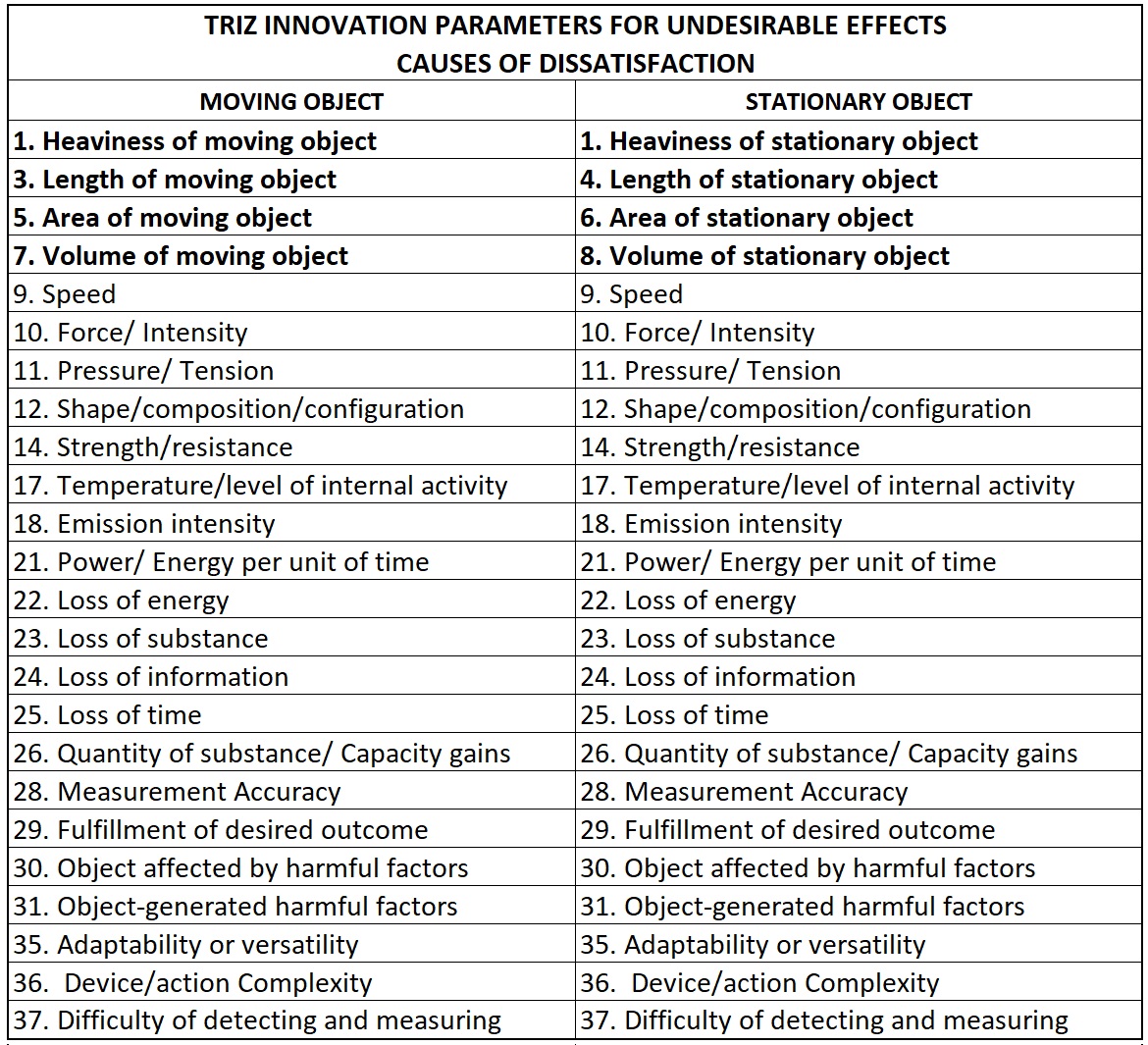
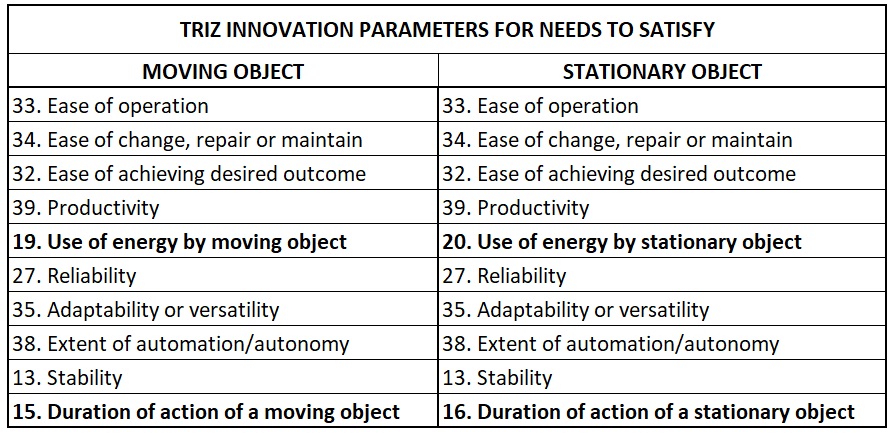
The order in which the needs to satisfy parameters are presented, represents for Nature's L.I. the most probable S
curve of innovation-evolution of any activity or process that develops an object. Disruptive innovations generate changes or jumps to other S curves,
which must complete this same cycle. The ability that human beings achieve to generate disruptive leaps, implicitly applying the language of
innovation of nature, gave them a differentiating factor of evolution in this nature to which we belong.
UNIVERSAL TRIZ INVENTIVE PRINCIPLES
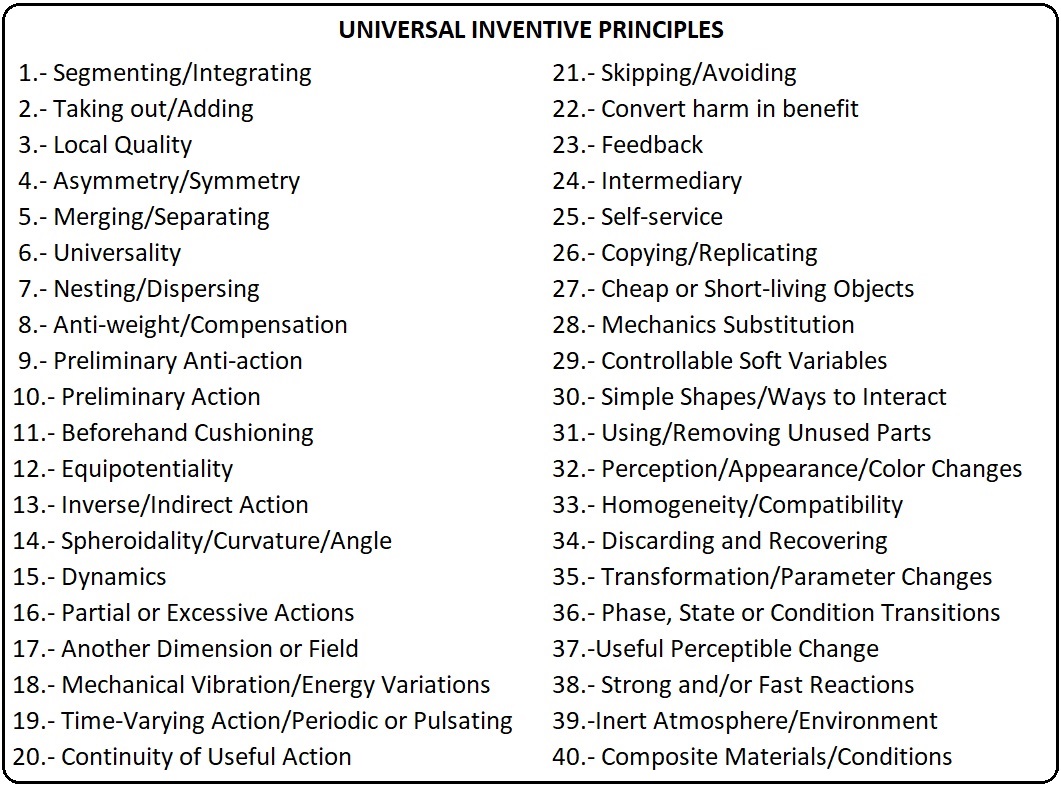
A detailed review of the position occupied by the inventive principles in each contradiction of the TRIZ Contradiction Matrix, made it possible to identify
that there are groups of principles with a different number of times that they occupy position 1. It has been possible to conceptualize that those principles
that have greater participation deliver a strategic view of the solution, the intermediate participation group focuses on giving tactical
functionality to the solution and there is a third group that is oriented to the operation of the solution. This generic interpretation of inventive
principles involved in a contradiction between two innovation parameters of TRIZ, has turned out to be particularly useful to identify solutions for innovation
challenges.
* Principles of Separation
Darrel Mann, an international innovation expert, in his paper 'The Four Pillars of TRIZ' has proposed a relationship between
the inventive principles of TRIZ and the principles of separation, another TRIZ innovation technique. These relationships are shown below and the
separation principles are described, which summarize a set of practical recommendations that facilitate the understanding of the solutions proposed
by the inventive principles. This relationship with each inventive principle is shown at the end of each description delivered by the Aatrizinventor
algorithm. Later we will see examples for the case of improving service of hot coffee in a plastic cup.
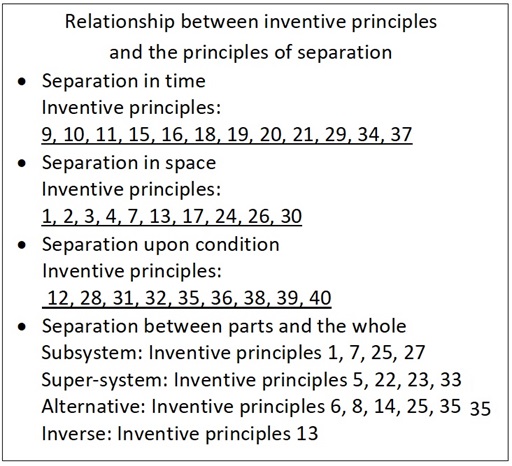
a. Separation in time
Alternatives: For certain properties or characteristics, analyze under what conditions each is needed. Are they required at the
same time, should they be continuous or variable in time ?; Consider providing properties or characteristics in advance; Consider using a carrier,
from the environment or by process, which provides you with a certain property or characteristic over a period of time and that, if necessary. will
be removed will disappear later; "." Consider using a time transformable state; Consider segmenting the object, to have it re-merged at another
time, or consider creating two different states in time; Consider making the element adjustable so that it can have certain properties at
different times.
b. Separation in space
Alternatives: For certain properties or characteristics, analyze under what conditions each is needed. Are they required in the
same space ?; Consider the distinct parts of an object. Can differently parts, in different spaces, have opposite properties or new properties ?;
Consider the separation in space of the opposite properties of the interacting objects (S1 and S2): Consider making the object have different
properties, but in separate places, making it non-uniform.
c. Separation by condition
Identify the conditions under which an object has a certain characteristic or value of a relevant property. Determine if you can
separate in time or space for one or more of the identified conditions. What are the conditions that we must change ?; Identify the physical fields
or inherent characteristics of the object. What physical fields or characteristics should change in the new conditions ?; Identify the function
required to satisfy the constraint; What physical phenomena can be used to achieve the required function? If you are familiar with identifying
related physical phenomena, produce the required function. If not, use Nature's L.I., applying reverse innovation, to select the physical phenomena that can be used to obtain the desired function.
d. Separation between parts and the whole
d1.Separation into subsystems
Consider segmenting the object or its action, or merging with other parts, or new actions to achieve a desired characteristic, property, or function, or to avoid an undesired one
d2. Integration in supersystem
If an object or its action does not have a certain characteristic or property, or is not capable of performing a certain function, consider the
possibility of merging it with another object to create a supersystem that fulfills the desired or avoids the undesired.
d3. Alternative separation
Consider the possibility that parts of an object or new ones, added or self-generated, have new characteristics and properties that support each
other to achieve the desired characteristic, property or function, or to avoid the undesired one.
d.4 Inverse separation
Consider associating the evaluated object with a carrier or complement that acts inversely or indirectly in relation to the current action, to
achieve a characteristic, property or function that is opposite to the existing undesirable one.
* Solution Strategies
This is another proposal by Darrel Mann in 'The Four Pillars of TRIZ', which establishes that there are different strategies to reach the solution
with the object evaluated, which correspond to a set of practical recommendations that are shown below. These relationships are also indicated at the
end of each inventive principle described by Aatrizinventor.

* Morphological Analysis Method
Innovation methodology created by Fritz Zwicky. Morphological analysis, in its essence, refers to the structured analysis of the cause-effect relationships between the distinct parts or aspects of the object of study. Applies a procedure in stages, which considers: Identification and formulation of the problem, Analysis; Synthesis and presentation of results. Nature's L.I. applies these same concepts with a more accelerated operation than the one proposed by Zwicky, based on the valuable knowledge implicit in the TRIZ matrix of contradictions, giving relevance to only one of the basic assumptions of the morphological analysis: the problems are solved one by one , in this case for each Need to satisfy identified for Nature's LI, associated with 10 TRIZ innovation parameters, described above. This definition is based on the following recommendation from the morphological analysis: 'every subproblem should be considered independent of the other subproblems, and their relationships with the other subproblems should be temporarily suspended'.
2.3 Innovation Methodology Tools Nature's L.I.
* Innovation Model :To solve a multivariate innovation challenge, up to 5 TRIZ innovation parameters derived
from 4 undesirable effects identified as causes of dissatisfaction are evaluated each time, plus an innovation parameter associated with a desirable
effect, corresponding to one of the 10 innovation parameters of needs to satisfy. This number of undesirable parameters to evaluate, out of a total
of 24 possible to identify for a moving or stationary object, is justified because the undesirable effects that occur for a pair of interacting
objects are a small number, no more than 7, according to our practice, and Nature's L.I. has empirically proven that it can jointly evaluate up to
4 of them and perform sensitivity analysis with 3 additional ones. Each selected contradiction is solved with the inventive principles
tabulated in TRIZ's classic Contradiction Matrix, created by H. Altshuller. Nature's L.I. provides a universal description of the 39 innovation
parameters and the 40 inventive principles identified by H. Altshuller, which allow their application to any challenges in nature and any field of human beings.
Nature's L.I. postulates that there is a 5x5 contradiction matrix that solves the innovation challenge or existing problem, delivering a
solution of minimum cost and maximum benefit / cost ratio. As an example, below is a specific matrix that has been deduced for 'Improve
service of hot coffee in a plastic cup affected by burning the Customers' hand'. The matrix shows the undesirable effects, expressed
as TRIZ innovation parameters: 1/23/29/25, and the desirable effect or need to satisfy, also as TRIZ innovation parameter: 13. In each cell the
inventive principles that solve the contradiction between each pair of parameters are shown.

Additionally, there is the matrix of contradictions between the selected need to satisfy, 13. Stability in this case, and the other defined needs to
satisfy. In any case that is evaluated, this matrix must also be solved, using the corresponding need-to-satisfy parameter.

Matrix between Needs to Satisfy to Improve Hot coffee service in a plastic cup for Needs to Satisfy: Stability
This simple example of drinking hot coffee in a plastic cup will demonstrate how Nature's L.I. solves business problems
using a universal description of TRIZ inventive principles and parameters, the original description of which has an engineering bias. The universal
descriptions that are provided facilitate the solution of innovation challenges in any field of knowledge and can explain the innovation-evolution
processes of nature, as a continuous solution of needs to satisfy. Nothing is spontaneous or random, everything has a reason: the current situation
will determine the future and this in turn will condition the next.
* Formulation of the Problem or Innovation Challenge:
The question that must have already
arisen is: How do you get to the specific matrix indicated above? Starting from Topic 3 of this Manual, the formulation of the innovation
challenge is developed, which includes obtaining this matrix and other relevant aspects. Here is an introduction to this topic.
The first step is to identify an S1 object, which, interacting with an S2 object, does not meet a desired objective, representing a problem or
innovation challenge to be solved. In the case of hot coffee, it will be:
"Objective: Improve service of hot coffee in a plastic cup.
The next step, based on the current knowledge of the problem or innovation
challenge, will be to identify the undesirable effects, causes of existing dissatisfaction, 7 at most, that affect S1. Finally, each
undesirable effect identified must be related to one of the 24 TRIZ innovation parameters defined, with the criteria explained
in Topic 8.
Below is an example of the result of the analysis conducted for the innovation challenge of 'Improve service of hot coffee in a plastic
cup affected by rejection by burning Clients' hand, where S1 Object = Plastic Cup, with hot coffee, and S2 Object = Customer, who
consumes hot coffee.

to improve service of hot coffee in a plastic cup
To complete the formulation process, the need to satisfy that will be evaluated must be determined, one of the 10 defined, for a moving
or stationary object. The innovation parameters of needs to be satisfied are shown above, of which one will be chosen. The Innovation Team
must make this selection with the best information available and according to the result that they would like to achieve. In Topic 10 the recommended
criteria for making this decision are indicated, which could be an iterative process. In the case of improving the service of hot coffee
in a plastic cup, it was first considered to improve reliability, but finally the recommendation that the algorithm gave was chosen:
Improve the stability of the hot coffee service in a plastic cup.

The innovation model proposed by Nature's L.I requires a rigorous logical formulation of the problem, or innovation challenge, related to the object
S1 evaluated. The undesirable effects identified and the need to satisfy must constitute a coherent and logical body of ideas, which allows anyone to
understand them. To facilitate the logical revision of the formulation, a mind map has been created that contains all the information shown here.
See its fundamentals in Topic 7. and its application to the cases described in this Manual in Topic 11.
Topic 14 shows in detail the solution proposed by the Aatrizinventor algorithm for this case, using the selected innovation parameters,
as explained below.
* Innovation Algorithm Aatrizinventor :
The selection of parameters indicated above corresponds to the best determination of the current situation that the Innovative Team can make, which represents the multivariable challenge to be solved. The origin of the Aatrizinventor algorithm is initially inspired by the work of Valeri Souchkov, (2005, updated 2010), 'Root Conflict Analysis (RCA+): Structured Problems and Contradictions Mapping', which proposes a systematic way of finding multiple contradictions in a problem. From this reference and others in Nature's L.I. that are integrated, such as the separation of TRIZ parameters into undesirable and desirable effects and that the defined desires are solved one by one, the algorithm used here acquires the characteristics of giving speed and focus to solve any innovation challenge.
The Aatrizinventor algorithm can evaluate up to 4 parameters of undesirable effects, then the Team must identify the parameters,
which to its best understanding should be evaluated together with the parameter of need to satisfy selected. The selected innovation parameters must
be ordered as shown in Table below. The description of the undesirable effects and the desired effect can be expressed openly or use only the
acronym UDE. + Parameter No. for a private analysis of the solution.
ordered according to the experience of the Innovation Team to Improve Service of hot coffee in a plastic cup

The parameters selected to evaluate will give rise to the specific matrix of contradictions shown above in paragraph Innovation
Model. For an accelerated approach to the most probable solution of minimum cost and maximum benefit / cost ratio, the mathematical algorithm
AATRIZINVENTOR prioritizes the contradictions (20) of this specific matrix of 5x5 selected parameters, which contains the solution to improve service
of hot coffee in plastic cup. The existence of a solution is supported by abductive thinking: If the contradictions incorporated in the TRIZ
Contradiction Matrix have been widely validated, then the integrated solution containing a subset of contradictions is also valid. This abductive
prediction has been demonstrated in many cases, as indicated below. More details of the algorithm can be seen in the book 'Nature's Language
of Innovation'.
The AATRIZINVENTOR algorithm determines the essential contradiction, the 4
complementary and the most relevant contradictions between needs to satisfy, as shown in Topic 14 of the Manual and in 'Enter to Algorithm'/'Aatrizinventor Examples',
see link above. These contradictions propose a general solution, from which the Innovation Team must shape the specific solution that will be applied
to solve the problem or innovation challenge that is under evaluation.
The experience in applying this methodology has taught that in some cases, the selection of parameters to be evaluated has been affected by paradigms
or beliefs of the Innovation Team, which prioritizes undesirable effects that could be less important to obtain a more effective solution. This makes
the general solution obtained difficult to lead to a specific solution, which makes sense. To solve
this limitation, it was discovered that a relevant indicator of the level of certainty to rapidly construct a specific solution could be measured
by determining the level of coverage or repetition between the inventive principles included in the Solution Specific Contradiction Matrix and those
included in the corresponding Matrix of contradictions between needs to satisfy, such as those shown in the previous paragraph: Innovation Model.
To avoid this difficulty, the algorithm performs a sensitivity analysis that prioritizes solutions, as explained below.
In the case of serving hot coffee in plastic cups, the result of this analysis is shown in Topic 14 of this Manual.
* Sensitivity Analysis : The AATRIZINVENTOR algorithm allows to simultaneously analyze up to 7 TRIZ innovation parameters
associated with their corresponding undesirable effects, causes of dissatisfaction, combined in groups of 4 with each of the 10 innovation parameters
associated with needs to satisfy. Thus, when 7 parameters are selected, an alternative is being chosen among 3,461,040 possibilities. The 7 chosen
parameters generate 350 solutions, of which AATRIZINVENTOR shows the 10 most probable solutions, so that the Innovation Team can review
them and consider the evaluation of some of them, if necessary, to compare them with the combination of 4 undesired effect parameters and
1 desired parameter that has been evaluated.
* Nature Innovates :
This marriage of ideas has allowed me to identify a powerful innovation
methodology considering a universal definition of the innovation parameters and the inventive principles of TRIZ. This in turn leads me to postulate
a first approach to the Language of Nature's Innovation, Nature's LI, whose existence was suggested by Ilya Prigogine, Nobel Prize in Chemistry 1977,
in his book 'The New Alliance', written in 1979 in collaboration with Isabelle Stengers.
* Innovation Plan: Nature's L.I. participates in all stages of the innovation process, solving in each of
them the problems and challenges that arise until reaching the Final Solution.
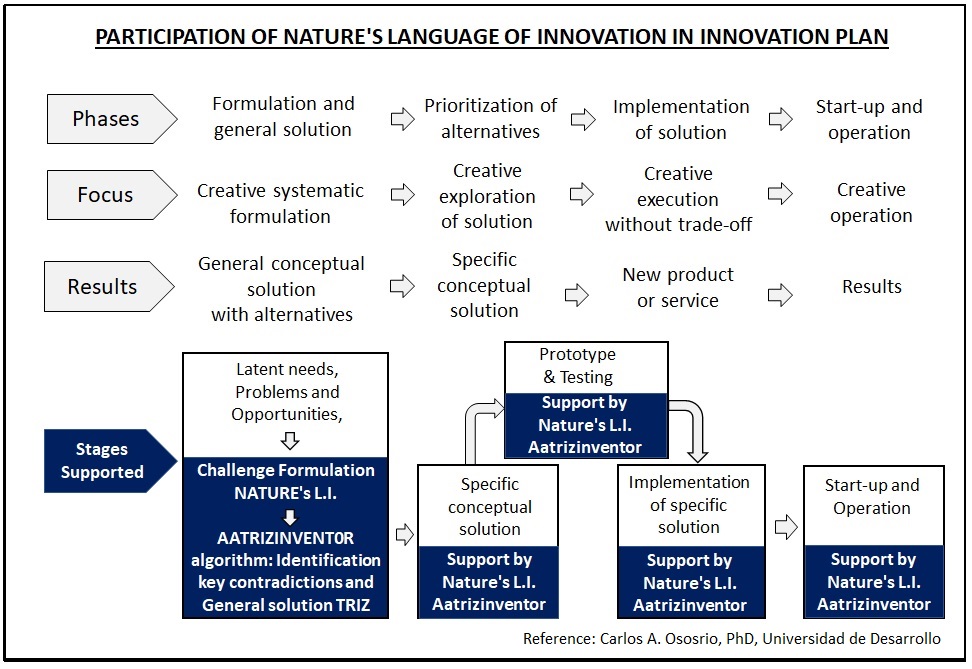
2.4 Postulates of Nature's L.I.
I. The Nature's language of innovation has existed in our nature since its inception. It is not the fruit of human intelligence nor is
it the exclusive privilege of special people. Nature innovates: 'We can all innovate'
II. The innovation process is evolutionary, it does not skip stages, since each one of them establishes the current undesirable effects and the
conditions to satisfy, which will determine the advance to the next stage, which in turn will condition the next one.
III. People and Innovation: 'those who know the problem can innovate'. The Innovation Language of
Nature establishes that the challenges of innovation must be formulated from the social and human context, where the needs to satisfy arise.
Formulating an innovation challenge is an art.
IV. The social and human context of a person is a field that reflects the feelings or emotions related to a need
unsatisfied, that is, how the problem feels. These perceptions are tabulated by TRIZ and are generically called
'innovation parameters', which will lead us to satisfy a need.
V. Nature's language of innovation proposes a general solution of minimum cost and maximum benefit / cost ratio, based on inventive principles, be
they strategic, tactical or operative. From this, the specific solution is a focused exercise of knowledge and skills, acquired or to be
discovered in the world. Reaching a solution according to your reality is a technique, just do it.
VI. You must always ask yourself what prevents you from satisfying the desired need. For human beings, undesirable effects to satisfy a need may be
based on current evidence, on the result of an imagined solution, or they appear from a condition imposed by oneself or by others for a desired
solution.
VII. The act of accepting these postulates is the beginning of a virtuous cycle of innovation.
2.5 Cases evaluated in Book 'The Nature's Language of Innovation, Amazon, Kindle '
"TECHNICAL CASES
1. Improve Robotized Starter Copper Sheet Stripping, Affected by Sheet Adhesion
"2. Improve Pile Driving, Affected by The Characteristics of The Sea Floor
"3. Improve Movement of an Animal Affected by Refusing to Walk
"4. Improve Delivering A Medicine to a Brain, affected by a Blood-Brain Barrier
"5. Conquest of Troy by The Greeks, affected by The Trojan Defensive Barrier
"6. Improving Long-Distance Oral Communication, Affected by Quality of Communication: Inventing the Telegraph
"7. Improving Telegraphic Communication, Affected by Telegraph Limitations: Inventing the Landline Phone
"8. Improving Landline Phone Communication, Affected by Receiver Distance: Inventing the Mobile Phone
"9. Improving Locking Pin Removal, Affected by Tightening Through Male-Female Parts - Ferry Estonia Sank In 1994.
"CASES OF HUMAN BEHAVIOR
"10. Giving a Speech, Affected by an Unwilling Audience
"11. Design the Best Children’s Toy, affected by the Designer’s Paradigms: Evaluated Object: DESIGNER
"12. Expressing Wishes for the Best Children’s Toy, Affected by Children’s Naturalness: Evaluated Object: CHILDREN
"CASES OF NATURE
"13. Improving the Survivability of Sea Squirt’s Larva, Affected by Lack of Food
"14. Improving Survival of Plant Cell – Original Animal Cell – Affected by Lack of Food (Energy) to Survival
"15. Improving Environmental Sustainability, Affected by Extreme Variations that Impact on Plant Cell
" ESSAY ON SCIENCE: THE AWAKENING OF PRE-UNIVERSE ACCORDING TO THE NATURE’S LANGUAGE OF INNOVATION
"16. Beginning of Attraction Force of an Energy Entity in the pre-Universe, Affected by Maximum Entropy:
" - a. Emergence of Gravity Force
" - b. The Birth of Time - First irreversible process
"17. The same solution as Birth of Time: Finding Miners Trapped by a Landslide at the San José Mine in Chile, 2010
"18. Improving Mass Accumulation in the Pre-Universe, Affected by Low Initial Attraction Capacity / Formation of a Black Hole
"19. Improving Stability of the Black Hole in the Pre-Universe, Affected by Extreme Internal Conditions: Creation of Universe - The Big Bang/ The Opening.

The Nature´s Language of Innovation', Amazon, Kindle, 2019
El Lenguaje de Innovación de la Naturaleza', Amazon, Kindle, 2020
The first requirement to solve an innovation challenge is to define the affected function. The affected function
is a perceived unwanted reality, which prevents taking advantage of an opportunity, satisfying a need, solving a problem, avoiding
damage, etc.

For the cases shown above, the following affected functions can be defined:
A. Service of hot coffee in plastic cup affected by burning Customer' hand".
B. Design of the best Lego toy for children affected by designer paradigms.
C. Improve Movement of an Animal Affected by Refusing to Walk.
D. Stable Ferry navigation affected by water entering the cargo space, due to breakage of the cargo space
door-visor locking pin.
To improve these affected functions, Nature's L.I. it solves them by evaluating pairs of objects that participate in the function.
Therefore, the next step will be to build the functional object diagram of the affected function, which we will see next.
Depending on
the number of objects involved, an affected sub-function may arise whose solution will allow to solve the main function.
The Functional Object Diagram is a key tool to clearly establish the objects involved in the innovation challenge.
From these and with the knowledge that must be had of the challenge or problem, the pair of objects that will be evaluated can be selected to
find a solution to the innovation challenge. Each pair of objects delivers a viable solution, but there is a pair of objects that delivers the
least-cost solution, and maximum benefit to cost ratio.
The functional diagrams of the cases seen in Topic 3 of the Manual are shown below.
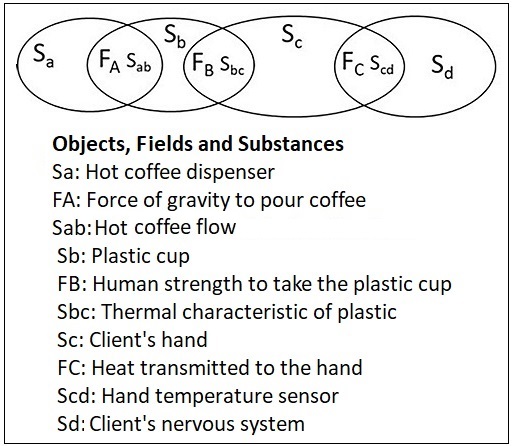
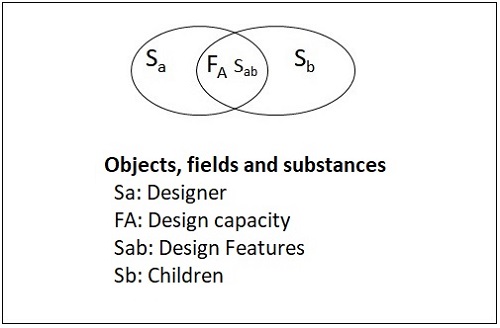

D. Stable ferry navigation affected when water enters to cargo space ,
due to breakage of the door-visor locking pin of space
loading
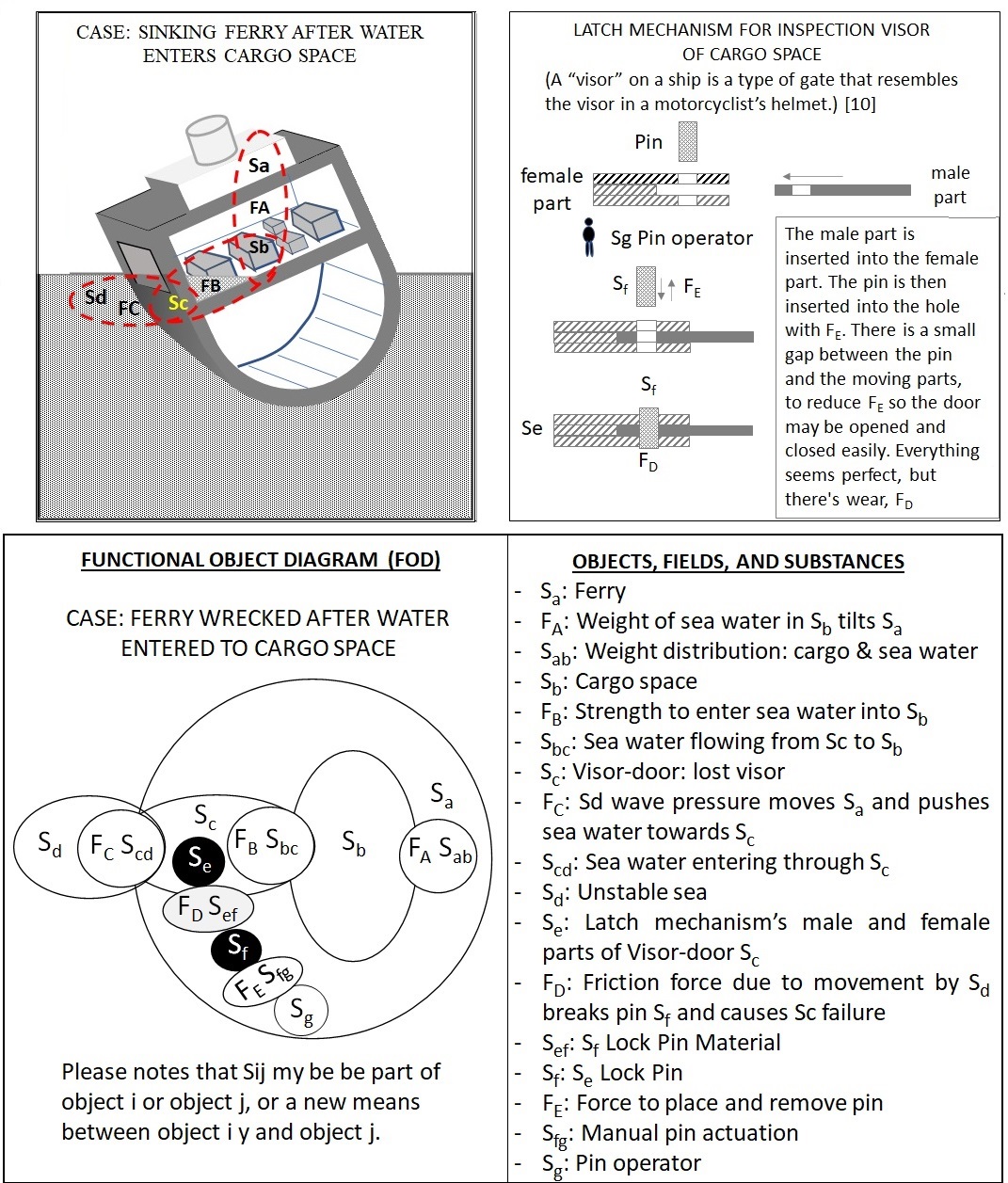
A Functional Object Diagram can be as detailed as required.
The next step will be to select the pair of objects in contradiction that will be evaluated, to formulate the problem or innovation challenge.
Deciding for a couple of objects is not simple, all the associated problems must be clearly available. For any pair
(j, k), it must be verified that there is evidence to formulate the innovation challenge, according to the following diagram:
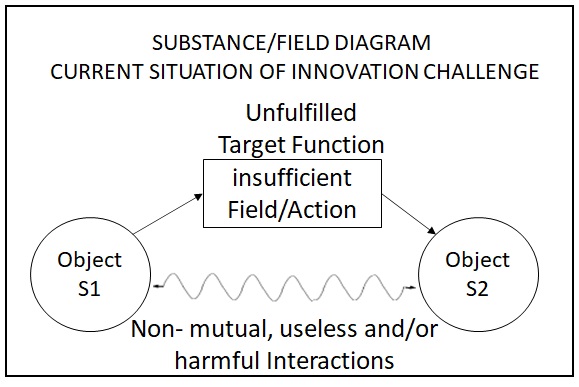
The selection of the pair of objects to evaluate is based on in-depth knowledge of the current situation. If you do not master what happens now
in your challenge of innovation, opportunity to achieve, need to satisfy, problem to solve or damage to avoid, then it is unlikely that you will be
able to formulate the challenge well and even less understand the solution proposed by Nature's L.I.
Remember, the current situation
determines the future situation and this time will condition the next one, marking a branch of innovation-evolution that advances until it reaches
a final development point, that is, there will be an innovation S curve in this branch.
If you want to jump to a new branch of development,
the most common thing that happens is that you must conceptually go back to the current branch of innovation-evolution and reformulate the challenge
in previous stages, where new knowledge, technologies and paradigm changes will allow a new formulation that opens new branches of innovation-evolution.
Finally, you can imagine or impose a desirable solution that seems impossible, see Topic 9 of this Manual, and evaluate the current pseudo-situation that this would mean. You will be surprised by the disruptive solutions you can get.
"Whatever formulation criteria are used, there will always come a time to select the pair of interacting objects to apply Nature's L.I. through its Aatrizinventor algorithm so that it can propose an effective, efficient and accurate solution.
The aforementioned aspects will lead you to recognize that: 'Formulating an innovation challenge is an art'.
It has been said before that any pair of objects identified in an innovation challenge provides a viable solution.
In practice it has been seen that the adjacent pairs in the Functional Object Diagram are the most effective. To exemplify this, the analyzes for
the cases shown in Topic 4 of the Manual are summarized below.
A. Service of hot coffee in plastic cup affected by burning the Customers' hand
Pairs of objects:
[Dispenser] [plastic cup]
You might think of delivering coffee that is not so hot, but many customers like their coffee
extremely hot, the solution is not there
[Plastic cup] [Customers]
Here is a question
that should be evaluated: can you drink hot coffee without burning your hand?
[Customer's hand] [Nervous System]
" Here is a natural alert system that the Customers cannot control.
After analyzing three pairs of objects, we have discarded two and
left one to evaluate: [Plastic cup ( with hot coffee)] [Customers (Customer + Nervous System].
B. Design of the best Lego toy for children affected by designer paradigms
" This is a special challenge, at the 31st International Conference of “TOC Practitioners Alliance - TOCPA”, held in March 2017 in Helsinki, Finland,
Jürgen Kanz spoke on the concepts of 'time problems' and 'cloud problems'. To explain them he used the Legos game, saying that building the tallest
tower in the world with Legos is a problem of time, that is, it only takes time to meet this challenge. While building the best Lego toy for children
is a cloud problem, that is, there is no certainty of what should be done, what do the children want? What does the designer think? Time is
undetermined. In the book 'The Language of Innovation of Nature' the solution of this cloud problem shown here is developed, where the solution is
not a certain toy design, but the process that must be followed to design the best toy, defining what the designer should contribute and what
children.
For this case we have:
Pairs of objects:
[Designer] [children]
This is human behavior soft variables challenge that Nature's L.I. also helps to solve.
C. Movement of an animal affected by refusing to walk
Here the challenge is quite simple, there are two objects in contradiction.
Object pairs:
[Person who pulls animal] [Animal]
Is there a way to move the animal without using so much force?
D. Stable ferry navigation affected by water entering the cargo space, due to breakage of the Door-Visor locking pin
The case of the sinking of the Ferry is more complex. The pairs of adjacent objects identified are analyzed below.
Pairs of objects:
[Cargo space] [Ferry]
The water enters the cargo space, destabilizes the Ferry and it capsizes. For this reason, 892
people died due to the sinking of the Estonian Ferry in the Mediterranean in 1994. A first challenge appears. How to prevent the entry of water into
the cargo space from causing instability to the Ferry?
[Door-Visor] [Cargo space]
Now the challenge is how to
prevent water from entering the cargo space in the event of a Door-Visor failure?
[Door-Visor locking Pin] [Male-female parts of
Door-Visor]
In this instance, the aim is to prevent the Pin from breaking due to wear caused by the interaction with the
male-female parts, allowing water to enter the cargo space of the Ferry.
.[Door-Visor Locking Pin Operator] [Door-Visor Locking Pin].
It is unlikely that the Operator will take actions to control locking pin wear, since the possibility of wear is accepted by the design compromise, or
engineering trade-off.
[Unstable sea] [Door-Visor]
Finally, we could evaluate: How to avoid that the unstable sea reaches the Door-Visor and thus it is not possible for water to leak into the Ferry ?.
All the questions asked are valid. Each pair of objects is associated with undesirable effects that affect directly or
indirectly and their particular solution will improve the main function affected: if any of these questions is solved, the Ferry will not overturn.
As you can see, finding the optimal solution is a great challenge for the Innovation Team or problem solver.
In the reviewed literature I have found the development of two solutions for the case of the Ferry:
" The first is related to the Cargo space and Ferry objects, proposing a solution to cover the empty cargo spaces with air bags or foam when water ingress is detected, to prevent the water from occupying space, with the risk of destabilizing the Ferry. It is a solution within the current Ferry design
paradigm, it is not optimal, but it is viable. This pair of objects will be evaluated to validate said solution.
The second is related to the Locking Pin and Male-Female Parts objects of the Door-Visor. Here the design compromise of the current solution is rejected, which leaves a gap between these components to avoid locking between them. This compromise unfortunately allowed for friction between
the components causing the locking pin to be cut, which left the door-visor open. Due to severe weather, this opening allowed water to enter the cargo space, which destabilized the Ferry, causing it to capsize with the human losses mentioned for the Estonia Ferry. "."
"." To avoid design compromise it is necessary to step back and return to the design engineer's original challenge, evaluating this pair of objects with the following challenge: 'How to design a locking pin adjusted to the male-female parts, without gaps, which is easy to insert and remove'. A solution to this was patented in the 1990s (yes, in the last decade of the 20th century, not the 19th century). We will see this solution later in topic 15, applying Nature's Language of Innovation and its Aatrizinventor algorithm to obtain it.
Once the objects in contradiction have been selected to solve the affected function, the next step is to decide the Object S1 on which the evaluation will focus and the recommendations of the solution will be applied,
either in own changes or in the interaction with Object S2. In Topic 6 of the Manual, recommendations are given to be applied to establish Object
S1.
First, when selecting a pair of objects to evaluate, be Sa and Sb, it is necessary to understand what kind of relationship
they have, according to the following two possibilities.
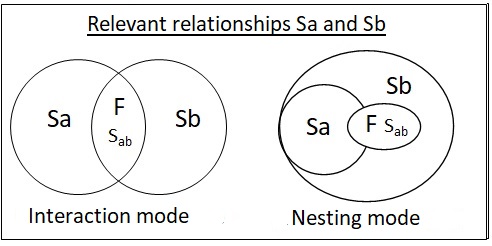
The next step is to identify the Master Object that dominates the action and the Slave Object that receives the action.
Next, it is determined which of the two objects contributes more verifiable effects of the current situation, which affects the function
under evaluation. A third criterion is to determine which of the two objects is expected to have a more meaningful change.
"With these antecedents, the Object S1 to be evaluated is selected, which is considered most appropriate.
Finally, it must be defined
whether Object S1 is moving or stationary. A moving object is understood to be one that
can be moved, or is desired to move, relative to Object S2. An object is stationary if it maintains a fixed position in relation to Object S2,
whatever actions are executed in the current or future situation. Object S2 is defined with the same criteria.
If you are not satisfied
with the results obtained with object evaluated, do not hesitate and evaluate as Object S1 the object S2 not considered initially."
The S1 Objects applied for the cases shown above are the following:
A. Service of hot coffee in plastic cup affected by burning the Customers' hand
OBJECT S1: Plastic cup (with hot coffee), Moving object (with respect to Customers)
OBJECT S2: Customers (Customer's Hand + Nervous System), Moving Object (with respect to Plastic Cup)
B. Design of the best Lego toy for children affected by the Designer's Paradigms
OBJECT S1: Designer, Moving Object (with respect to Children)
OBJECT S2: Children, Moving Object (with respect to Designer)
C. Movement of an animal affected by refusing to walk
OBJECT S1: Person who pulls animal, Moving Object (with respect to Animal)
OBJECT S2: Animal, Moving Object (with respect to Person)
D. Stable Ferry navigation affected by water entering the cargo space, due to breakage of the door-visor locking pin
D1. Cargo space weight balance affected by water ingress
OBJECT S1: Cargo space, Stationary Object (with respect to Ferry)
OBJECT S2: Ferry, Stationary Object (with respect to Cargo Space)
D2. Removal of the door-visor locking pin, affected by jamming with male-female parts
OBJECT S1: Door-Visor Locking Pin, Moving Object (with respect to Male-female Parts)
OBJECT S2: Male-female parts of Door-Visor, Moving Object (with respect to Locking Pin)
Once the objects S1 and S2 to evaluate have been defined, the next step will be to identify the undesirable effects that determine the problem or
innovation challenge under study, which will be seen from Topic 7 below.
The concept of innovation that Nature's L.I. is summarized in the Multivariable Modified Evaporation Cloud, hereinafter
MMEC Diagram . The MMEC diagram is an extension of the evaporation cloud that is used in the TOC Theory
of Constraints, which here applies to two interacting objects, performing the analysis from the perspective of one of them, which has a need to
satisfy and even four causes of dissatisfaction. MMEC describes an objective to be fulfilled for the object being evaluated, expressed as
Action Verb (e.g., Improve) + Function Affected (e.g., activity or process operation affected by undesirable effects).
The genesis of the problem or challenge is as follows: There is a physical variable or characteristic in physical contradiction, that is,
for a given state it causes undesirable effects (less safety), which are associated with updated TRIZ innovation parameters, which make it difficult to
meet the desired objective, On the other hand, this same physical variable or characteristic, in the same previous state, or in a
different state, causes a desirable effect (more security), which allows meeting a need to satisfy, which is associated with one of the
10 parameters of TRIZ innovation of needs to satisfy, defined by Nature's LI, which facilitates meeting the desired objective. This
formulation of the problem or innovation challenge with up to 5 TRIZ innovation parameters can generate up to 20 technical contradictions, whose solution
recommendation, based on the updated TRIZ inventive principles and prioritized using the Aatrizinventor algorithm, solves the problem
or finds a solution by formulated innovation challenge. The following is an MMEC diagram, with its component parts, which are described
later.
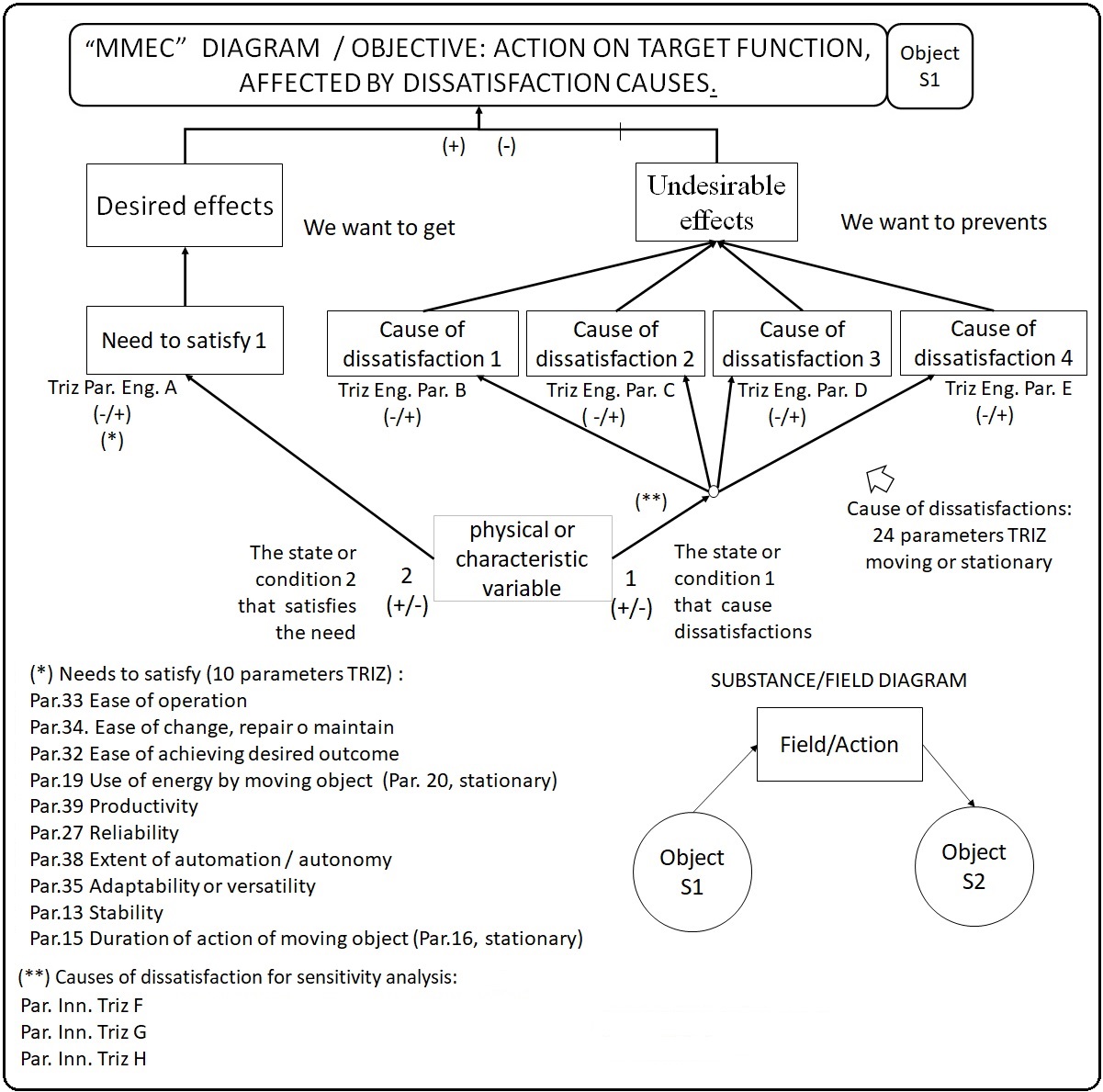 >
>The MMEC Diagram for the 5 cases to evaluate, indicated in Topic 6 of the Manual, are shown in Topic 11 of the Manual.
The MMEC Diagram considers the following aspects:
- OBJECT S1
Corresponds to the Object that has been selected to evaluate when it interacts with an Object S2, to execute a function affected by
undesirable effects that limit a need to satisfy desired. The Objects S1 for the cases that have been presented before are indicated below.
OBJECT S1 : Plastic cup (with hot coffee), Moving object (with respect to Customers' hand)
OBJECT S1 : Designer, Moving Object (with respect to Children)
OBJECT S1 : Person who pulls animal, Moving Object (with respect to Animal)
OBJECT S1 : Cargo space, Stationary Object (with respect to Ferry)
OBJECT S1 : Door-Visor Locking Pin, Moving Object (with respect to Male-female Parts)
- ACTION VERB + FUNCTION OBJECTIVE AFFECTED BY CAUSES OF DISSATISFACTION
Corresponds to the Goal of the innovation challenge, expressed as:
"Action verb, represents what you want to achieve in the innovation challenge for the affected function: Improve, Increase,
Eliminate, etc.
"Function affected by causes of dissatisfaction, corresponds to the function executed by objects S1 and S2 in the
innovation challenge, which has difficulty in meeting the expected result, due to undesirable effects causes of dissatisfaction.
For the cases presented there are the following combinations of Action Verb + Function Affected by:
OBJETIVO A. Improve Service of Hot Coffee in Plastic Cup affected by burning the Customers' hands
OBJETIVO B. Design the best Lego toy for children affected by paradigms of the Designer
OBJETIVO C. Improve movement of an animal affected by refusing to walk
OBJETIVO D1. Ensure stable navigation of the Estonian Ferry affected by water ingress into the cargo space, due to the breakage of the door-Visor
locking pin
OBJETIVO D2. Improve Removal of the Door-Visor locking pin, affected by jamming with male-female parts
- UNDESIRABLE EFFECTS CAUSES OF DISSATISFACTION (UDEs)
Corresponds to the identification of the undesirable effects causes of dissatisfaction, up to 4 to evaluate each time and 3 more
for sensitivity analysis. Each of these identified effects are associated with the corresponding TRIZ innovation parameters. It is declared that
these undesirable effects / parameters make it difficult to fulfill the objective of the affected function evaluated.
The methodology to determine the undesirable effects causes of dissatisfaction is indicated in Topic 8 of the Manual.
- PHYSICAL OR CHARACTERISTIC VARIABLE (PCV) DETERMINING A PHYSICAL CONTRADICTION
Corresponds to a physical variable, characteristic, requirement, property, or behavior, of Object S1, which in a given state
causes the undesirable effects that cause dissatisfaction. In the same or different state, it causes the desirable effect for a need to satisfy.
This variable does not participate in the TRIZ Matrix of Contradictions, but it is key to the logical formulation of the innovation challenge. It
is the root concept that relates the undesirable effects with the desirable effect, which determine the existing physical contradiction in the
innovation challenge. The possible states of this variable generate technical contradictions between TRIZ innovation parameters, which must be
solved to reach the desired solution.
Recommendations to determine this physical variable, or characteristic are indicated in Topic 9 of the Manual.
- DESIRABLE EFFECTS CAUSE OF SATISFACTION (DE)
It corresponds to the identification of a single desirable effect, to be evaluated independently of the other
desirable effects that can be applied, as proposed by the morphological analysis. For Nature's L.I., this selected desirable effect
represents a need to satisfy, associated with one of the 10 TRIZ innovation parameters for defined needs to satisfy, which allows it
to be entered into the Aatrizinventor innovation solutions algorithm. To find a solution, the need to satisfy selected will be
considered, in a preliminary way, independent of the other needs defined by Nature's L.I., temporarily suspending their relationships.
Once a solution has been reached, the contradictions between the evaluated need and the other needs will be reviewed, in order
to ensure that the satisfaction of the evaluated need does not affect the others.
The recommendations to select the need to satisfy to evaluate are indicated in Topic 10 of this Manual.
With this last definition, the process of formulating the innovation challenge is completed, which allows creating the corresponding
mental map. The MMEC Diagrams of the cases indicated in Topic 6 are shown in Topic 11, both of the Manual.
To determine the undesirable effects causes of dissatisfaction for Object S1 and to be able to relate them to the TRIZ
Innovation Parameters, the following must be met, at least:
- You must be familiar with the descriptions of the innovation parameters and their physical or figurative interpretation. A good practice is to
study the cases presented in this Manual and keep cases already evaluated by you to review them and see if there are similarities with new cases.
Descriptions can be seen above in the link 'Innovation Parameters'
" - The analysis for Object S1 must be conducted considering the mutual function that they perform or that relates to objects S1 and S2, selected from the created FOD diagram.".
- You must define the space-time in which the evaluation of Object S1 is conducted. In the space-time that is defined it must be fulfilled that
for two undesirable effects in contradiction, if an effect 1 has a change, effect 2 must change always in the same sense. For example, if the daily
performance of a photoelectric cell is evaluated, there will be at least 2 space-time to evaluate, 1) the place where it is located and the daily
hours when the sun rises increasing its emission and 2) the place in those hours that the emission decreases until it disappears.
"It can be said that the innovation process is focused and discrete, for example, in periods, phases, stages or sectors. Innovation techniques that
use brainstorming, collect a salad of workable solutions in different space-time, where it prevails the intuition, the experiences or
paradigms of those who participate in the generation of ideas, which cause a lot of sorting and selection work with uncertain results, compared to
a systematic analysis methodology that uses the world's solutions.
- Only the effects that there is known evidence in the current situation that affect Object S1 evaluated, when it interacts with Object S2,
should be considered. That's enough, you don't need a complex root cause analysis for every object you decide to include in the FOD diagram.
The effects with evidence are correlated with the TRIZ innovation parameters, which allow, based on the contradictions generated, to obtain a
solution of minimum cost and maximum benefit/cost ratio.
Remember : 'The current situation determines the future
situation and this in turn will condition the following'.
If the current situation leads you to a future situation that does not satisfy you, then go back to previous conditions of the evaluated challenge,
which will open new paths of innovation. See the case of the sinking of the Ferry due to the breakage of the door-visor locking pin.
Nature's L.I. with its proposal of universal, TRIZ-based innovation parameters and inventive principles, together with the knowledge of the undesirable effects of the evaluated Object S1, it guides you to find the essential cause of dissatisfaction to realize the innovation you need. As an example, the case of the sinking of the Estonia Ferry in the Mediterranean Sea in 1994, which caused 852 deaths, is being developed in this Manual. The reported root cause was the breakage of the locking pin of a Door-Visor, which, being left open, allowed water to enter the cargo space of the Ferry, causing it to capsize. The essential cause was not the material of the pin, nor the friction between the pin and the male-female parts, nor the relative displacement between these parts due to the movement of the Ferry in an unstable sea. The essential cause was the cylindrical shape design of the pin, conditioned by design trade-off. In the 1990's a tapered pin was patented that solved the problem. No one had thought of it for over 100 years. In Topic 15 of this Manual, it is shown as Nature's L.I. systematically arrives at this solution.
"Nature 'knows': for the same problem, the same solution. The TRIZ Contradiction Matrix contains the world's solutions and Nature's L.I. Nature's
solutions declare them. Nature's L.I., with its Aatrizinventor algorithm, offers to solve multivariable innovation problems and challenges with speed
and focus.
Based on the above, the identification of undesirable effects causes of dissatisfaction is a well-defined exercise, which can be summarized by
completing one of the following tables for Object S1, for moving or stationary object, each with 24 TRIZ innovation parameters that will be related
to the undesirable effects causes of dissatisfaction.
The AATRIZINVENTOR algorithm allows to simultaneously evaluate up to 7 undesirable
effects expressed as innovation parameters.
TABLE A FOR DETERMINATION OF UNDESIRABLE EFFECTS FOR MOVING OBJECT

TABLE B FOR DETERMINATION OF UNDESIRABLE EFFECTS FOR STATIONARY OBJECT

Method of Identification of undesirable effects causes of dissatisfaction of Object S1 when interacting with Object S2:
General considerations
This is a fundamental stage to solve an innovation challenge, so I like to say that the formulation of the innovation challenge is an art, based on
a deep knowledge of the current situation evaluated. In contrast to the cause-effect or fishbone diagrams, here what prevails is the capacity for
synthesis and relational analysis to identify the undesirable effects that cause dissatisfaction and the corresponding TRIZ innovation parameters,
which determine the difficulty in achieving the desired objective.
A first decision is to make a preliminary definition of the space-time to be evaluated. The review of the undesirable effects that are identified
will allow to ratify or correct that initial decision. In the period and space analyzed, the variables associated with the effects that are
identified must change in one direction only, from less to more or from more to less. If a variable associated with an object under evaluation shows
a sustained increase in a certain time and then permanently decreases in another period, then the chosen space-time must be divided by time. If an
evaluated object works in a certain space exposed to certain conditions and then changes to another space where the conditions change, then the
space-time must be divided by space. ".
In relation to TRIZ innovation parameters, Nature's Innovation Language uses the original 39 TRIZ engineering parameters established by H.
Altshuller, the creator of TRIZ. Some of them have been given a more universal name and description, to address any challenge in nature and areas
of human development.
Recommendations to identify undesirable effects
To support this stage, eight categories of legitimate reservation are described below, emerging in the world of TOC applications and assimilated to Nature's L.I. (reference: 'Vector Consulting Group, “Categories of Legitimate Reservation- CLR'), which help to identify the undesirable effects that cause dissatisfaction and their corresponding associated TRIZ innovation parameters:
1. Clarity: complete understanding of the identified undesirable effect causing dissatisfaction should be checked to avoid ambiguous wording.
Therefore, it must be ensured that everyone fully understands it, including those who were not involved in the initial formulation of the innovation challenge.
2. Existence of the entity: The reality or existence of the undesirable effect that causes dissatisfaction stated must be verified, within the
reality of the innovation challenge analyzed. Assumptions, which are not proven realities, should be avoided.
3. Causality: The question 'Does the undesirable effect causing dissatisfaction really to lead to a difficulty in achieving the desired objective?'
Then it is important to read the relation aloud, for example: 'If A exists, then B exists' or 'To have B, we must have A'. A should be understood
as the undesirable effect that causes dissatisfaction, associated with a TRIZ innovation parameter, and by B the difficulty of achieving the desired
objective for the innovation challenge.
4. Sufficient Cause: Look for all the undesirable causes of dissatisfaction that are sufficient by themselves to create a difficulty in achieving
the desired goal. In a pair of complex system objects, there may be independent causes (logical OR) or dependent causes (logical AND) that combine
to generate the indicated difficulty. All causes, independent or dependent, must be identified to relate
with the corresponding TRIZ innovation parameters. If a legitimate cause remains hidden or unknown, you may be able to obtain a solution, but it
may not always prevent such a cause from occurring a difficulty in achieving the desired objective. Therefore, it is important to identify all
causes. On the other hand, you can also accept an undesirable effect and not include it in the evaluation, which means that the solution is allowed
this degree of freedom. The latter can simplify the solution to an acceptable level. This decision is not easy, it depends a lot on the complete
knowledge of the problem. As a dear teacher of mine used to say, speaking to us of simplifying an analysis: 'when you throw the water out of the
bathtub, make sure that you took the baby out'.
5. Additional Cause: Check that no other cause, not mentioned so far, could create the same difficulty in achieving the desired objective.
6. Cause-effect reversal: check for any confusion between cause and difficulty in achieving desired goal. Use category 3, as many times as
necessary.
7. Effect prediction: For a given TRIZ innovation parameter, assume a verifiable (additional) undesirable effect. If with this effect, there
appears a difficulty to achieve the desired objective, then the undesirable effect causing dissatisfaction exists. If the difficulty is not verified,
the assumed effect is invalid.
"8. Tautology or circular logic: Check if the declared difficulty is sufficient proof or justification that proves the existence of the undesirable
effect. This happens especially when the cause is intangible: I had high hopes (ambiguous need) that there was pleasant weather (not a current
undesirable effect) or the weather was good (ambiguous desirable effect), because I was expecting it a lot (ambiguous need). Both do not clearly
express the unmet desired goal and their current undesirable effects causes of dissatisfaction.
There are cases where there is an innovation parameter with a potential undesirable effect, one of the 24 to be reviewed, which is actually
presenting an important desirable effect, which we want to keep, and which could be affected by resolving the other undesirable effects to be
evaluated. It is recommended to include it in the evaluation together with the undesirable effects that are also identified as causes of
dissatisfaction, avoiding those solutions that may attenuate it.
"An important aspect is that the evaluation for Object S1 must be done in a certain time and space where the undesirable effects causes of
dissatisfaction are present and maintain the identified state or condition that generates the difficulty to achieve the desired objective. For
example, if a period of time is analyzed where a variable has changes that do not maintain a certain correlation with other variables, time and
space must be limited, or two different challenges must be formulated.
"Finally, it is necessary to recognize that the formulation of an innovation challenge, or solution of a problem, is dynamic and is strongly subject
to knowledge of the current situation. We must free ourselves from the rigidity of operational thinking, which prevents us from opening up to new
scenarios, and not trust to the utmost in our 'common sense' that could be biased. The tables shown below did not arise from the first selection,
there is a process of analysis and decision of the parameters to be applied, which requires a precise review of each of them on the impact they have
on the current situation. It must be validated that there is evidence of an undesirable effect, sustained in the time and space evaluated, with a
significant magnitude. Still, with that rigor, it will sometimes be nature, through Nature's L.I. in this case, the one that will teach us which
TRIZ innovation parameter is most important for a certain challenge, which implies the need to evaluate when there is a minimal basis or reasonable
doubt about the impact of a certain parameter, to include it or not consider it.
Fortunately, the Nature's language of innovation is homogeneous, simple and generous, it always offers you a viable solution, which can be optimized
in a next step. My first experience with the TRIZ Matrix of Contradictions that contains 1248 contradictions was in a 6 million dollar Robotized
Starter Copper Sheet Stripping Project, where with a manual review of this universe of contradictions, it allowed us to find a contradiction that gave speed and focus to the solution of a start-up problem, recommending the Contractor to include the concepts that we had extracted from TRIZ, which with its technical skills achieved a successful implementation. Time would show that the manual method used works, but sometimes it becomes slow, cumbersome and confusing. A systematic way was required to address innovation challenges, to ensure speed and focus in finding solutions. This is the origin of Nature's L.I.
Below are tables to identify undesirable effects causes of dissatisfaction for the 5 cases presented in Topic 6 of the Manual. A minimum of 2
undesirable effects and a maximum of 7 must be identified.
A. IMPROVE SERVICE OF HOT COFFEE IN PLASTIC CUP AFFECTED BY BURNING THE CUSTOMERS' HAND
Evaluated space-time:
space: Place where hot coffee is served in a plastic cup and there is the Customer who wants to consume it.
Time: Period that elapses between the moment the plastic cup with hot coffee is left available for the Customer to lift with his hand and the moment
the Customer returns it to the place where it was when he feels his hand burning.
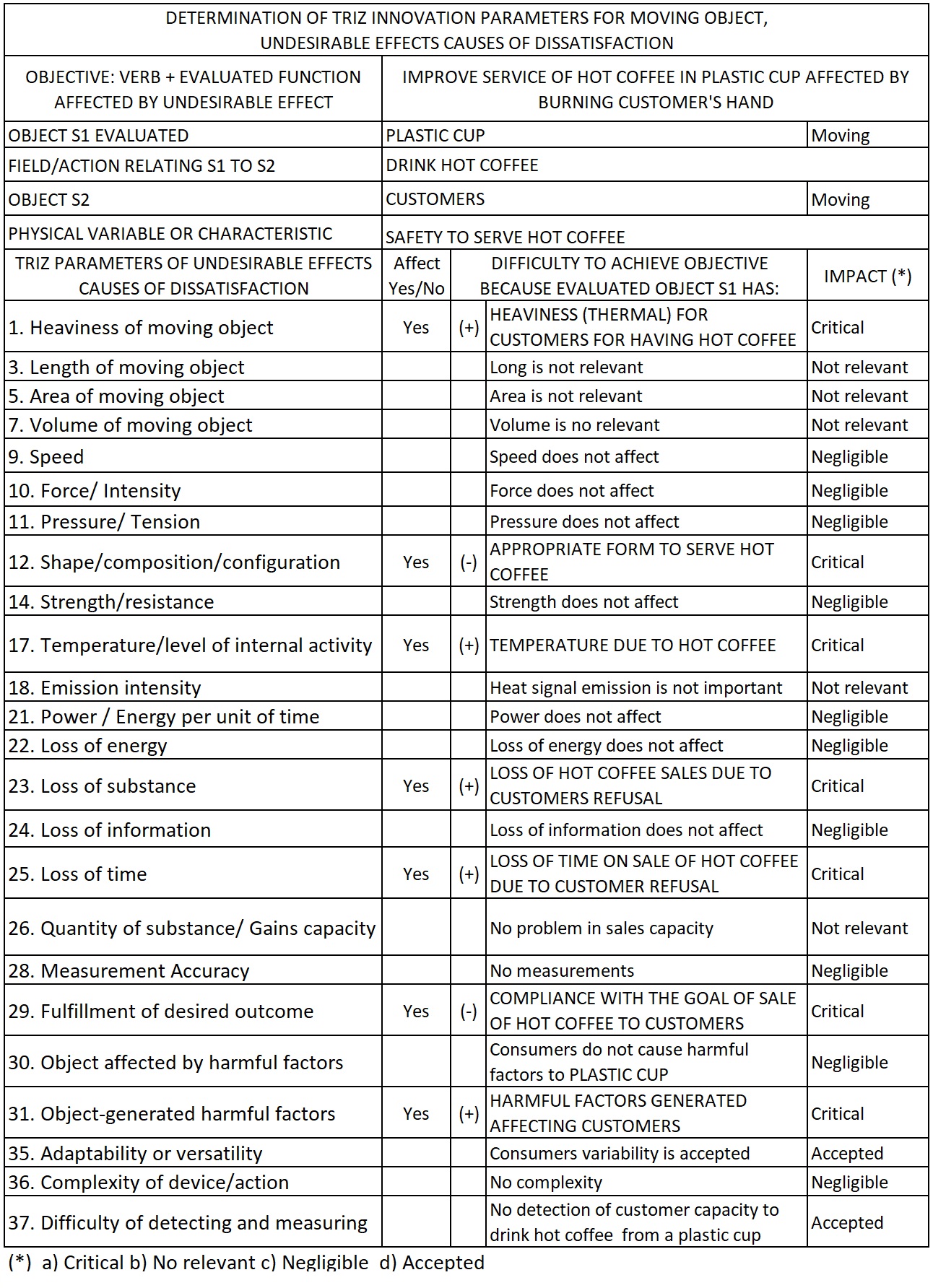
Once the undesirable effects have been determined, the next step is to define the up to 4 effects to be evaluated, selected from the up
to 7 effects selected in the previous review. Together, you must decide which need to satisfy you want to evaluate, of the 10 defined by
Nature's LI, according to the criteria indicated in Topic 10 of this Manual.
The selection that you will make will be based
on in the deep knowledge of the current situation: real, 'imagined' or 'imposed' (see Topic 9 below), where you will express your best
expectations to solve the problem or innovation challenge in evaluation.
Below is a form where the information prepared is
summarized.

The table above contains the information that will be entered into the Aatrizinventor algorithm. Remember that the algorithm will
recommend alternative combinations based on the sensitivity analysis it performs, which you must decide whether to evaluate them.
B. DESIGN THE BEST LEGO TOY FOR CHILDREN AFFECTED BY DESIGNER'S PARADIGMS
Evaluated space-time:
Space: A place where the designer creates a new toy for children, plus a place where children reject it, because it is not to their liking
Time: Period that elapses between the moment the designer starts creating a new toy for children until the moment they reject it.
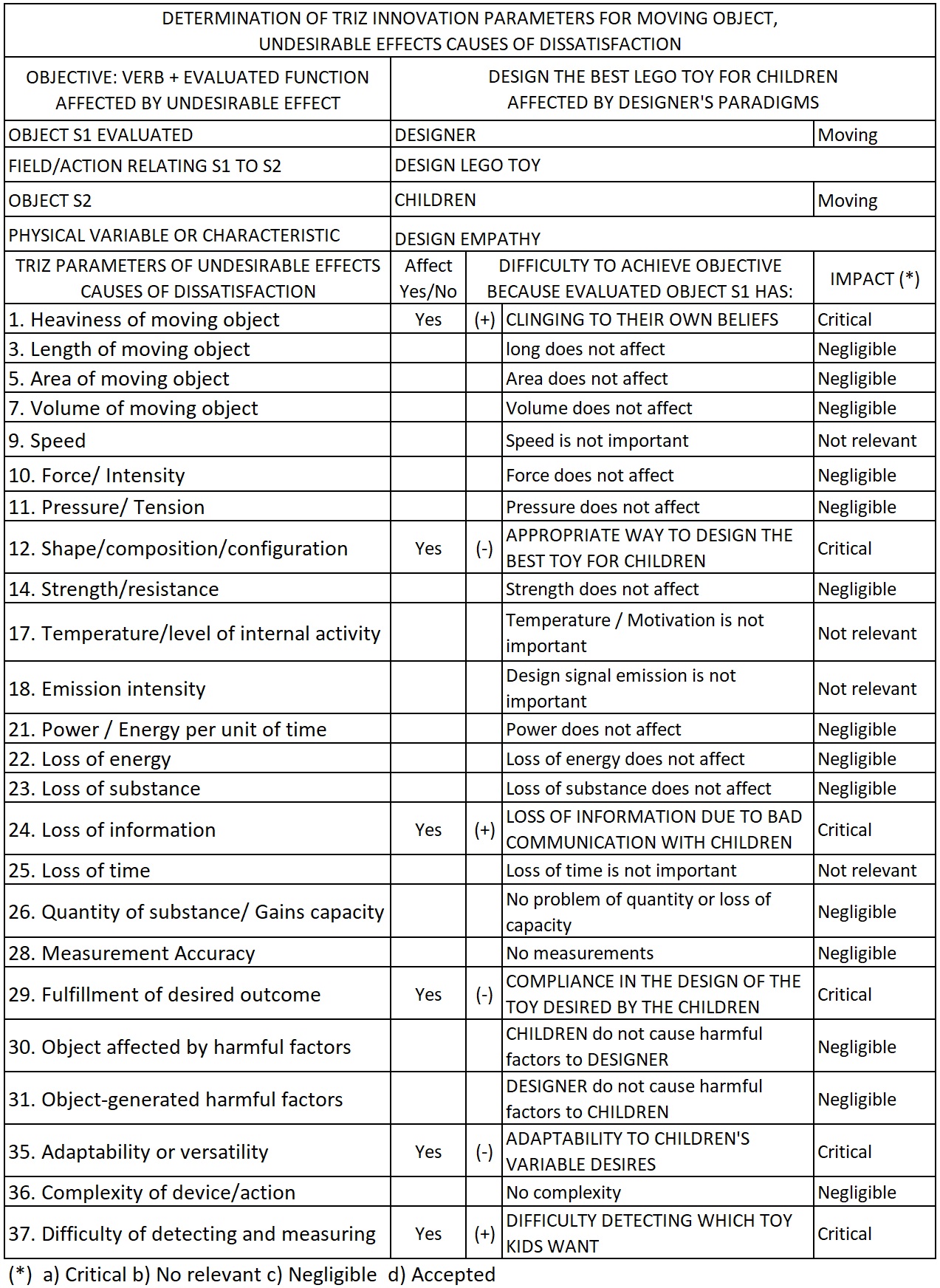
Once the undesirable effects have been determined, the next step is to define the up to 4 effects to be evaluated, selected from the up
to 7 effects selected in the previous review. Together, you must decide which need to satisfy you want to evaluate, of the 10 defined by
Nature's LI, according to the criteria indicated in Topic 10 of this Manual.
The selection that you will make will be based
on in the deep knowledge of the current situation: real, 'imagined' or 'imposed' (see Topic 9 below), where you will express your best
expectations to solve the problem or innovation challenge in evaluation. "."
". Below is a form where the information prepared is
summarized.
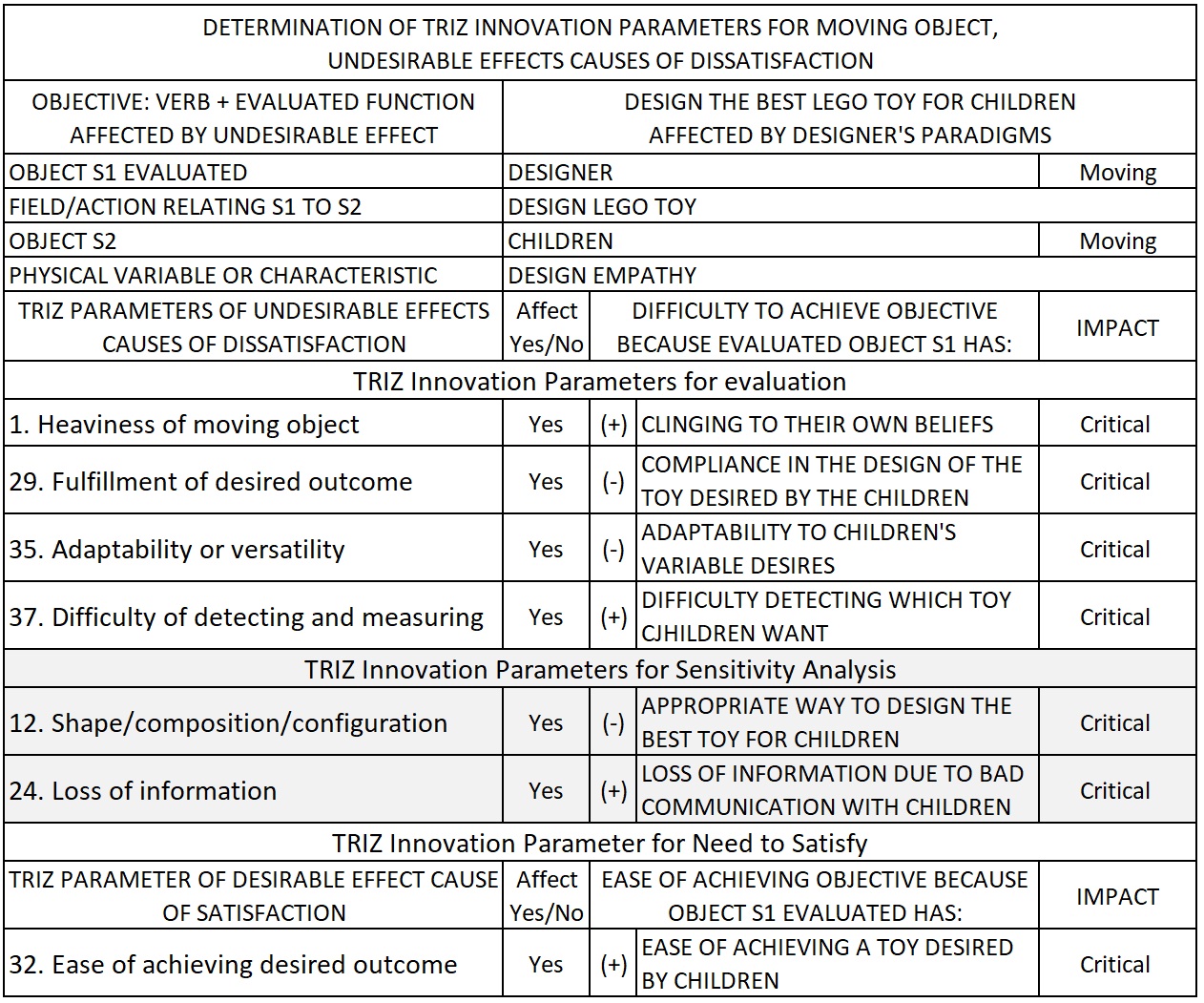
The table above contains the information that will be entered into the Aatrizinventor algorithm. Remember that the algorithm will
recommend alternative combinations based on the sensitivity analysis it performs, which you must decide whether to evaluate them.
C. IMPROVE MOVEMENT OF AN ANIMAL AFFECTED BY REFUSING TO WALK
Evaluated space-time:
Space: Place where a person pulls an animal to walk, manages to move it little, and finally runs out without achieving its goal.
Time: Period that elapses between the moment in which the person begins to pull the animal until the moment in which it surrenders without making
it walk continuously.
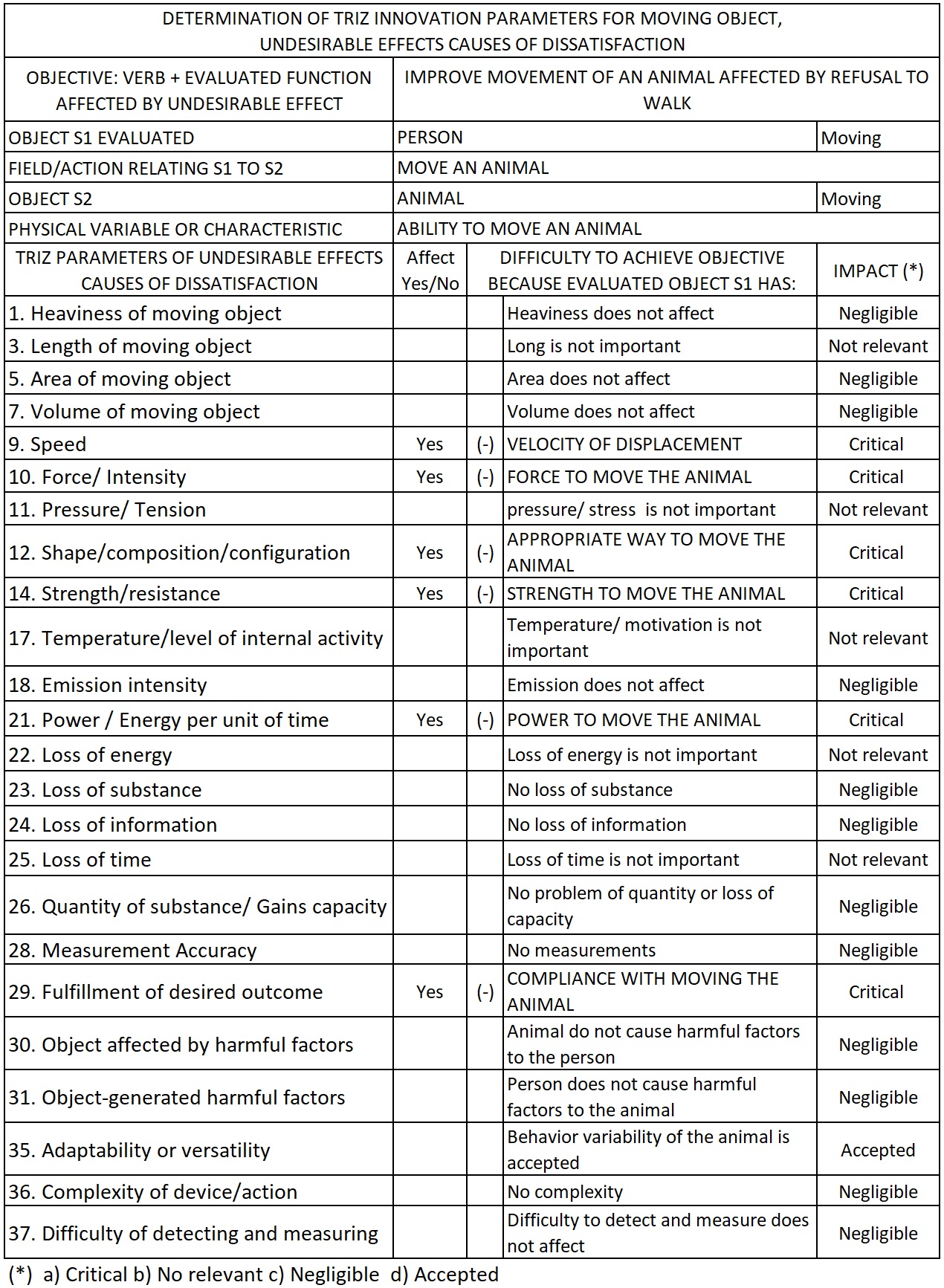
Once the undesirable effects have been determined, the next step is to define the up to 4 effects to be evaluated, selected from the up
to 7 effects selected in the previous review. Together, you must decide which need to satisfy you want to evaluate, of the 10 defined by
Nature's LI, according to the criteria indicated in Topic 10 of this Manual.
The selection that you will make will be based
on in the deep knowledge of the current situation: real, 'imagined' or 'imposed' (see Topic 9 below), where you will express your best
expectations to solve the problem or innovation challenge in evaluation.
Below is a form where the information prepared is
summarized.
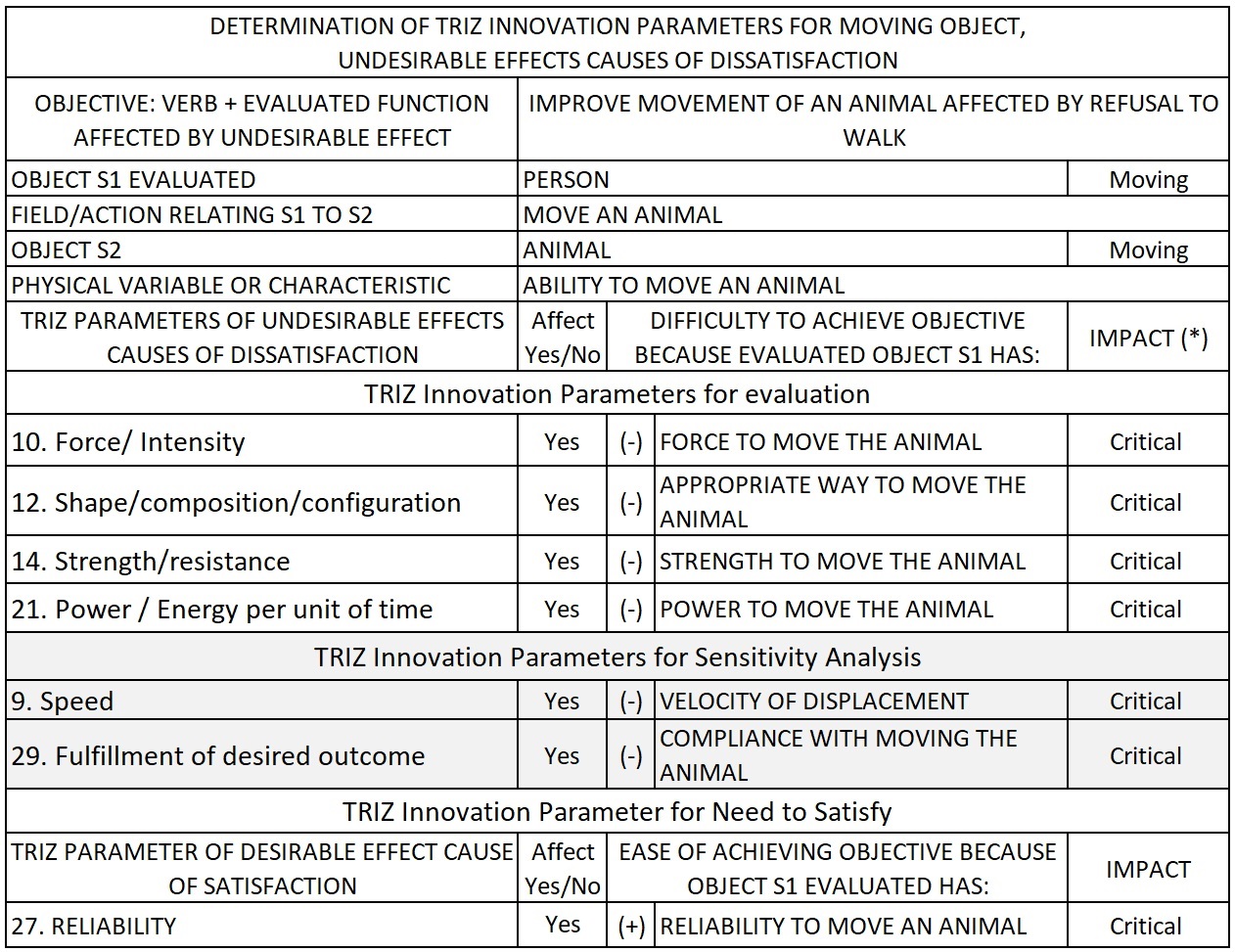
The table above contains the information that will be entered into the Aatrizinventor algorithm. Remember that the algorithm will
recommend alternative combinations based on the sensitivity analysis it performs, which you must decide whether to evaluate them.
D.1 ENSURE STABLE FERRY NAVIGATION AFFECTED WHEN WATER ENTERS CARGO SPACE
Evaluated space-time:
Space: Place occupied by cargo space affected by ingress of water that destabilizes Ferry and capsizes it.
Time: Period that elapses between the moment when the water enters the cargo space and destabilizes it until the moment the Ferry capsizes.
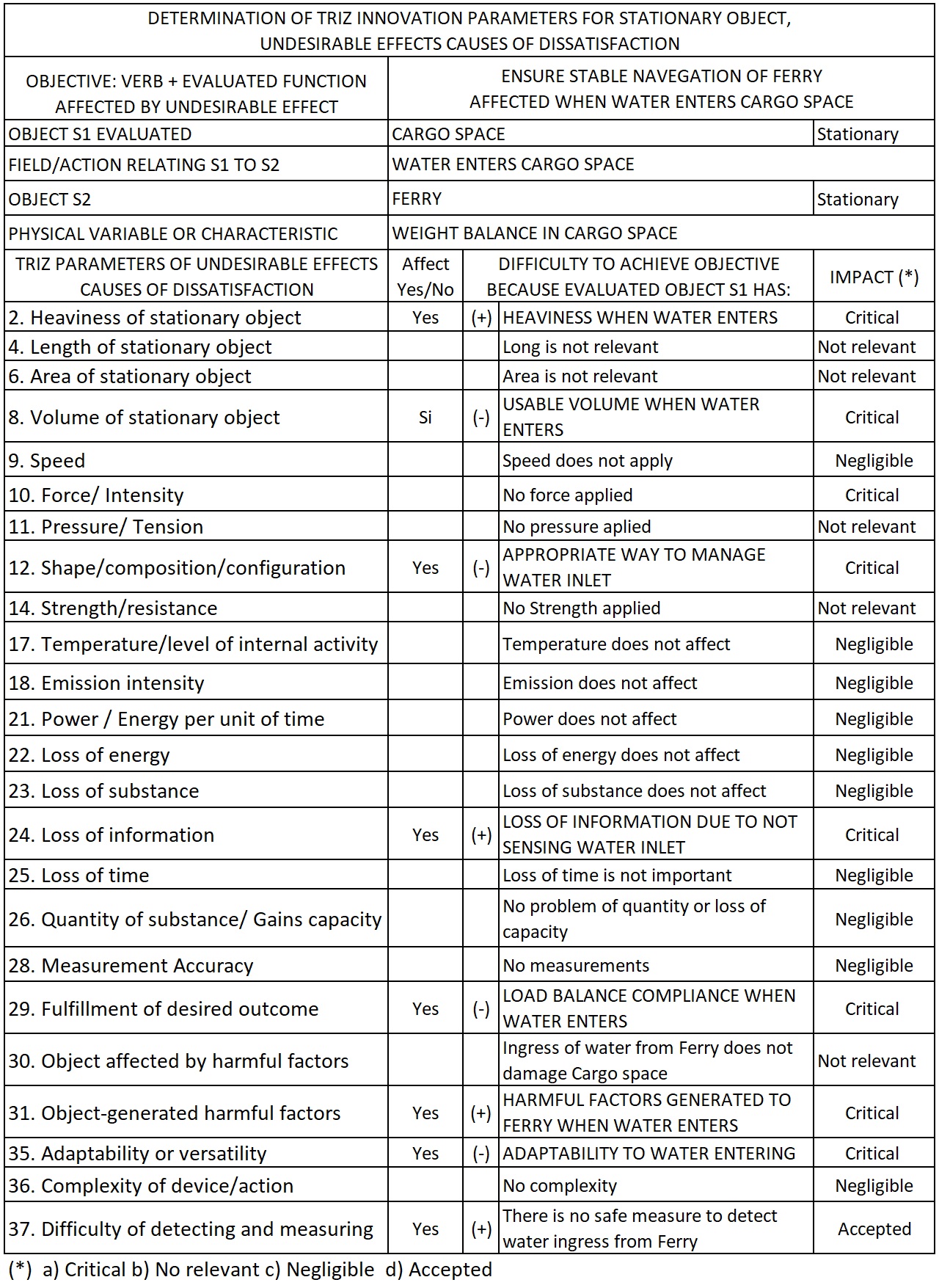
Once the undesirable effects have been determined, the next step is to define the up to 4 effects to be evaluated, selected from the up
to 7 effects selected in the previous review. Together, you must decide which need to satisfy you want to evaluate, of the 10 defined by
Nature's LI, according to the criteria indicated in Topic 10 of this Manual.
The selection that you will make will be based
on in the deep knowledge of the current situation: real, 'imagined' or 'imposed' (see Topic 9 below), where you will express your best
expectations to solve the problem or innovation challenge in evaluation.
Below is a form where the information prepared is
summarized.

The table above contains the information that will be entered into the Aatrizinventor algorithm. Remember that the algorithm will
recommend alternative combinations based on the sensitivity analysis it performs, which you must decide whether to evaluate them.
D.2 IMPROVE LOCKING PIN EXTRACTION OF CARGO SPACE VISOR DOOR FROM THE FERRY AFFECTED BY JAMMED WITH MALE-FEMALE PARTS
Evaluated space-time:
space: Place occupied by the closing mechanism of the Door-Visor in the cargo space, made up of a locking pin and male-female parts where the pin
fits.
Time: Period that elapses between the moment in which the operator initiates removal of the locking pin until the moment it is extracted or is jamming,
after a lot of effort and work.
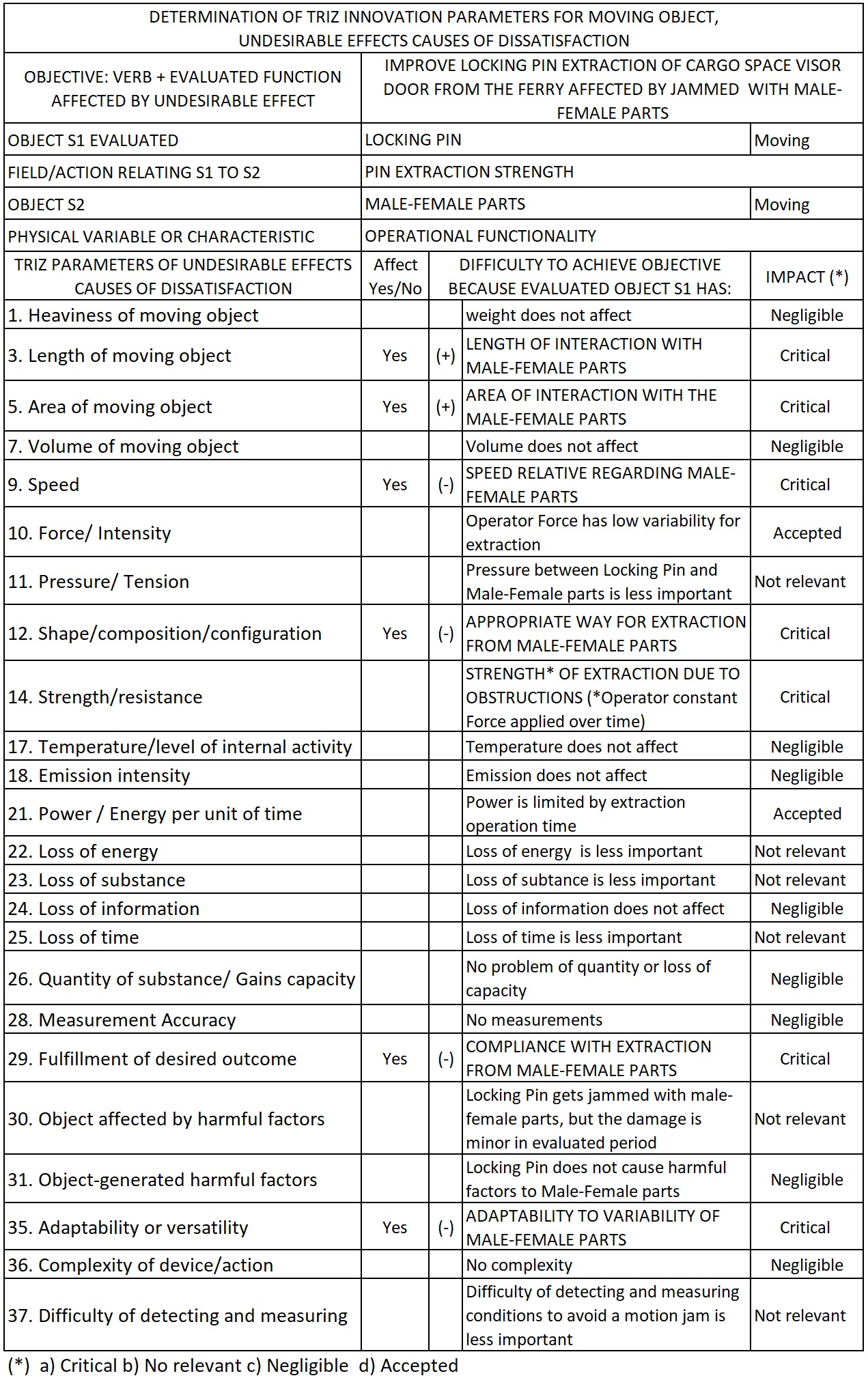
Once the undesirable effects have been determined, the next step is to define the up to 4 effects to be evaluated, selected from the up
to 7 effects selected in the previous review. Together, you must decide which need to satisfy you want to evaluate, of the 10 defined by
Nature's LI, according to the criteria indicated in Topic 10 of this Manual.
The selection that you will make will be based
on in the deep knowledge of the current situation: real, 'imagined' or 'imposed' (see Topic 9 below), where you will express your best
expectations to solve the problem or innovation challenge in evaluation. "."
". Below is a form where the information prepared is
summarized.

The table above contains the information that will be entered into the Aatrizinventor algorithm. Remember that the algorithm will recommend alternative combinations based on the sensitivity analysis it performs, which you must decide whether to evaluate them.
It has been indicated in Topic 7 of the Manual that the physical variable or characteristic of an object S1 evaluated, corresponds to
a physical variable, or characteristic, requirement, property, or behavior, of this object, which in a given state generates the undesirable effects
causes of dissatisfaction . In the same or different state, it causes the desirable effect for a need to satisfy.
For the cases that have been commented in Topic 8 of the Manual, these variables have been identified, which are summarized below.
9.1 PHYSICAL OR CHARACTERISTIC VARIABLE OF CASES ANALYZED IN Topic 8
A. IMPROVE SERVICE OF HOT COFFEE IN PLASTIC CUP AFFECTED BY BURNING THE CUSTOMERS' HAND
Physical variable or characteristic: Safety to serve hot coffee
B. DESIGN THE BEST LEGO TOY FOR CHILDREN AFFECTED BY DESIGNER'S PARADIGMS
Physical variable or characteristic: Design empathy
C. IMPROVE MOVEMENT OF AN ANIMAL AFFECTED BY REFUSING TO WALK
Physical variable or characteristic: Ability to move an animal
D.1 ENSURE STABLE FERRY NAVIGATION AFFECTED WHEN WATER ENTERS CARGO SPACE
Physical variable or characteristic: Load space weight balance
D.2 IMPROVE LOCKING PIN EXTRACTION OF CARGO SPACE VISOR DOOR FROM THE FERRY AFFECTED BY JAMMING WITH MALE-FEMALE PARTS
Physical variable or characteristic: Operational functionality
9.2 TYPES OF INNOVATION SOLUTIONS AND THE PHYSICAL OR CHARACTERISTIC VARIABLE
When the innovation challenge is formulated within the current paradigm, the existent undesirable effects limit the determination of the physical variable
or characteristic to the current reality, therefore its definition is not critical to obtain an innovative solution.
"However, although this physical variable or characteristic does not participate in the TRIZ Contradiction Matrix, it turns out to be key for the
formulation of an innovation challenge that seeks a disruptive solution outside the current paradigm
To explain this, I comment work presented at a conference that I attended in 2017. The following figure shows the result of a study by Samsung
Electronics that indicates how they see the evolution of the desired home design and the expected projection, depending on the appearance of new
required or imagined features.
"This has involved a change in the physical variable or generic characteristic of each branch of innovation-evolution, as indicated in the figure below,
these are: Conventional home, Convenient home, Comfortable home, Connected home, Creative home, Home knows my emotion, Home offers a new experience.
I have said that the formulation of an innovation challenge is an art, the following figure also reflects this, showing the best feelings of the
professionals who conducted this work. Undoubtedly, the development of the home can also be projected in other branches of development that give
satisfaction to human beings.

To find innovation solutions with Nature's L.I., which are projected as in the figure above or in any other case,
I recommend three options to do it.
"For example, to create a Connected Home:
Innovation solution through evolution
a. Stand in the current situation to define the affected function, for example, Free up time of operation of equipment affected by face-to-face
action. Set the current physical variable: (-) Connected home, identifying the undesirable effects causes of dissatisfaction that exist in the
actuality (for example, lots of equipment to connect, loss of time due to waiting, etc.) and apply Nature's L.I.
Innovation solution through imagination
b. For the same function affected above, evaluate an imagined solution (for example, think in a center point where someone yelling and there are
people receiving the information in the places of the equipment to be connected), which can be basic, crude or seem illogical. Keep the
physical variable: (-) Connected home,
identifying the undesirable effects that cause dissatisfaction of the imagined solution (for example, costs, interference, weak voice signal emission,
etc.). This preliminary non-ideal solution is improved by applying Nature's L.I.
Innovation solution through imposition
c. For the same affected function above, evaluate the implementation of the solution imposed by the desired physical variable. For example,
it is necessary to have (+) Home connected, for some unknown wireless solution that is estimated to satisfy the established requirements. Based on
knowledge current that is available, the undesirable effects causes of dissatisfaction that will occur in this case must be predicted (for example,
higher cost of equipment, more power in equipment, difficulty of detection between equipment, etc.). This unknown solution is discovered improved by
applying Nature´' L.I.
"Option a. it is the most limited to obtain disruptive solutions, as it is tied to the current situation. It will be possible to innovate,
but it will be increasingly difficult until reaching a plateau in the evolution branch, where nothing will change. The options b. and c.
they are more effective in offering a disruptive solution compared to the original current situation.
" Below are cases evaluated with Nature's L.I. for the three types of innovation mentioned: by evolution, by imagination and by imposition.
The MMEC diagrams will be omitted but remember that in Topic 11 they are shown in detail for the cases presented in Topic 6.
9.3 EXAMPLE OF A SOLUTION OF INNOVATION THROUGH EVOLUTION: SEA SQUIRT LARVA SURVIVAL
Here you will see an application of option a. above, that is, using evolutionary innovation to find a solution that improves the
Current situation.
" Evolutionary innovation predominates in nature and here, for example, shows the case of innovation-evolution of the Sea Squirt Larva,
which must survive clinging to a rock at the bottom of the sea.
"According to scientific disclosure, Sea squirt belong to a remarkable group of submarine animals called tunicates. They are marine filter feeders with a
water-filled, sac-like body structure and two tubular openings, known as siphons, through which they draw in and expel water, and that
way they obtain plankton and the organic matter to live. They are named after their water expulsion.
" Sea squirts are also members of the phylum Chordata – a group of animals that includes fish, birds, reptiles, and mammals. This is
because during their larval stage, sea squirts have many of the anatomic features of vertebrates.
" Sea squirts are hermaphrodites; they have male and female reproductive organs. They reproduce by releasing eggs and sperm into the
seawater simultaneously. After about three days, the eggs become larvae.
" The free-swimming larvae stage lasts only a brief time, as the larvae are not able to feed properly. Soon, they settle down and attach
themselves to the place where they will spend the rest of their lives. As they need to start feeding, a surprising transformation begins.
The sea squirts larvae begin absorbing all the parts that made them members of the phylum Chordata. Where they once had gills, they develop
ingestion and forms siphons that will help it take water and food into its body. It absorbs its twisted tail. It absorbs its primitive
eye and its cartilaginous spine. Finally, it even absorbs its small rudimentary “brain” (brain ganglion) that it used to swim and find
its place of attachment — it eats its own brain¡¡
"INNOVATION CHALLENGE:
OBJECTIVE: Improve the survival of sea squirt larva, affected by lack of food.
"PHYSICAL VARIABLE O CHARACTERISTIC: Survival capacity
"INITIAL SITUATION: Less Survival capacity
"META DESEADA: More Survival capacity
"OBJECT S1 EVALUATED: Sea Squirt Larva
"OBJECT S2: Sea water
"Below is the evaluated situation and all the undesirable effects that are causes of dissatisfaction identified.

The application of Nature's L.I. delivers a solution that demonstrates the innovative capacity of nature: The initial undesirable effects
and an optimal need to satisfy determine the solution. If no new undesirable effects appear, there will be no new needs, and nothing will change anymore.
" The solution reached, which coincides with the scientific description already given, is shown below in graphic form with the main
selected inventive principles.
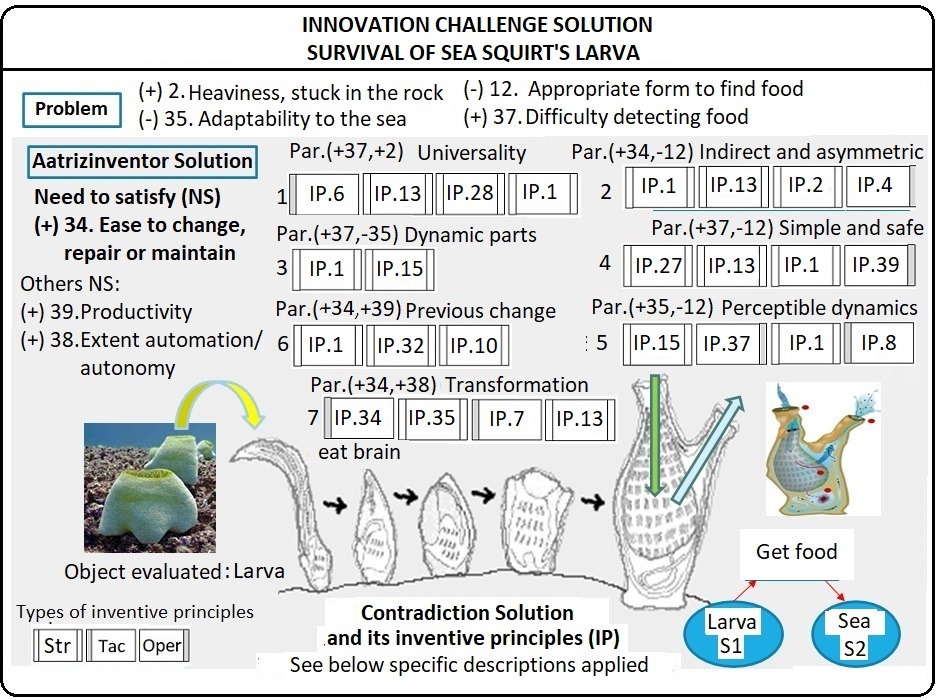
The selected inventive principles determine the direction of the innovation solution, as indicated in the following
description, applied from the initial state of the sea-squirt lar
IP.6. Universality (Pos.10)
"Sol. Sea Squirt Larva should perform multiple functions and eliminate the need for other parts.
IP.13. Inverse or Indirect Action (Pos.4)
"Sol. Sea Squirt Larva must reverse its action, if it cannot go for food, let the food come to it.
IP.28. Mechanics Substitution (Pos.12)
"Sol. Food capture mechanism must be changed, using fields applied to seawater with food, which moves this mixture with those fields.
IP.1. Segmenting/ Integrating (Pos.1)
"Sol. Sea Squirt Larva must integrate all its original parts and segment the necessary new ones
IP.2. Taking out/ Adding (Pos.3)
"Sol. Sea Squirt Larva should separate the interfering parts and leave only the necessary ones, while adding new useful parts.
IP.4. Asymmetry/ Symmetry (Pos.17)
"Sol. Sea Squirt Larva must incorporate asymmetric characteristics.
IP.15. Dynamics (Pos.2)
"Sol. Sea Squirt Larva must change to an optimal dynamic condition, dividing into parts that are capable of having a relative
movement with each other and that are adaptive: siphons generate a relative movement of suction and impulsion of seawater.
IP.27. Cheap Short-Living Objects (Pos. 6)
"Sol. Sea Squirt Larva must incorporate basic useful actions with its own means and compress certain original characteristics to
achieve the desired result.
IP.39. Inert Atmosphere / Environment (Pos.18)
"Sol. Sea Squirt Larva must generate an inert environment, which protects it against dangerous external environment: Sea Squirt
is covered with a natural protective casing.
IP.37. Useful perceptible change (Pos.16)
"Sol. Sea Squirt Larva must generate perceptible changes in Sea Water.
IP.8. Anti-Weight/ Compensation (Pos.23)
"Sol. Sea Squirt Larva must compensate for its weakness to detect / capture food, interacting with the environment (sea water in
this case) to facilitate food capture.
- Other revised inventive principles
IP.34. Discarding and Recovering (Pos.Contr.between.NS)
"Sol. Sea Squirt Larva must discard those parts that have already fulfilled their function and are no longer needed. In this
case there is absorption, since once its swimming phase is completed, it will no longer need its brain and it can absorb it: it 'eats' its own brain.
The complete solution delivered by Nature's L.I. for Squirt's Larva evolution is found by entering the link shown above 'Enter to Algorithm'/'Aatrizinventor Examples'.
"It should be noted that most of the inventions that human beings have developed follow the innovation process by evolution. In the book referred to at the end of Topic 2 of this Manual, the evolutionary innovation of distance communication between people is developed:
" - The limitations of live voice communication gave rise to the invention of the telegraph
" - The undesirable effects of the use of the telegraph determined the invention of the landline telephone and
" - The undesirable effects of the landline phone drove the invention of the mobile phone.
9.4 EXAMPLE OF IMAGINED SOLUTION: FIRST ATTEMPT TO GET TO MARS
Here you will see an application of option b. above, that is, using an imagined solution, to find a disruptive solution to the current situation.
It is about a primitive man who wishes to fly to the planet Mars. An imagined initial solution is formulated, where the Marsnaut in an open field
assembles a take-off mechanism, consisting of an acceleration platform and a natural spring, which was formed in the trunk of a tree, to propel
itself upwards. Unsurprisingly, the result is poor: little momentum, low speed, loss of flight energy due to the force of gravity, ending in a hard
landing at close range.
Innovation challenge:
OBJECTIVE: Improve condition to fly to Mars affected by negative effects of the environment
DESIRED GOAL: More Ability to Fly
OBJECT S1 EVALUATED: Marsnaut
OBJECT S2: Environment between Earth and Mars
"Below is the evaluated situation and all the undesirable effects causes of dissatisfaction identified.
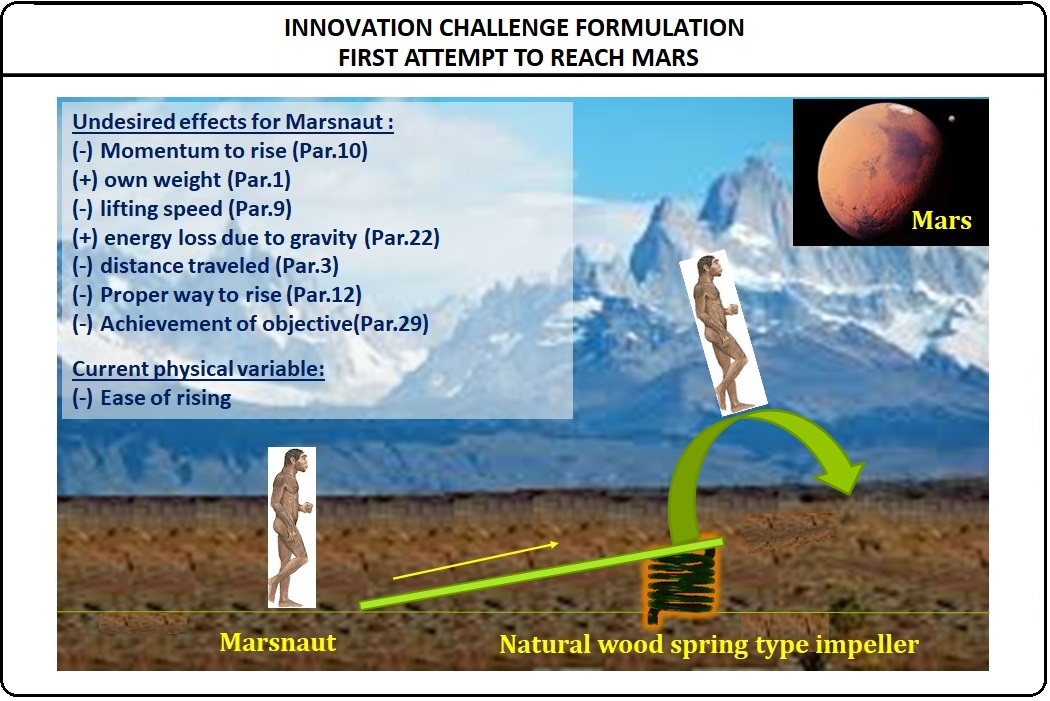
The application of Nature's L.I. delivers a solution that will surprise you. This is shown below in graphical form with the
main inventive principles selected.
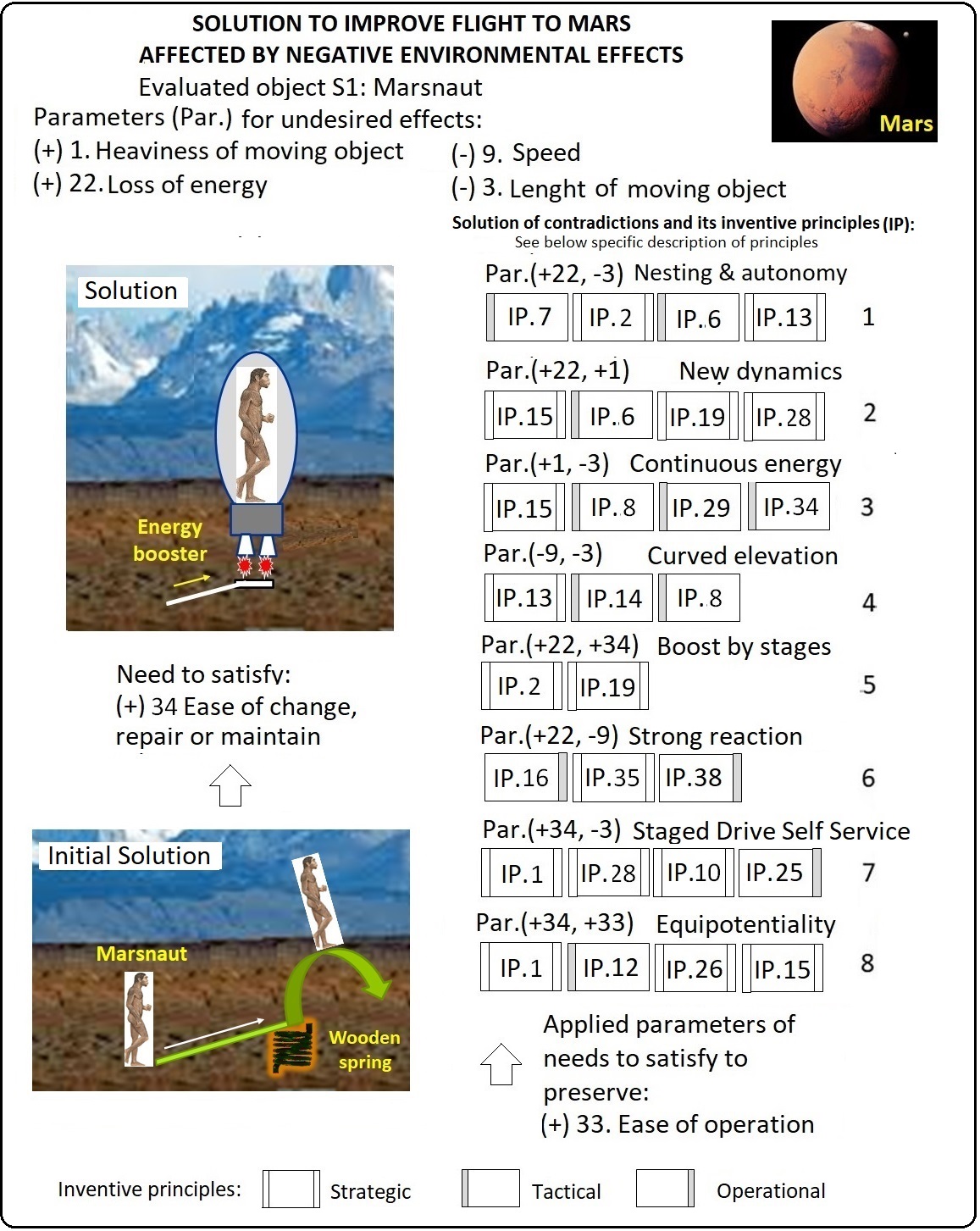
The selected inventive principles indicate the direction of the innovation solution, as indicated in the following description,
for the most relevant inventive principles, applied according to the current state of the art technology:
IP.7. Nesting/ Dispersing (Pos.6)
Sol. Marsnaut should be placed inside a transport and safety capsule.
IP.2. Taking out/ Adding (Pos.1)
Sol. New components must be added to Marsnaut.
IP.6. Universality (Pos.8)
Sol. Marsnaut must be provided with the capacity to perform multiple functions and eliminate the need for other parties.
IP.13. Inverse or Indirect Action (Pos.5)
Sol. It must be changed from a direct impulse action to an indirect one.
IP.15. Dynamics (Pos.2)
Sol. Allow (or design) the characteristics of Marsnaut, external environment or process, to change to be optimal or to find
optimal operating condition.
IP.19. Time-Varying Action/ Periodic or Pulsating (Pos.13)
Sol. A time-varying impulse must be available for Marsnaut, for example pulsating.
IP.28. Mechanics Substitution (Pos.10)
Sol. Marsnaut own impulse mechanism must be changed to indirect action with energy fields.
IP.8. Anti-Weight/ Compensation (Pos.7)
Sol. Marsnaut drive weakness must be compensated for by combining it with other objects or fields that provide an effect to improve
the current situation.
IP.29. Controllable Soft Variables (Pos.18)
Sol. Control variables must be considered to manage the Marsnaut impeller .
IP.34. Discarding and Recovering (Pos.4)
Sol. The applied drive field should be replenished periodically, for example from a fuel tank.
IP.14. Spheroidality - Curvature - Angle (Pos.9)
Sol. The flight must be oriented at an angle or curvature to attenuate the braking effect of gravity.
IP.16. Partial or Excessive Actions (Pos.11)
Sol. If the flight objective to Mars is difficult to achieve completely, using a given solution method; then the problem can be considerably
easier to solve, using 'a little less' or 'a little more' of the same method.
IP.35. Transformation / Parameter Changes (Pos.14)
Sol. The drive and transport system must be transformed to make it flexible and adaptive.
IP.38. Strong and/or Fast Reactions (Pos.20)
Sol. Strong reactions must be applied to propel the flight, for example a fuel reaction with oxygen.
IP.1. Segmenting/ Integrating (Pos.3)
"Sol. Different parts, forms, phases, states, conditions or functions, existing and new, of the Marsnaut transport must be integrated into a single
entity.
IP.10. Preliminary Action (Pos.19)
Sol. Changes required for Marsnaut must be made in advance.
IP.25. Self-service (Pos.24)
Sol. Resources must be provided for self-service during the flight, for example, fuel and food.
IP.12. Equipotentiality (Pos. NS.1.b)
Sol. Stable impulsion and transport must be ensured for Marsnaut, without sudden variations.
IP.26. Copying/Replicating (Pos. NS.1.c)
Sol. New drive and transport system must be an improved copy of Marsnaut, without affecting it in any way.
IP.20. Continuity of Useful Action (Pos.15)
Sol. Flight continuity must be ensured.
- Other revised inventive principles
Contradiction: [(+) 34. Ease of change, repair or maintain][(-) 9. Speed][IP(s):34,9,0,0]
IP.9. Preliminary Anti-action (Pos.16)
Sol. Actions must be prepared in advance to face the harmful effects of flying to Mars: providing oxygen, food, place for physiological
needs, protection of the external environment, etc.
Contradiction: [(-) 3. Length of moving object][(+) 22. Loss of Energy][IP(s):7,2,35,39]
IP.39. Inert Atmosphere / Environment (Pos.23)
Sol. A healthy and safe environment must be provided for the Marsnaut flight.
Undoubtedly, many technical developments, inventions and discoveries were required to realize that way of flying, which could have been
accelerated with Nature's L.I., giving speed and focus to the original challenge."."
".
The complete solution delivered by Nature's L.I. It is found by entering the link shown above 'Enter to Algorithm'/'Aatrizinventor Examples'.
9.5 EXAMPLE OF A SOLUTION IMPOSED BY DESIRED PHYSICAL VARIABLE: CARS MANUFACTURING WITHOUT DESIGN COMPROMISES
This is a typical case study that can be found in Theory of Constraints. Goal A is set: Quickly build a new car model that is
successful. Two conflicting needs are stated: B. Deliver significant improvements and C. Get to market quickly. To comply with B., it is necessary
to accept design compromises, while to comply with C. design compromises must be avoided."."
".
Now we will see how this same problem is formulated with Nature's L.I. In the first place, it becomes a multivariable problem, as shown in the
following figure, where the physical variable or characteristic: (-) design commitments, generates undesirable effects, causes of dissatisfaction,
while in the same state it produces the effect desired to build the desired car.
Innovation challenge:
OBJECTIVE: Build the best car in the world without design compromises affected by production difficulties
DESIRED GOAL: Less design compromises
OBJECT S1 EVALUATED: Manufacturing System
OBJECT S2: New model of cars


The selected inventive principles indicate the direction of the innovation solution, as indicated in the following
description, for the most relevant inventive principles:
IP.16. Partial or Excessive Actions (Pos.12)
"Sol. The Manufacturing System must be adjusted in operation. If a solution method presents difficulties; then the problem, can be
easier to solve, using 'a little less' or 'a little more' of the same method.
IP.29. Controllable Soft Variables (Pos.6)
"Sol. Controllable variables such as pneumatic, hydraulic, electrical and digital must be used to operate and control the Manufacturing
System.
IP.1. Segmenting/ Integrating (Pos.4))
"Sol. The Manufacturing System must be divided into phases, stages or circuits.
IP.28. Mechanics Substitution (Pos.3)
"Sol. The current mechanics of manufacturing based on work teams must be changed by an automated action.
IP.32. Perception/ Appearance/ Color Changes (Pos.1)
"Sol. It must be changed how the Manufacturing System is perceived by the cars in manufacture (figurative)
IP.15. Dynamics (Pos.7)
"Sol. An optimal dynamic of the Manufacturing System must be designed according to production stages, considering parts that have relative
movement to each other, with a flexible and adaptive operation.
IP.26. Copying/ Replicating (Pos.2)
Sol. The capabilities of current work teams must be replicated in new mechanized or robotic systems.
IP.8. Anti-Weight/ Compensation (Pos.13)
Sol. The current weaknesses of the Manufacturing System must be compensated to execute certain actions, such as application of complex work
sequences, timely supply of parts, utilities and energy, combining it with other objects or fields that provide an effect to improve the
production action.
IP.10. Preliminary Action (Pos.8)
Sol. The required changes to the manufacturing system must be made in advance.
IP.40. Composite Materials/ Conditions (Pos.21)
Sol. Compound actions, mainly human-machine, should be applied in the Manufacturing System to improve production costs.
IP.30. Simple Shapes/ Ways to Interact (Pos.9)
"Sol. Extensions or arms mechanized in a straightforward way must be used to execute actions of the Manufacturing System.
IP.36. Phase, State or Condition Transitions (Pos.23)
Sol. The phenomena that occur during changes in the state, dimension or condition of the Manufacturing System, including the necessary
detectors, should be used to control the interaction with the cars in production.
IP.34. Discarding and Recovering (Pos.16)
Sol. A permanent supply of parts, utilities and energy must be maintained to ensure continuity of the Manufacturing System.
IP.2. Taking out/ Adding (Pos.1)
Sol. Interfering parts or properties of the manufacturing system must be separated, leaving only the necessary parts (or properties).
New required ones must be added.
IP.18. Mechanical Vibrations/ Energy Variations (Pos.22)
Sol. The component parts of the manufacturing system must be moved cyclically with energies that activate them.
IP.12. Equipotentiality (Pos.24)
Sol. It must be ensured that the manufacturing system works in a stable way, without sudden variations.
IP.17. Another Dimension or Field (Pos.24)
Sol. The manufacturing system must operate in a multilevel arrangement.
IP.5. Merging/ Separating (Pos. NS.1 Order.2)
Sol. Processes, activities or parts of the manufacturing system with similar operations or functions must be brought together or merged
so that they act together at the same time.
- Other revised inventive principles
Contradiction: [(+) 36. Complexity of Device/ Action]][(+) 33. Ease of operation][ IP(s) : 27,9,26,24]
IP.27. Cheap Short-Living Objects (Pos. 10)
"Sol. To manage the complexity of the manufacturing system, it must be replaced or divided (either totally or partially) with multiple
objects, actions or sub-parts of low cost or short duration, which compress or simplify its characteristics and properties,
limited but sufficient. to achieve the desired result. For example, replace with robot.
IP.9. Anti-Preliminary Anti-action (Pos.19)
"Sol. Substitute actions must be programmed to face operational difficulties: delays in previous stages, lack of a component, failures of
parts and pieces, etc., that minimize the loss of continuity of a complex Manufacturing System.
IP.24. Intermediary (Pos.17)
"Sol. Carrier articles or intermediate processes should be used to facilitate the action of the Manufacturing System.
Contradiction: [[(+) 33. Ease of operation][ (+) 1. Heaviness of moving object][ IP(s) : 25,2,13,15]
IP.25. Self-service (Pos.11)
"Sol. Existing or provided resources or functions must be used for the Manufacturing System to serve itself by performing useful ancillary
functions during operation.
"Again, a solution is obtained that orients towards a disruptive change for the manufacture of cars. In actual practice, other challenges were
also required to be solved to complete the paradigm change that this meant. "."
".
The complete solution delivered by Nature's L.I. It is found by entering the link shown above 'Enter to Algorithm'/'Aatrizinventor Examples'.
> FINAL COMMENTS:
It is necessary to remember that the inventive principles have a generic description, which allows them to be applied to
each particular case, based on the knowledge of the problem and the state of evolution of the evaluated process. A given solution can be
applied in different periods in time or places in space. The practical exercise will give you the experience to discover, for yourself, that
the solutions are repeated, as we see in nature.
The examples that have been seen in this Topic allow us to remember that innovation is a process, so each specific solution obtained could require new stages or specific parts to solve, which can also be solved using Nature's L.I to achieve full satisfaction. “The proposed solution can be as simple as putting a protection on a plastic cup to drink hot coffee, or more complex like the flight to Mars that a primitive man dreamed of when he jumped and wanted to reach the stars. There will always be some ropes to tie.
In the case seen from the flight to Mars, it took thousands of years for man to discover the technology that could make him think that this
dream was possible. The extraordinary thing about this is that The Nature's Language of Innovation could predict that it would be necessary,
starting from a simple leap from that primitive man. Nature's L.I. allows speed and focus to solve problems or innovation challenges,
guiding the application of existing technical options or others to be discovered.
"Again, I declare that humanity must listen more to Nature, in it are imprinted the laws of innovation-evolution that govern our passing in
this infinite Universe and that, for believers, are signs of the hand of God.
INNOVATION PARAMETERS FOR NEEDS TO SATISFY
Nature's Language of Innovation, Nature's L.I. identifies twelve TRIZ innovation parameters, called parameters of 'needs to
satisfy', that determine the achievement of the objective set in the innovation challenge. To improve these parameters, we do not operate directly
on them, but they are a consequence of actions on some of the parameters of undesirable effects, causes of dissatisfaction identified, as
indicated above in Topic 8 of the Manual.
It should be noted that Parameter 35. Adaptability or Versatility is considered as a parameter
of need to satisfy, when seeking to improve the adaptability of Object S1 evaluated in relation to Object S2 with which it interacts. On the other
hand, it is considered an undesirable effect, cause of dissatisfaction, when Object S1 has difficulty in achieving the desired objective due to a
problem of adaptability to the variability of Object S2 with whom it interacts.
Below is a list of TRIZ innovation parameters for the needs to satisfy. They are divided into 10 for
moving objects and 10 for stationary objects, being different only in terms of 'duration' and 'energy use', whether moving or stationary.
TRIZ Innovation Parameters for -Needs to Satisfy- for Moving or Stationary Object

What is indicated in Topic 2 is reiterated, the order in which the needs to satisfy parameters are presented, represents for Nature's L.I. the most probable S
curve of innovation-evolution of any activity or process that develops an object. Disruptive innovations generate changes or jumps in S curves,
which must complete this same cycle. The ability that human beings achieve to generate disruptive leaps, implicitly applying the language of
innovation of nature, gave them a differentiating factor of evolution in this nature to which we belong.

TRIZ INNOVATION PARAMETER OF NEED TO SATISFY TO EVALUATE
The Aatrizinventor algorithm allows you, based on your knowledge of the current situation of the innovation challenge, to
propose the need to satisfy for Object S1, expressed as one of the 10 defined innovation parameters, whether moving or stationary.
The TRIZ innovation parameter selected by the need to satisfy, and any combination of up to 4 of the up to 7 parameters of undesirable effects
causes of dissatisfaction identified, form a specific contradiction matrix, see table II in Topic 14 of the Manual, which contains a relevant
part of the solution proposed by Nature's L.I.
The solution is complemented with the matrix of contradictions between the selected need-to-satisfy parameter and the parameters associated with
the rest of the defined needs to satisfy, see table IV in Topic 14 of the Manual. The criteria applied to ensure the contribution to the solution
of this matrix is the following: The improvement of the selected need to satisfy should not worsen the current state of the other needs to satisfy,
for which there are up to 9 contradictions between selected need to satisfy and the other needs to satisfy defined, which must be solved.
Nature's L.I. postulates that, to the extent that the inventive principles are repeated in both matrixes described above, the selected solution will
be easier to implement. This implementation can be real or projected to evaluate a next state. From the new state, Nature's can be reapplied to
advance a new step in the innovation-evolution process of the challenge under evaluation.
"Depending on the parameters you have chosen to evaluate and the innovation-evolution state of the evaluated Object S1, which you do not know, the
algorithm will deliver a solution that may not be optimal and complex to implement.
"Commonly, the most complex solutions will be reflecting several leaps of innovation-evolution in a single step, which are difficult to imagine and therefore difficult to implement.
It has been said that the current situation determines the future situation, therefore the
most convenient strategy is that the innovation process that you develop goes step by step. Taking the case seen in Topic 9 of the Manual, 'A home
completes my life', it would be difficult, for example, to go in a single leap of innovation from the 'Connected Home' 'to the' New Experience
Home'. The exercise of Topic 9 of the Manual, which has been referred to, it will be fulfilled to the extent that the undesirable effects assumed
for each step are accurately predicted for the foreseen opportunity.
"Considering the difficulty indicated above in deciding the optimal need to satisfy, practical experience in innovation evaluations has taught that the solution with the minimum cost and the maximum benefit/cost ratio, which is easier to implement, is an optimal combination. which selects up to 4 of the up to 7 parameters of undesirable effects identified for the evaluated case and chooses 1 parameter of need to satisfy, generating a specific contradiction matrix that contains the desired solution. The parameter selection criterion applied by the Aatrizinventor algorithm is as follows: The inventive principles included in the ideal specific contradiction matrix must give the greatest coverage or repetition of these principles in the contradiction matrix between the selected need to satisfy and the rest of defined needs. These contradictions will ALWAYS be part of the solution, see Table IV in Topic 15 of this Manual. All this optimization exercise or sensitivity analysis, which analyzes 350 parameter combinations, is conducted automatically by the Aatrizinventor algorithm and proposes 10 optimal combinations of parameters.
In operational terms, respecting the knowledge of the Innovation Team, the algorithm evaluates the selection of up to 4 parameters of undesirable effects and 1 parameter of need to satisfy, which the team chose and proposes a detailed solution to be studied. Simultaneously, the algorithm performs the optimization exercise or sensitivity analysis with up to 7 parameters of undesirable effects identified and the 10 parameters of needs defined to satisfy, proposing 10 combinations of parameters for optimal solution alternatives for you to select and decide on a new evaluation. Examples of this analysis are shown in Topic 15 of this manual.
Below are the contradiction matrixes between needs to satisfy, for moving and stationary objects.
These matrixes, and in general the TRIZ Contradictions Matrix, contain valuable information to guide innovation processes. As an example, now I want to
refer to only one of them: Improve Parameter 32. Ease of achieving desired outcome and Attenuate or Preserve Parameter 19. Use of energy by moving object,
whose solution has the following inventive principles: [28,26, 27.1]. This contradiction predicts the existence of the Aatrizinventor algorithm used here and , by example , any Artificial Intelligence Application, among others analysis of Big Data. Interpreting this contradiction is left for exercise when you have finished reading this Manual. Assume as the evaluated object a person who in the current situation must analyze a large amount of information to recommend improvement actions. You will learn a lot from this exercise.
MATRIX OF CONTRADICTIONS BETWEEN INNOVATION PARAMETERS FOR THE NEEDS TO SATISFY
Matrix of Contradictions between Innovation Parameters
of Needs to satisfy for Moving Object
In each intersection between parameters, the inventive principles that solve that contradiction are shown.
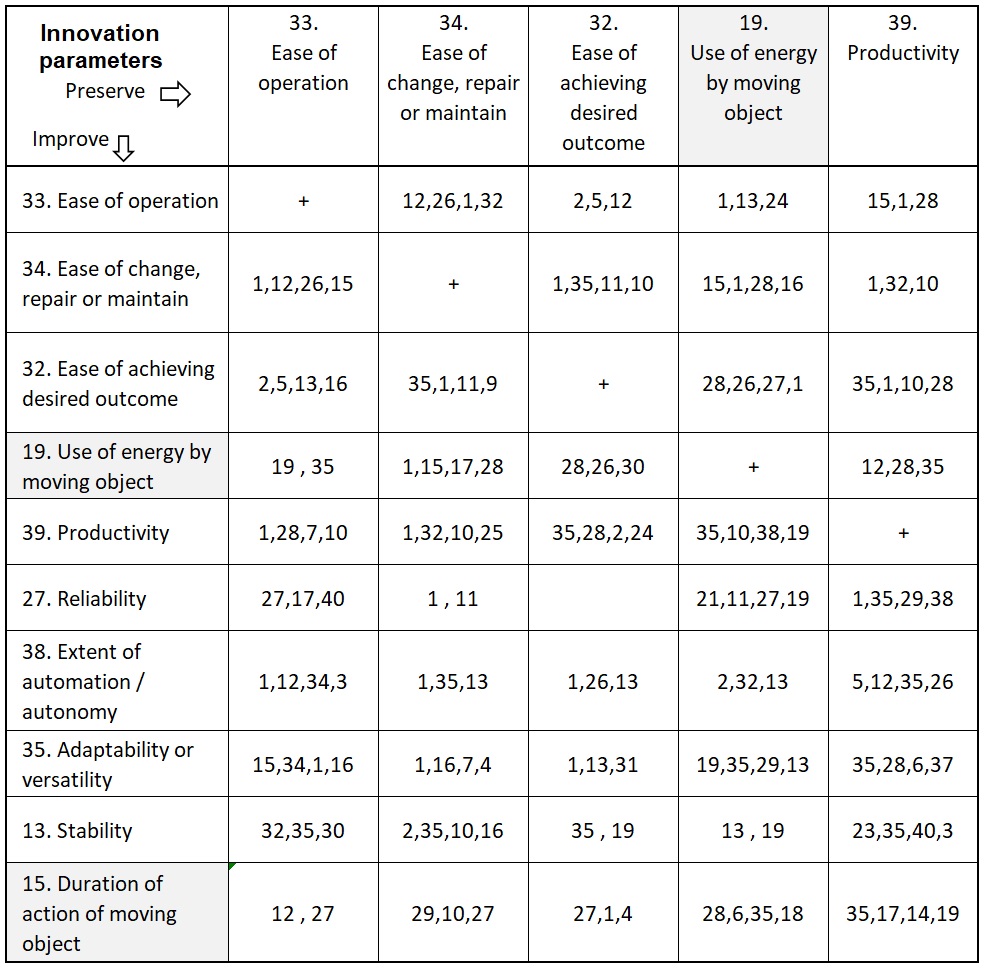
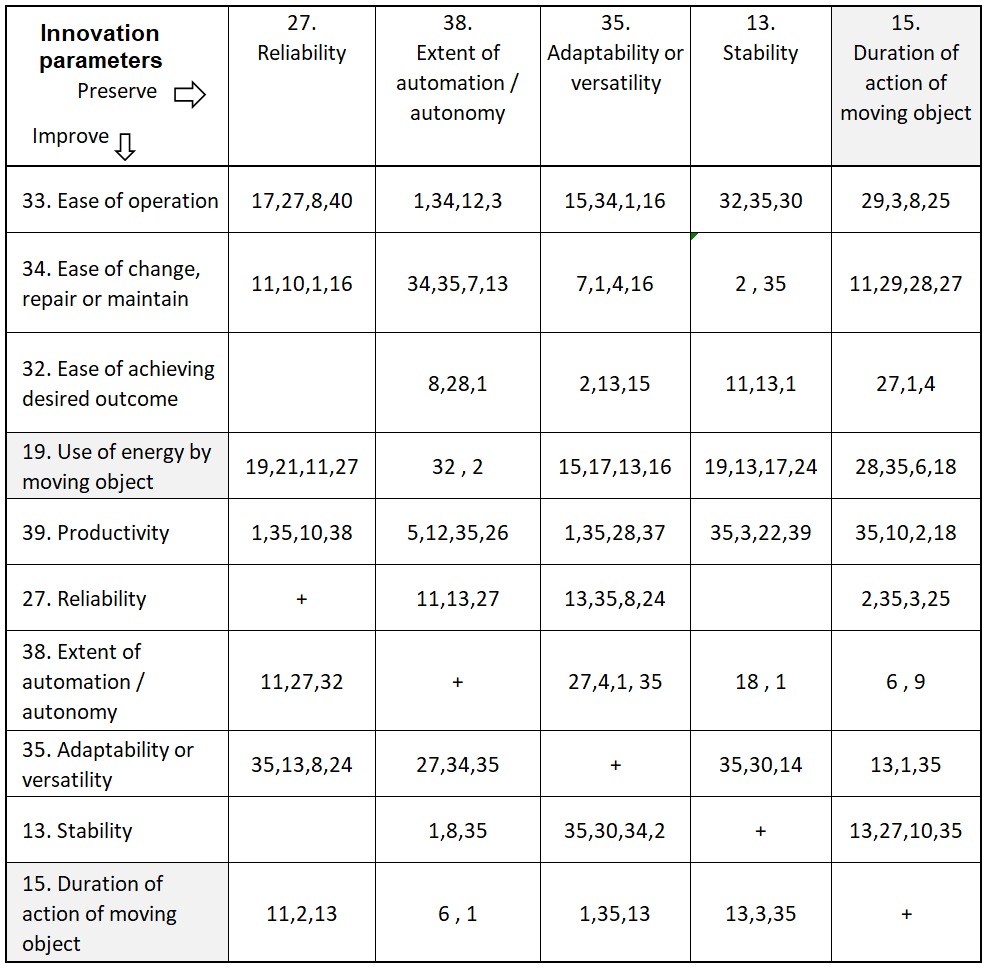
Matrix of Contradictions between Innovation Parameters
of Needs to satisfy for Stationary Object
In each intersection between parameters, the inventive principles that solve that contradiction are shown.

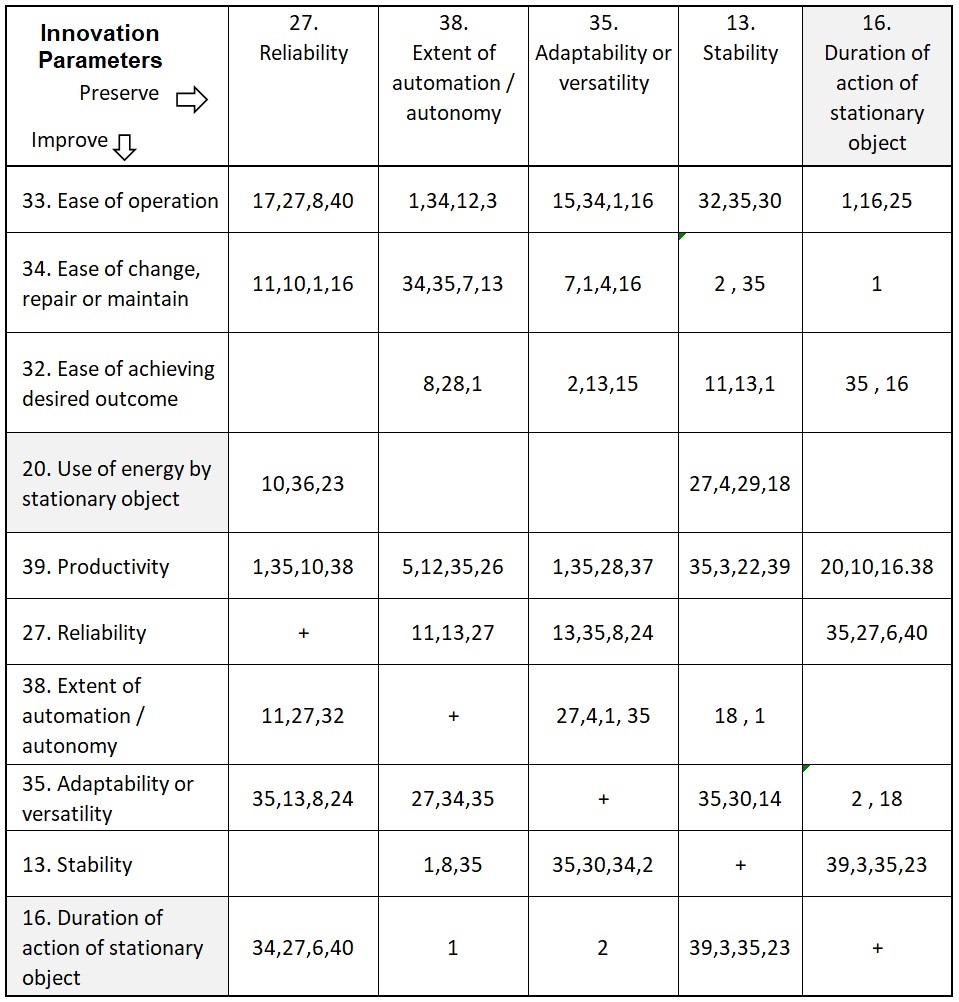
text<
MMEC MIND MAP
The information necessary to graph the MMEC diagram of the cases defined in Topic 6 of the Manual has already been provided in Topic 8.
Having this diagram will help you to have an overview of the innovation challenge in evaluation, which will allow you to detect logical
inconsistencies in formulation. Keep in mind that the quality of the solution provided by the Aatrizinventor algorithm depends on your correct
identification of the current situation. Remember that formulation process can be iterative.
The MMEC mind map for each of the referred cases is shown below::
A. IMPROVE SERVICE OF HOT COFFEE IN PLASTIC CUP AFFECTED BY BURNING THE CUSTOMERS' HAND

B. DESIGN THE BEST LEGO TOY FOR CHILDREN AFFECTED BY DESIGNER'S PARADIGMS
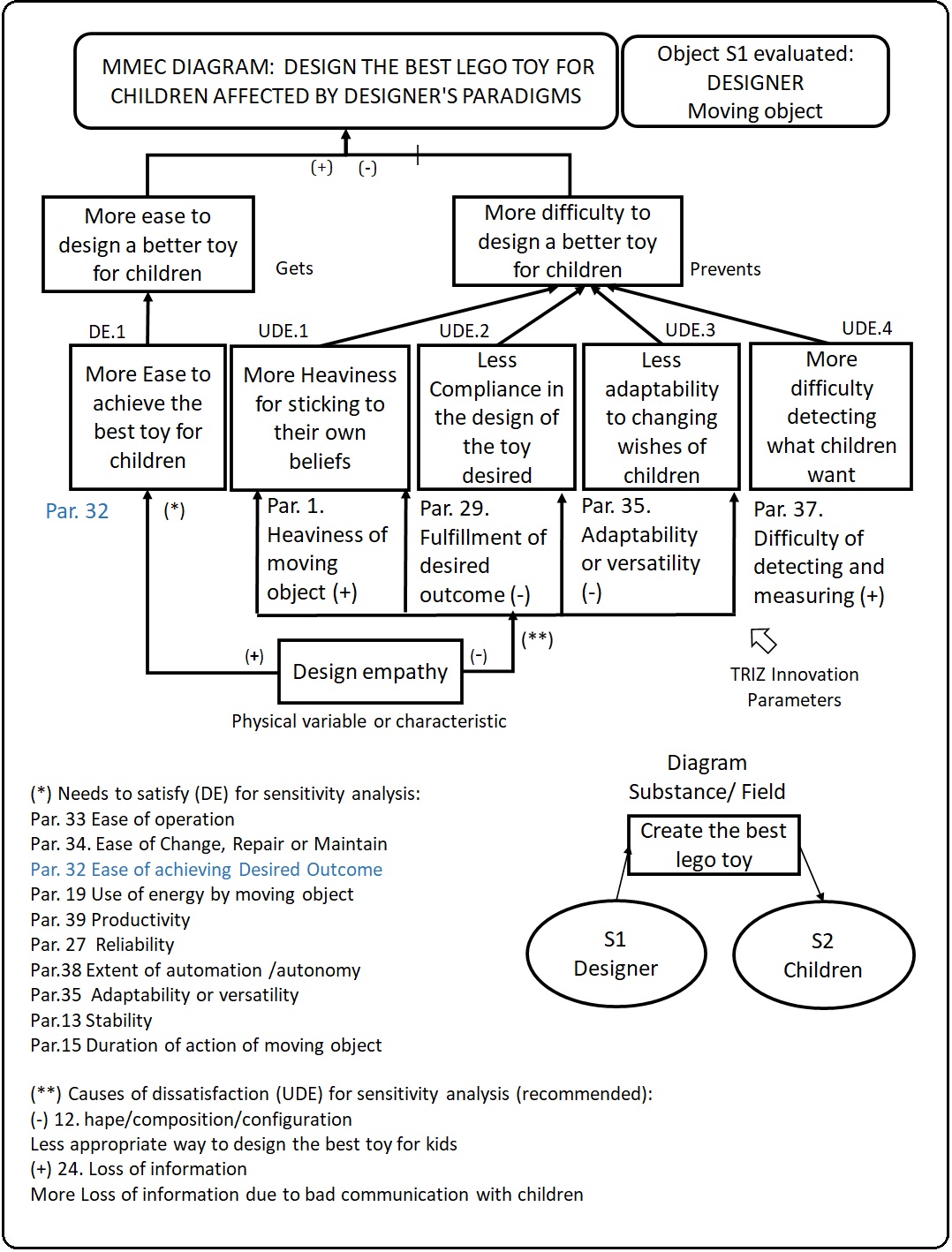
C. IMPROVE MOVEMENT OF AN ANIMAL AFFECTED BY REFUSING TO WALK
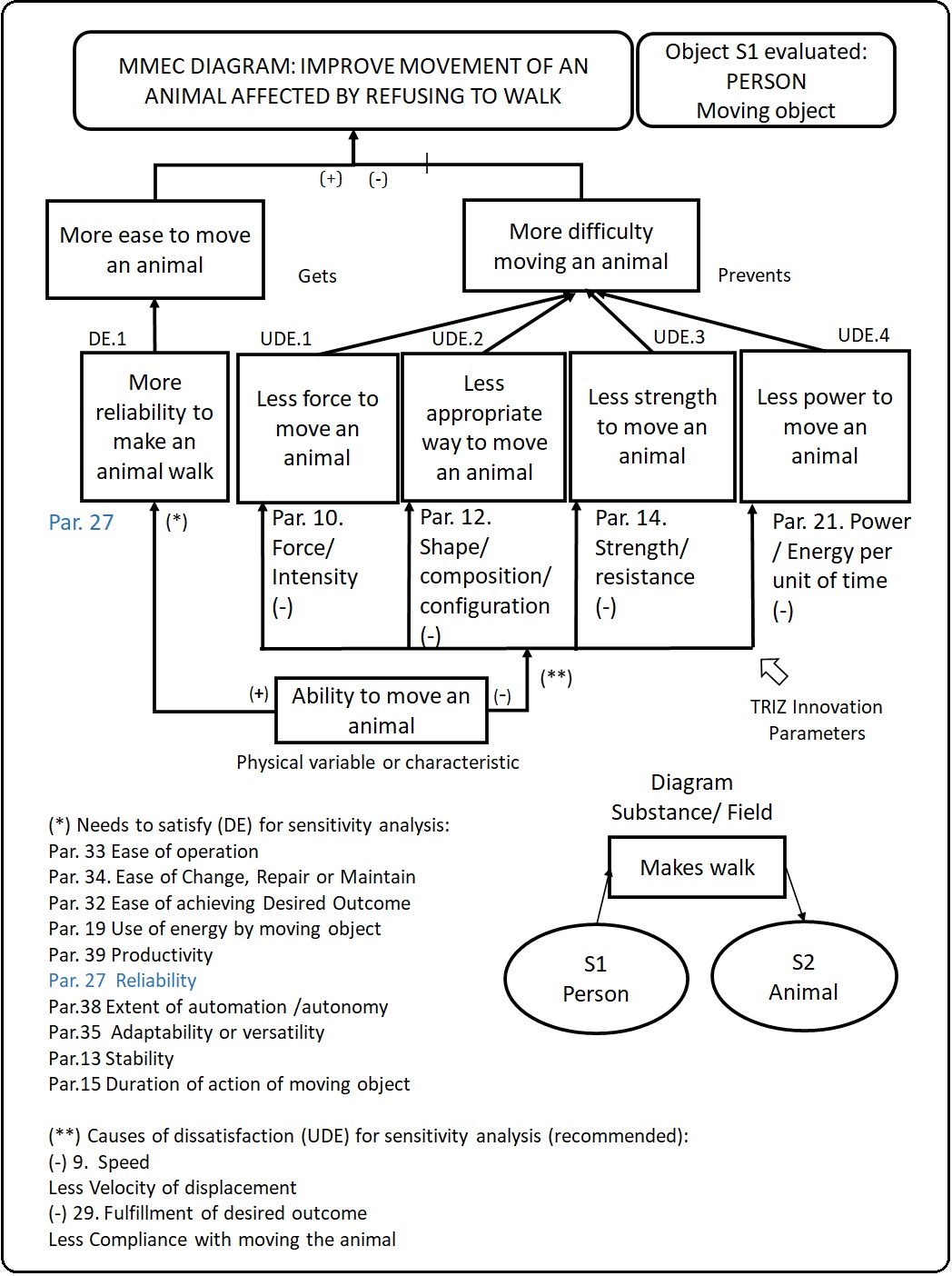
D.1 ENSURE STABLE FERRY NAVIGATION AFFECTED WHEN WATER ENTERS CARGO SPACE
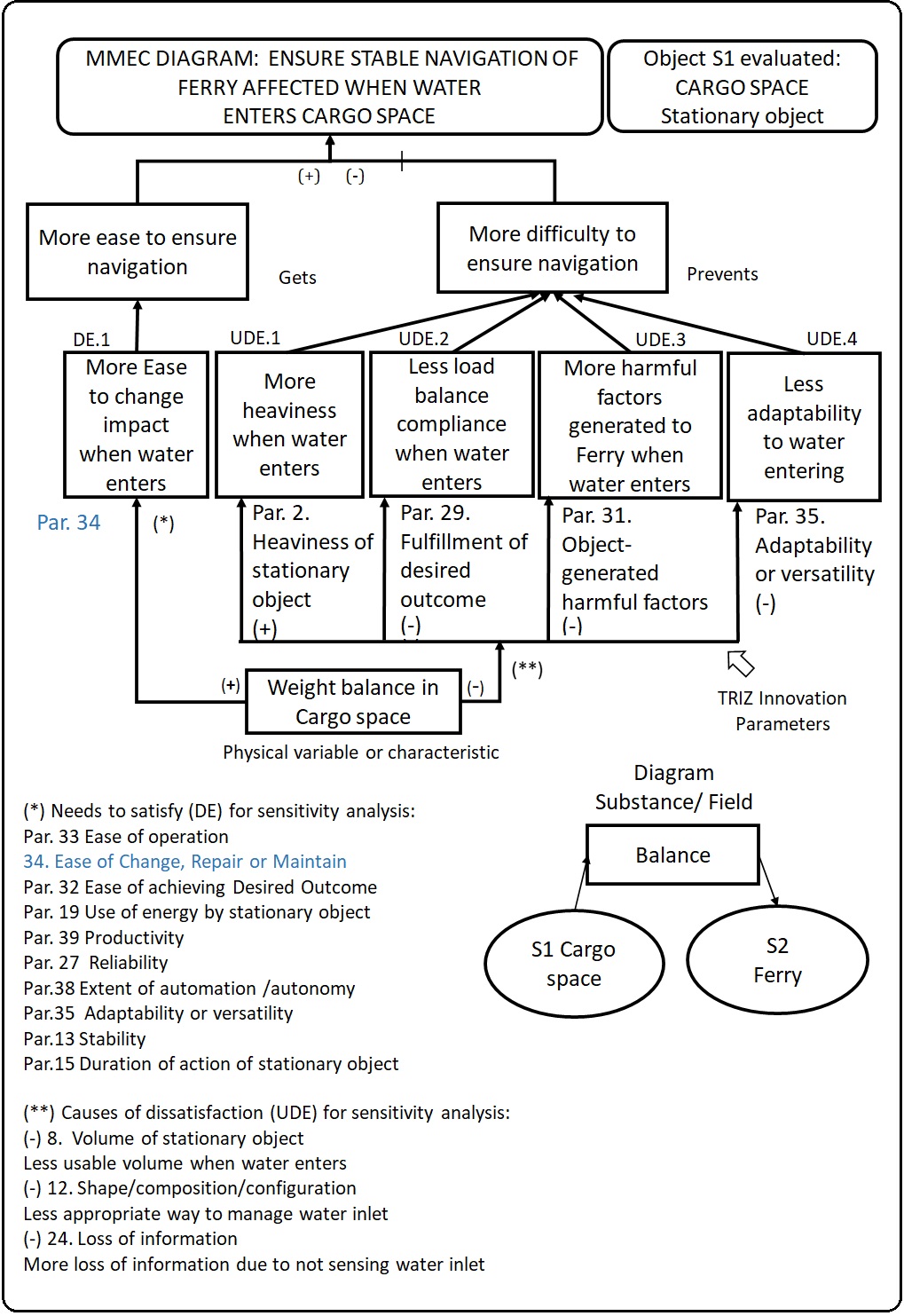
D.2 IMPROVE LOCKING PIN EXTRACTION OF CARGO SPACE VISOR DOOR FROM THE FERRY AFFECTED BY JAMMING WITH MALE-FEMALE PARTS
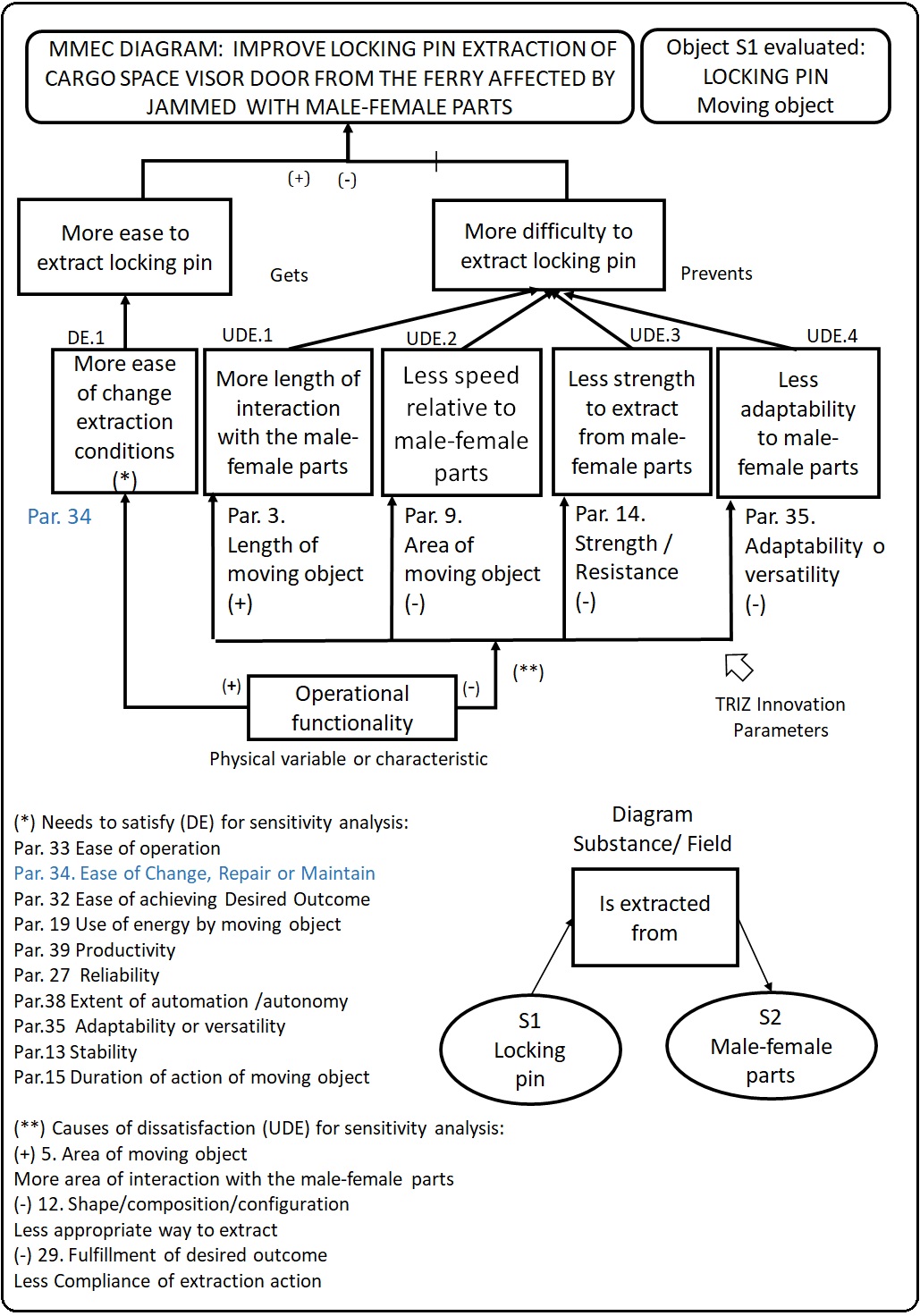
The formulation process of the innovation challenge has been completed and now we are in a position to enter the selected information into the Aatrizinventor algorithm so that it proposes a solution.
The prior work carried out on previous topics provides the necessary information to enter into the Aatrizinventor algorithm the concepts that determine the innovation challenge to be assessed. The Mental Map Diagram MMEC must include all the information required by the algorithm.
The algorithm uses a standard format, which is shown in detail in Item 8 of the Startup Manual, displaying the data entered for the case of Serving Hot Coffee in a Plastic Cup.>br>
It should be noted that, for the purpose of better understanding how the algorithm operates, the screens shown in the mentioned item 8 openly display the information contained in the corresponding MMEC diagram. However, in practice, all these concepts can be summarized, abbreviated, or in keys unique to the Innovator.
The Aatrizinventor algorithm provides, with free access, a structured summary of the logic of formulation of the innovation challenge.
This information enables you to conduct a logical analysis that will allow you, based on your knowledge of the problem or challenge, to validate the proposed
objective (verb + affected function) together with the undesirable effects, the desirable effect and the physical variable or characteristic that have been
identified. The referred summary consists of an ordering of the concepts entered into the Aatrizinventor algorithm, which will make it easier for you to
understand if the interrelationships between them make sense, that is, the logic formulated is correct. If something doesn't seem right or you want to make a
change, you can go back and make the changes you need, without any inconvenience.
This is the last instance of revision of the logic of formulation of the innovation challenge. A common mistake made when
determines the current situation, is to assign to Object S1 characteristics of Object S2 with which it interacts. All the sentences that have been formed should
be reviewed. As an example, the following tables show the logical analysis for the case of hot coffee in a plastic cup, with which its consistency with the
reality being evaluated must be verified. There must be evidence to support the incorporated concepts, do not be influenced by your 'experience' or 'common sense',
your paradigms can hinder finding a satisfactory solution. If in doubt, remove the parameter that generates it. The solution will always be valid, with a higher degree
of freedom. In complex or disruptive innovation challenges, finding the optimal solution may require several iterations: 'formulating an innovation
challenge is an art'.
It should be remembered that in practice for the private analysis recommended with the Aatrizinventor algorithm, the information provided below will be written
with the generic text proposed by Nature's L.I. or with abbreviations that the user decides, then the logical revision must be conducted outside the algorithm,
replacing the generic texts or the corresponding abbreviations. To innovate, you must take time to think carefully about the current situation.
A. GENERAL ANALYSIS OF FORMULATION LOGIC
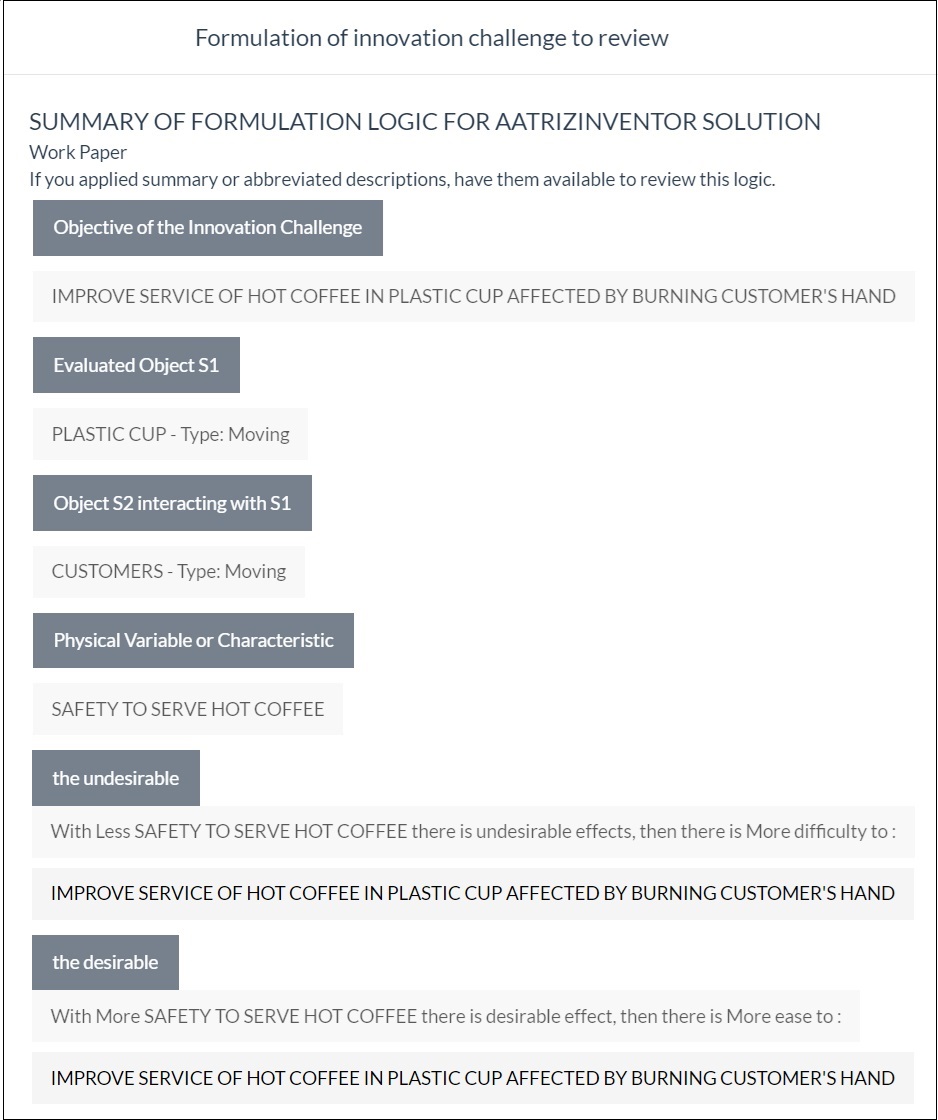
B. TRIZ PARAMETER FORMULATION LOGIC ANALYSIS
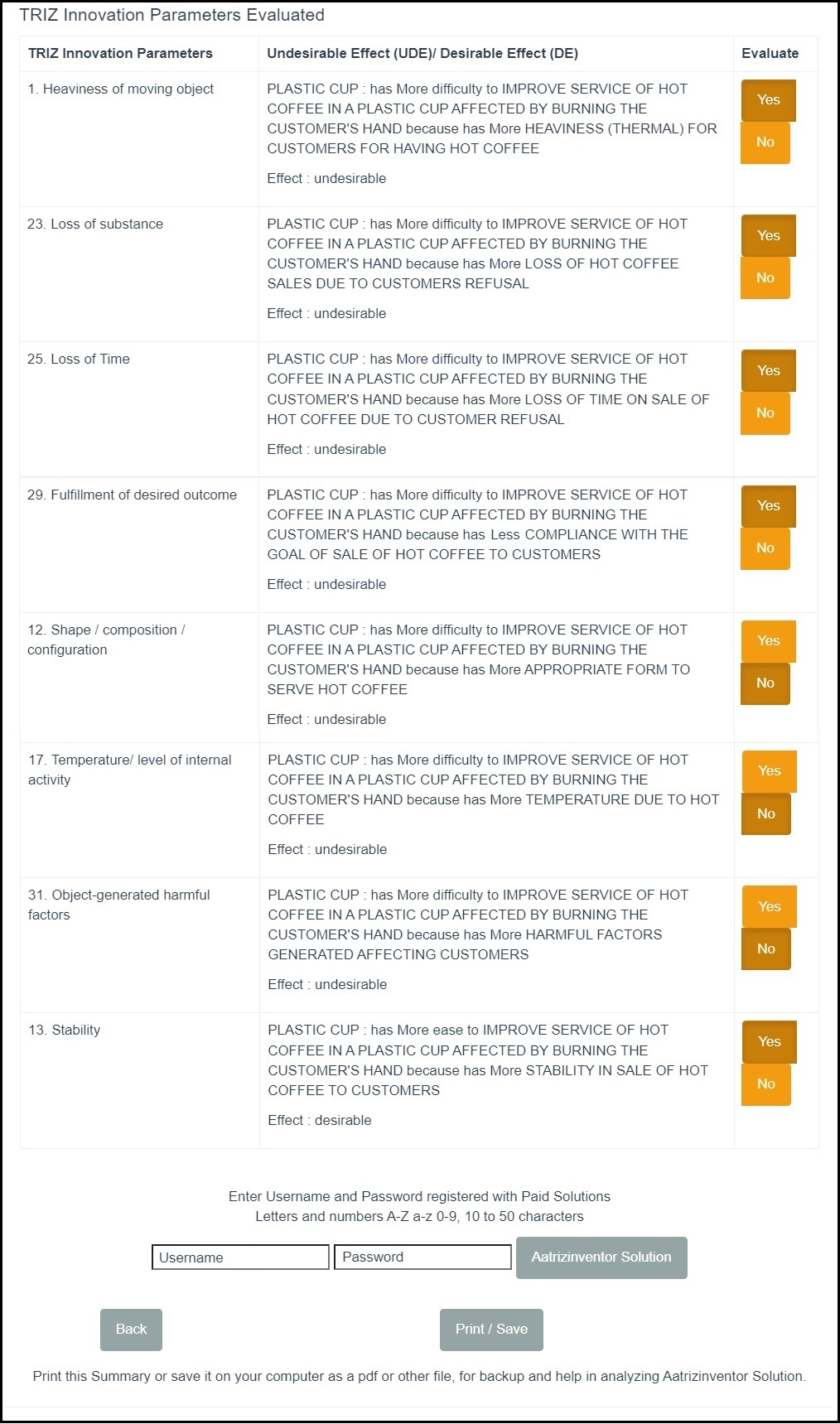
The buttons shown at the end of the Formulation Logic Report have the following use:
Aatrizinventor Innovation Solution: If you are satisfied with the logical formulation that you have made for your innovation challenge or problem, then by clicking on this
button you can obtain a report with the most convenient recommended solution, consistent with the information entered.
If you decide to request an Aatrizinventor Solution
you must enter your Username and Password, previously registered in the link shown on the main page. In addition, you must have paid for the use of Aatrizinventor solutions
through a link that is also available on the main page.
Back: Return to the formulation stage if you need to make any changes to the information entered.
Print / Save: Allow you to print or get a pdf file of the displayed logic report to save. This will be necessary as help in analyzing Aatrizinventor Solution,
if you choose to request it.
"Website www.aatrizinventor.com does not include a database service to archive the information entered with the evaluations you conduct. It will only record the
information necessary to demonstrate compliance with the requested service.
C. SOME COMMENTS ON THE FORMULATION OF THE INNOVATION CHALLENGE OR PROBLEM
The innovation parameters indicated in the table above will correspond, in the first evaluation, to the Innovation Team's own selection,
based on their knowledge of the innovation challenge they wish to evaluate. Undesirable effects are related to the problems or limitations of the current
situation, obtained as recommended in Topic 8 of the Manual and expressed in a mental map as indicated in Topic 11, MMEC diagram. The desirable effect
indicated corresponds to the best estimate of a need to satisfy that the Innovation Team believes necessary should be solved."." The Aatrizinventor
algorithm will evaluate the innovation parameters that the Innovation Team freely selects with the option 'Yes' and will deliver a solution, hoping that this
selection reflects the best knowledge to solve the innovation challenge.
My experience indicates that the initial selection is not always the most convenient. Therefore, and additionally, the algorithm proposes other solution alternatives, resulting from the sensitivity analysis that is carried out with the up to 7 undesirable effects identified and the 10 desirable effects that have been defined, which means analyzing 350 viable solutions and recommending the 10 most feasible. . It is advisable to review some of them, with a new run of the algorithm, because they can add useful complementary effects that enrich the solution
already obtained or eventually provide another perspective, which could be more convenient for the particular case evaluated.
" My experience indicates that the initial selection is not always the most convenient. Therefore and additionally, the algorithm proposes other solution alternatives, resulting from the sensitivity analysis that is carried out with the up to 7 undesirable effects identified and the 10 desirable effects that have been defined, which means analyzing 350 possible solutions and recommending the 10 most feasible.
As an example, my initial selection for the case of hot coffee in a plastic cup, with my engineering paradigm, was that the undesirable effects to evaluate for the Plastic Cup would be: (+) N°temperature of the plastic cup due to the hot coffee, parameter N°17;
(+) damages generated by burning the Customers' hand, parameter N°31;
(-) appropriate way to serve hot coffee, parameter N°12;
and (-) compliance with the expected results of the hot coffee service in a plastic cup, parameter No. 29.
The desirable effect seemed to me to be:
(+) Ease of operation, parameter N°33.
Everything looks pretty reasonable.
" However, Aatrizinventor prioritizes a solution, see Topic 14, which shows a business approach, less technical. It highlights the undesirable effects associated with the business, such as failure to meet the sales goal, parameter No. 29; the 'weight' of the plastic cup for carrying hot coffee, which limits its movement towards the
clients, parameter N°1; the decrease in coffee consumption, that is, sales losses, parameter No. 23; and the loss of time generated by the impossibility of lifting the extremely hot plastic cup, limiting the rotation of sales that affects their profits, parameter No. 25. The logic of the solution recommended by Nature's L.I. has overwhelmingly
a lot of common sense. It didn't match 'my common sense'.
The recommendation deduced from this experience is as follows: Do not rule out any undesirable
effect that there is evidence that is present in the innovation challenge or problem.
The prioritized solution that has been mentioned, to serve hot coffee in a plastic cup, is the one detailed in Point 14 of this Manual.
D. TYPES OF INNOVATION: BY EVOLUTION - BY IMAGINATION - BY IMPOSITION
As a first innovation action with Aatrizinventor to formulate an innovation challenge or problem to solve, the User of this methodology must choose what type of
innovation he wishes to apply, according to the three types proposed by Nature's L.I. and shown with examples in Topic 9 of this Manual:
Innovation solution by evolution
Innovation solution by imagination
Innovation solution by evolution
"For the same innovation challenge or problem to solve, the undesirable effects are not the same for the different types of innovation defined, so the formulation
will be decisive to obtain a good and ideally disruptive solution.
In short, to obtain the solution proposed by Aatrizinventor, the following conditions must be met:
A. The Aatrizinventor algorithm is applied, including all the undesirable effects determined in the table shown in Topic 8 (maximum 7 parameters).
B. Prior to executing the application, the Innovation Team will select the undesirable effects to be evaluated, according to its best consideration (minimum 2 and maximum 4), represented by the associated TRIZ innovation parameters. Undesirable effects not selected for evaluation will be considered for sensitivity analysis, with their corresponding TRIZ innovation parameters. The texts of undesirable effects (UDE) can be written in full or abbreviated and summarized, as decided by the evaluator.
C. The Innovation Team will select for the evaluation a need to satisfy, one of the 10 defined, according to its best consideration, expressed as a TRIZ innovation parameter. The text of the associated desirable effect (DE) can be written in full or abbreviated and summarized, depending on what the evaluator decides.
D. Once the aforementioned information has been entered, the logical analysis of said information must be executed, requiring the Logical Formulation Report, which is obtained in Aatrizinventor, Step 5: 'Review Logic', which is free. The review of the logic considers verifying that the Report describes verifiable evidence that the undesirable effects are generated by the Object S1 under evaluation, affecting the function to be improved, when it interacts with the Object S2. Only if the Innovation Team is satisfied with the formulated logic, then it is recommended to continue with the evaluation process.
E. If you decide to request an Aatrizinventor Solution that proposes a solution to the innovation challenge that has entered the algorithm, then, if you have paid solutions, you must enter your User Name and Password that you have registered and click on the button 'Aatrizinventor Solution'. This will open a window where the required solution will be displayed. This solution should be printed or filed on your computer or device, for review and analysis. If you do not print or save and exit this screen, you will lose the solution obtained and you will have to redo the process. For any questions send an email to the Website Administrator.
The information contained in The Aatrizinventor Solution is reviewed below, using the case of 'Improve hot coffee service in a plastic cup affected by burning a customer's hand' as a reference.
SECTION 1. Information entered
This section shows the information entered during the formulation of the innovation challenge. The information provided below does not have the abbreviated or summarized descriptions that you could apply if you find it convenient. Remember that later you must open said information so that you can conduct the private analysis of the innovation challenge that you are evaluating.
AATRIZINVENTOR SOLUTION
Open TRIZ Second Wave Chile SpA
FACTORS OF INNOVATION:
ACTION VERB: IMPROVE
FUNCTION AFFECTED: SERVICE OF HOT COFFEE IN PLASTIC CUP AFFECTED BY BURNING THE CUSTOMERS' HAND
PHYSICAL VARIABLE OR CHARACTERISTIC: SAFETY TO SERVE HOT COFFEE TO CUSTOMERS
S1 OBJECT: PLASTIC CUP Type: Moving
S2 OBJECT: CUSTOMERS Type: Moving
INNOVATION CHALLENGE
OBJECTIVE: IMPROVE SERVICE OF HOT COFFEE IN PLASTIC CUP AFFECTED BY BURNING THE CUSTOMERS' HAND
DESIRED GOAL: More SAFETY TO SERVE HOT COFFEE
EVALUATED OBJECT: PLASTIC CUP
NEED TO SATISFY > 13. Stability
LOGICAL ANALYSIS:
A. UNDESIRABLE EFFECTS CAUSES OF DISSATISFACTION
Context for evaluated object: PLASTIC CUP
There are More difficulty to IMPROVE SERVICE OF HOT COFFEE IN PLASTIC CUP AFFECTED BY THE BURNING CUSTOMERS' HAND because:
PLASTIC CUP Has More HEAVINESS (THERMAL) FOR CUSTOMERS FOR HAVING HOT COFFEE
PLASTIC CUP Has More LOSS OF SALE OF HOT COFFEE DUE TO CUSTOMERS REFUSAL TO CONSUME
PLASTIC CUP Has Less COMPLIANCE WITH THE GOAL OF SELLING HOT COFFEE TO CUSTOMERS
PLASTIC CUP Has More LOSS OF TIME ON SALE OF HOT COFFEE DUE CUSTOMERS REFUSAL TO CONSUME
There are undesirable effects that cause dissatisfaction because:
There is Less SAFETY TO SERVE HOT COFFEE
B. DESIRED EFFECT FOR NEED TO SATISFY
Context for evaluated object: PLASTIC CUP
There is More ease to IMPROVE SERVICE OF HOT COFFEE IN PLASTIC CUP AFFECTED BY BURNING THE CUSTOMERS' HAND because:
PLASTIC CUP Has More STABILITY TO SERVE HOT COFFEE TO CUSTOMERS
There is desirable effect for need to satisfy because:
There is More SAFETY TO SERVE HOT COFFEE
>Table I. RELATIONSHIP WITH TRIZ INNOVATION PARAMETER
OBJECTIVE: IMPROVE SERVICE OF HOT COFFEE IN PLASTIC CUP AFFECTED BY BURNING THE CUSTOMERS' HAND
This table identifies the TRIZ innovation parameters that will be evaluated and their associated undesirable effects, along with the parameter that represents the chosen need to satisfy. Additionally, parameters are included for sensitivity analysis with the 10 desirable effects defined, which will allow prioritizing 350 solutions, the result of which is presented in Table VI of the report. The sensitivity analysis is applied when more than 2 undesirable effects are determined to be evaluated, which can be up to a maximum of 7. The Innovation Team chooses a minimum of 2 for evaluation and the others entered remain for sensitivity analysis.
Below is Table I. for the case of Improving service of hot coffee in a plastic cup.
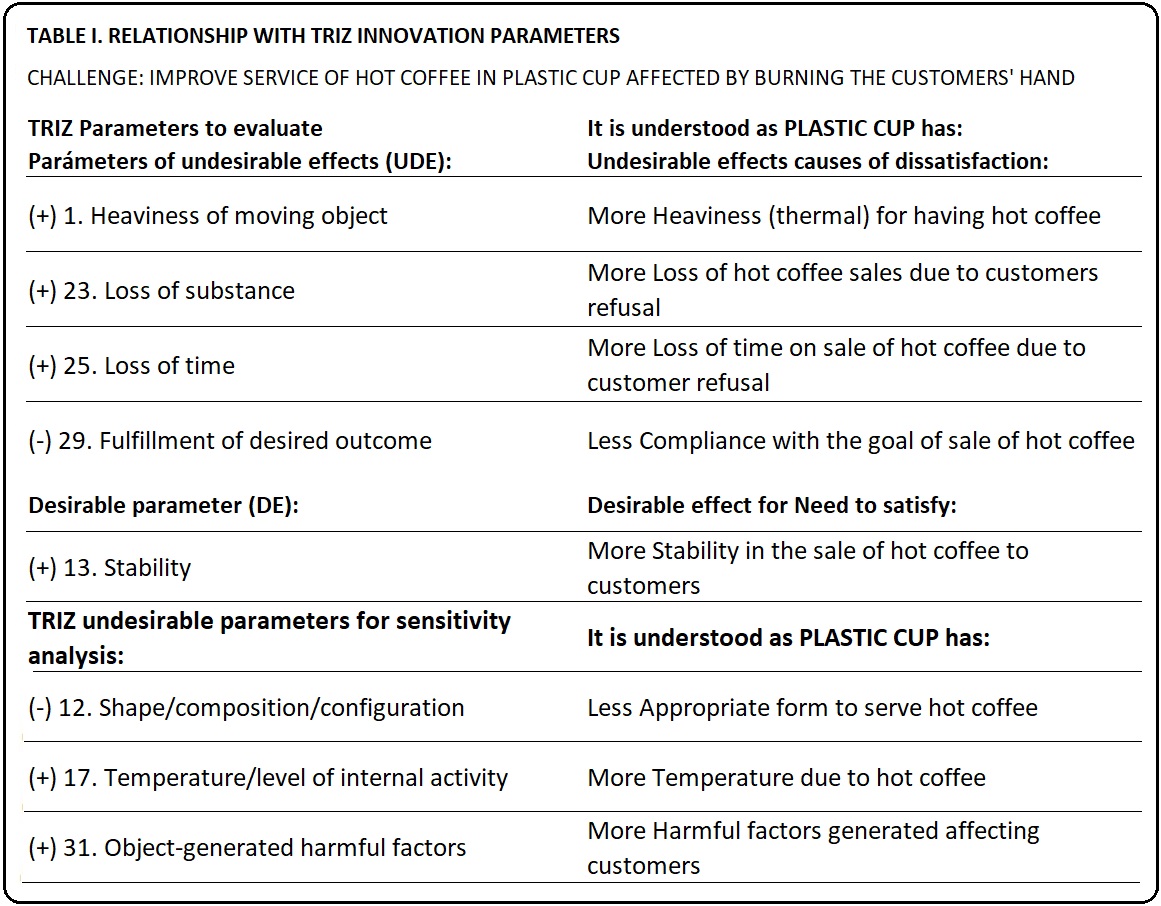
SECTION 2. Prioritizing Contradictions
This section shows the Tables of information resulting from the analysis conducted by the Aatrizinventor
algorithm. The algorithm analyzes the contradictions between the selected TRIZ innovation parameters, which will make it possible to formulate the
most probable solution to solve the innovation problem or challenge under evaluation.
To facilitate a first reading of the contradictions
indicated in this section, below is a table with the inventive principles that could participate in the recommended solution to Improve
service of hot coffee in a plastic cup. In Table IX, more details of these principles are provided in the Aatrizinventor Solution report. In Startup Manual you can review complete descripcion of inventive principles.
The tables shown in this section may seem like just numbers, but practice with this methodology will teach you that the numbers 'speak', that is, they describe the solution. The magic that inventive principles have is that they are universally applicable, so when you master the 40 descriptions of these principles (you don't need to memorize them), the Tables will give you a precise and global vision of the solution that the algorithm proposes. Don't worry , Remember that practice makes perfect.

TABLE II. SPECIFIC CONTRADICTION MATRIX FOR EVALUATED OBJECT
OBJECTIVE: IMPROVE SEVICE OF HOT COFFEE IN PLASTIC CUP AFFECTED BY BURNING THE CUSTOMERS' HAND
This Table brings together the contradictions between the selected TRIZ innovation parameters, obtained from the
TRIZ Classic Matrix created by Genrich Altshuller, showing the inventive principles (IPs) that solve each contradiction. The results of the
prioritization analysis conducted by the Aatrizinventor algorithm are also given here, which calculates the weight of each contradiction, indicated
as wt.n, with a correlative n, where wt.1 is the one with the greatest weight. The table highlights the following:
A. wt.1 CE it is the essential contradiction, which makes the greatest contribution to solving the innovation challenge. From this the
algorithm begins to build the solution. It can appear in any position in the matrix, although it will usually be in the row or column of the
preferred parameters, which are explained below.
B. Preferred parameters that highlight their names in black, show the row and column of the matrix that contribute the most to build the solution.
C. Complementary contradictions c.c marked with a solid line which are the existing contradictions in the row and column of preferred
parameters, which are the second analysis front to build the solution. The algorithm selects these contradictions from higher to lower weight, that
is, by ascending numbering.
D. wt.n Top5 that identifies the 5 five most important contradictions, marking with a dotted line those that are outside the row and column
of preferred parameters. They stand out for secondary analysis of the Innovation Team.
E. Sum (wt) which corresponds to the weighted sum of the weights of the contradictions existing in the rows and columns. They allow to
identify the preferred parameters.
Table II is shown below for the case of Improving service hot coffee in a plastic cup.

RECOMMENDED GENERAL SOLUTION FOR NEED TO SATISFY> 13. Stability
OBJECTIVE: IMPROVE SERVICE OF HOT COFFEE SERVICE IN PLASTIC CUP AFFECTED BY BURNING THE CUSTOMERS' HAND
Table III is shown below for the case 'Improve service of hot coffee in a plastic cup', which shows the most
relevant contradictions included in Table II to solve the innovation challenge under evaluation.

This Table provides the fundamental coverage of the innovation challenge in evaluation, which provides direction
and focus to find the solution. It will mostly include strategic inventive principles, 15, 35, 10, 28, 26, 32 and 3 in this case, and to a much
lesser extent, but no less important, inventive principles tactics, 18 only in this case, and operative inventive principles, 5, 20 and 31 in this example.
In Table VI the description of the inventive principles contained in the contradictions indicated in this table will be seen.
TABLE IV. MATRIX OF CONTRADICTIONS BETWEEN PAR. 13. Stability and the other NEEDS TO SATISFY
OBJECTIVE: IMPROVE SERVICE OF HOT COFFEE IN PLASTIC CUP AFFECTED BY BURNING THE CUSTOMERS' HAND
This Table shows the contradictions that must be solved to improve the need to satisfy selected, 13.
Stability in this case, without affecting the other needs to satisfy for Object S1 evaluated. For example, the stability of serving hot coffee in a
plastic cup cannot be improved by affecting the ease of operation for serving hot coffee.
"Nature's L.I. establishes as an optimization criterion for the solution to apply a minimum of inventive principles, is that the principles included
in the specific solution matrix Table II., which evaluates a need to satisfy and the selected undesirable effects, cover the principles included in
the matrix of contradictions between the needs to satisfy, shown in TABLE IV. This criterion is measured in weighted percentage of coverage and is
shown at the end of Table IV. This coverage is also expressed graphically in Table IV. as follows:
Inventive principles marked with a
solid lines are not included in Table II. Up to the first 3 contradictions in which they participate will be considered relevant for the solution, as
already indicated in Table III.
Inventive principles marked with dotted line are included in Table II., But do not participate in the base solution of Table III. The Innovation
Team must evaluate the convenience of reviewing the contradictions where they participate, to determine other significant aspects for the solution.
Unmarked inventive principles are included in Table V. Recommended general solution.
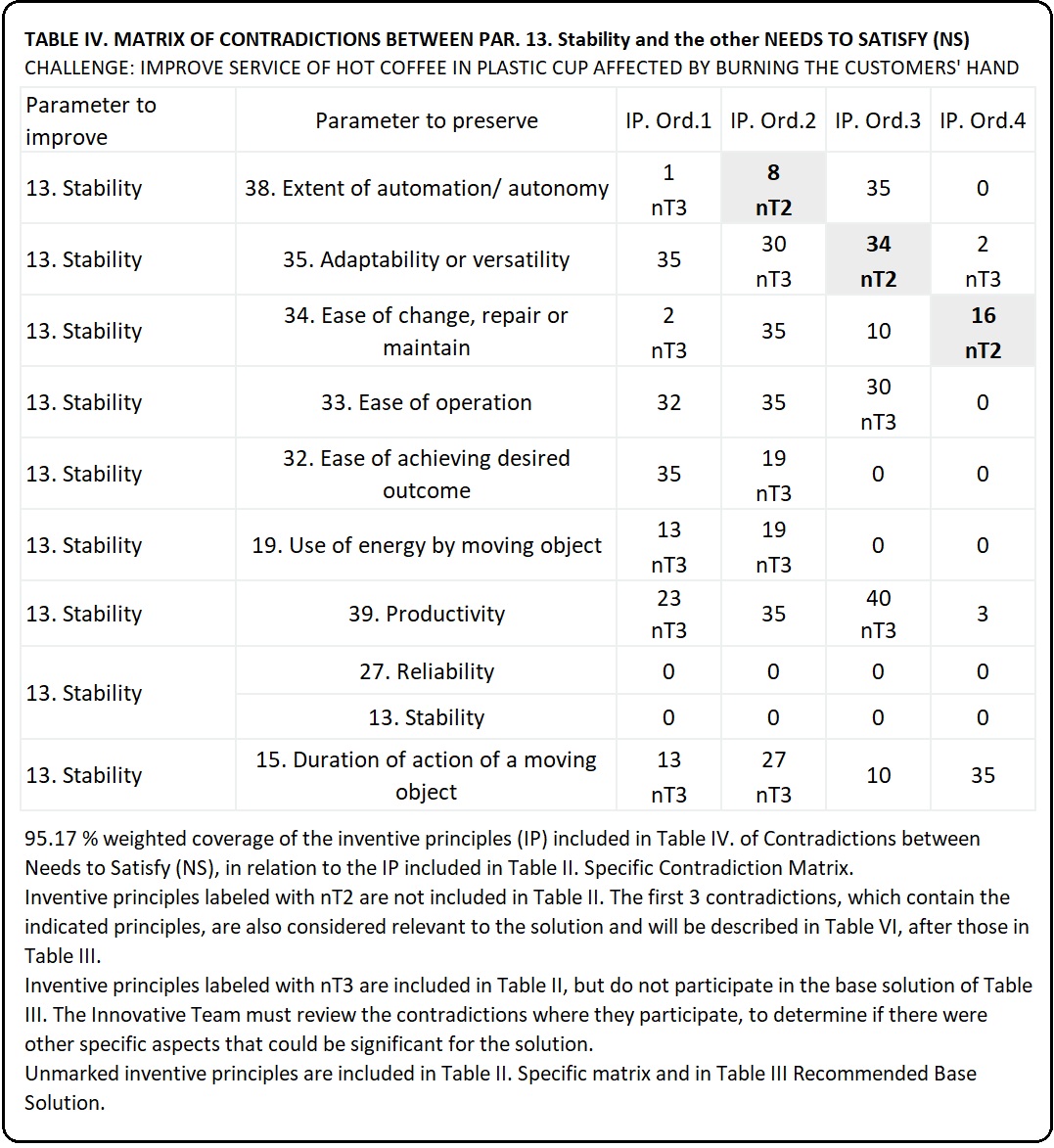
TABLE V. MATRIX OF ESSENTIAL CONTRADICTIONS FOR NEEDS TO SATISFY (NS)
OBJECTIVE: IMPROVE SERVICE OF HOT COFFEE IN PLASTIC CUP AFFECTED BY BURNING THE CUSTOMERS' HAND
Table V, provided by the Aatrizinventor algorithm in its solution report, summarizes the recommended solution, incorporating the recommended contradictions
from Table III and Table IV. Additionally, it includes a list of the 3 most relevant inventive principles involved in Table II that are not included in the contradictions of Tables III and IV.
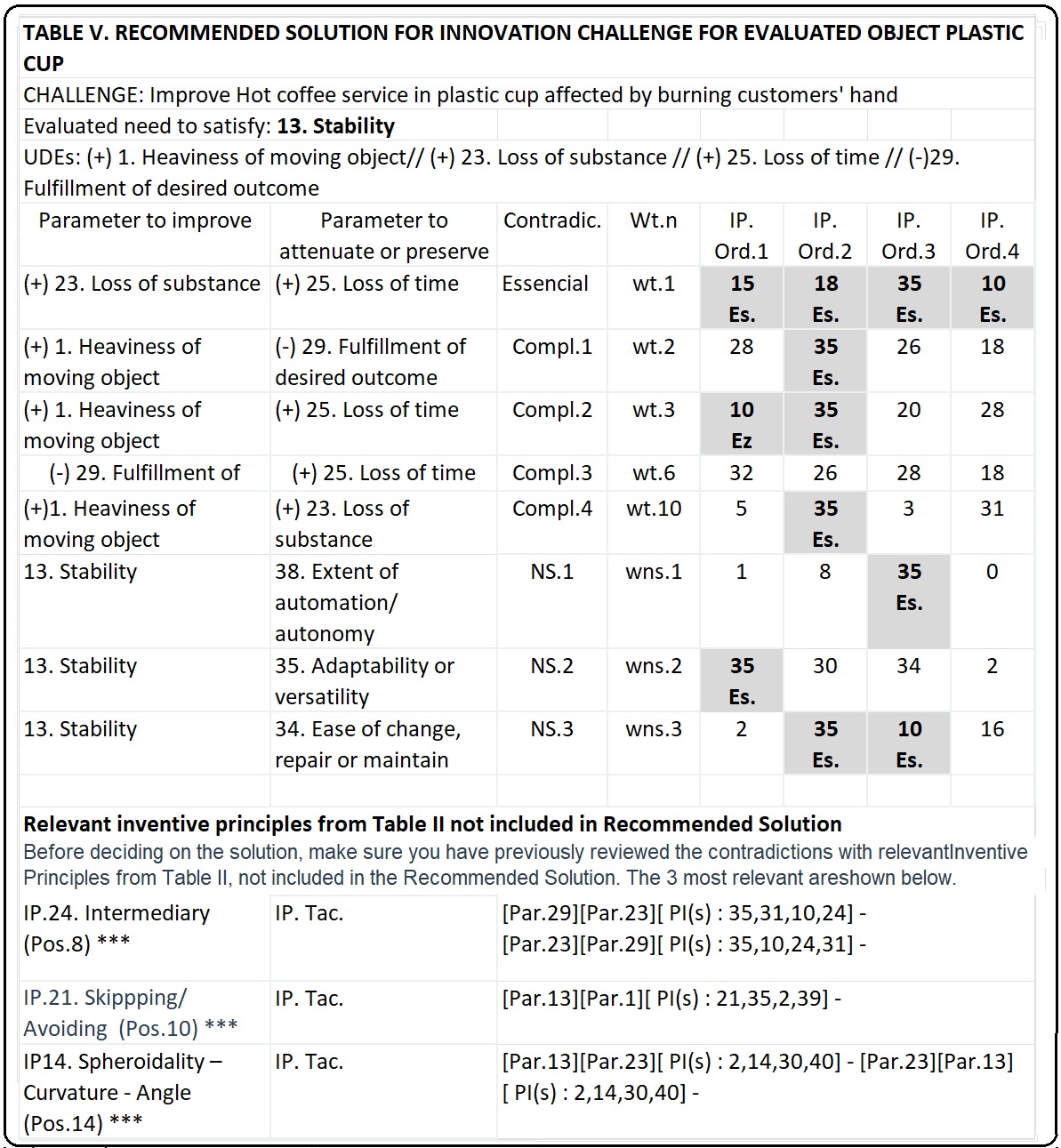
This Table enables the construction of a solution for the innovation challenge under evaluation, derived from the selected innovation parameters for assessment.
For an initial approach to the solution, following Table V, a list with a summarized description of the inventive principles included in this Table is provided, organized by each of the recommended contradictions.
The method for constructing a specific solution with this information can be found in the Startup Manual, Aatrizinventor Fundamentals, Section 11 Building a Specific Solution, for the case of serving hot coffee in a plastic cup.
TABLE VI RESULTS OF SENSITIVITY ANALYSIS FOR THE EVALUATED OBJECT PLASTIC CUP
OBJECTIVE: IMPROVE SERVICE OF HOT COFFEE IN PLASTIC CUP AFFECTED BY BURNING THE CUSTOMERS' HAND
The Aatrizinventor algorithm provides a solution prioritizing the inventive principles and contradictions of an innovation
challenge based on a sequence of mathematical calculations, which has demonstrated numerical stability when applied with up to 4 parameters of undesirable
effects and only one parameter of need to satisfy.
In the practical cases of innovation evaluated, it has been seen that when the possible undesirable effects
that apply to a given innovation challenge are reviewed (tables 1 or 2 of Topic 8 of this Manual), more than 4 of them are commonly identified, which may be
independent or dependent on each other, all being evaluable.
Whatever their dependence, the inventive principles that solve the contradictions in
which these undesirable effects participate, expressed as TRIZ innovation parameters, are different, therefore there is no redundancy in the analysis, on the
contrary the solution is more powerful.
"On the other hand, the selection of the need to satisfy to evaluate is not simple. Our experience indicates that there is a need to satisfy that provides the
best solution, a need that does not necessarily coincide with our 'common sense'.
"Accepting the above, Aatrizinventor performs a sensitivity analysis, prioritizing different combinations for a format of a need to satisfy, of 10 in total,
and 4 undesirable effects causes of dissatisfaction, out of a maximum of 7 effects entered. The result of this analysis recommends the 10 most effective
combinations, out of a total of 350 evaluated combinations, prioritized according to the coverage criteria explained above in Table V.
Below is the sensitivity analysis carried out for the case of 'Improve service of hot coffee in a plastic cup', whose most effective solution has been described above in
this Topic. The combination of TRIZ parameters used by the evaluated solution is included in the Sensitivity Analysis Table, marked with (E),
occupying the first priority position. When you have doubts with the solution that results from the TRIZ parameters that you have initially selected to obtain a solution,
review Table VI, it is recommended to try one of the combinations that are shown, usually one among the first three of Table VI.A or first two of Table VI.B. Do not get carried
away by your paradigms, for example, in the case of hot coffee, the selected solution discards the temperature parameter, since it prioritizes the heaviness for the client
to move the plastic cup because it is hot, a slight difference that improves the focus of the solution. Do not forget, apply relational thinking to innovate and consider
the 'S' curve of evolution of innovation for your decisions.
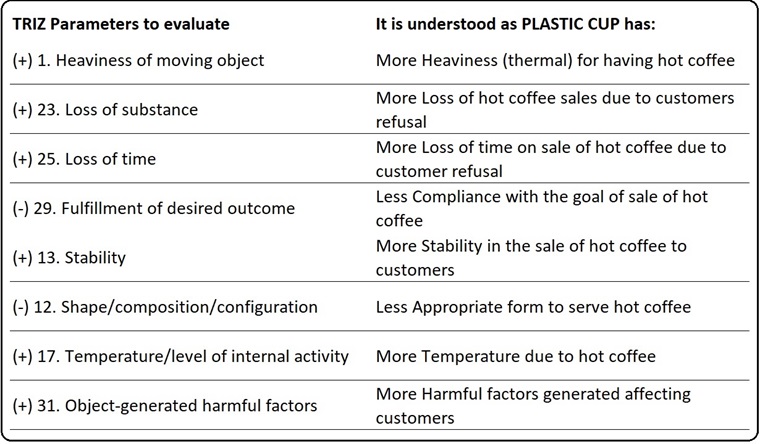

The sensitivity analysis has been completed for the case of improving the service of hot coffee in a plastic cup affected by burning the customer's hand,
obtained with the parameters entered by the Innovation Team. This is the first moment for the Innovation Team to decide, asking themselves the following: Is there a solution
in sight? Are there innovation concepts that make us think beyond the current situation? Is a line of development distinguished? Is it consistent to formulate an innovative
solution? If the answers generate confidence, the Innovation Team must dare to take the next step: Formulate a specific solution with the contradictions selected by
Nature's L.I., plus others that are estimated could be a contribution. Otherwise, they should go back to the algorithm and try the solutions proposed by the sensitivity
analysis. If that doesn't work either, find another approach, another pair of objects. The problem has not disappeared, it is still there, for Nature's L.I. there will be
a solution. Reframe the challenge, nothing is impossible.
TABLE VII. ESSENTIAL CONTRADICTIONS MATRIX FOR NEEDS TO SATISFY (NS) FOR THE SAME UNDESIRABLE EFFECTS EVALUATED OF: PLASTIC CUP
Below is Table VII, which shows the essential contradictions obtained for each of the defined Needs to Satisfy, considering the same undesirable effects that have been evaluated, not including those considered for sensitivity analysis.
This table is based on the calculation of a global coverage (Cob.GL), which is determined by combining two values: the coverage from Table IV (Cob.NS) already explained, and a relative coverage (Cob. between CE) obtained in this Table VII by comparing the essential contradictions identified for the 10 parameters of Needs to satisfy.
This global coverage (GL) is based on expert weighting criteria to prioritize solutions for the various Needs to Satisfy. Experience with aatrizinventor indicates that the most effective solutions are those with higher global coverage, preferably exceeding 90%.
The Innovation Team may decide whether it is advisable to conduct a new evaluation with another Need to Satisfy, selected from the results provided in Table VII. This decision will be made primarily when the evaluated Need to Satisfy is not classified among the three highest positions in the Table. In this table, the position of the evaluated Need to Satisfy for the case of serving hot coffee in a plastic cup is highlighted:13. Stability.

TABLE VIII. ORDER OF INCIDENCE OF INVENTIVE PRINCIPLES (Pos.n)
OBJECTIVE: IMPROVE SERVICE OF HOT COFFEE IN PLASTIC CUP AFFECTED BY BURNING THE CUSTOMERS 'HAND
This table presents the inventive principles involved in TABLE II. SPECIFIC CONTRADICTION MATRIX FOR EVALUATED OBJECT,
ordered by level of incidence, depending on the position that an inventive principle occupies in each contradiction and the number of contradictions in which it
participates. The first principles of the list will normally be of the strategic type. The most interesting thing about this table is the order in which the
tactical and operative principles appear. The information contained in this table allows to support the solution that can be deduced from Table VI. and,
eventually, consider a more detailed review of any additional contradiction in Table II., which may be a significant contribution to the solution.
"Particularly in the example case shown in this Topic of the Manual, referring to the Hot coffee service in a plastic cup, it can be seen that the first operative
principle that appears in the table below is IP.5. Merge/Separate, which participates in complementary contradiction N°4 and which among its options recommends that Innovated
Plastic Cup consider merging with another object that can act together at the same time. Whereas the second tactical principle that appears is IP.30. Simple Forms
/Ways to Interact (IP.18, take it and leave it, it is not enough), which participates in contradiction between needs to satisfy N°2 and which among its options recommends that innovated plastic cup be insulated
with flexible sheets. This is complemented by the inventive principle IP.34. Discard/Recover, which comes next in this last-mentioned contradiction, which among
its options recommends that the parts of the Innovated Plastic Cup that have fulfilled their functions, or are no longer necessary, be discarded.
"You will be able to see that the fundamentals of the solution to the evaluated innovation challenge have been described: Place a disposable cardboard sheet that
covers the plastic cup on the outside, see IP.31, so as not to burn the customers. This sheet that will later be discarded, like the plastic cup. Thus, the other
contradictions described will provide the strategy and tactic to follow for a successful application of the aforementioned solution. In other words,
a solution of minimum cost and maximum benefit / cost ratio is obtained.
"This is the great virtue of Nature's L.I., it brings speed and focus to the process of solving multivariable innovation challenges.
QUANTITATIVE ANALYSIS OF INVENTIVE PRINCIPLES INCLUDED IN TABLE II. SPECIFIC CONTRADICTION MATRIX
"Evaluated parameters:
"UDEs: (+) 1. Heaviness of moving object// (+) 23. Loss of substance// (-) 29. Fulfillment of desired outcome// (+) 25. Loss of Time// NS: (+) 13. Stability//
"*** : Inventive principles for further review, not described in Table VI. General Solution
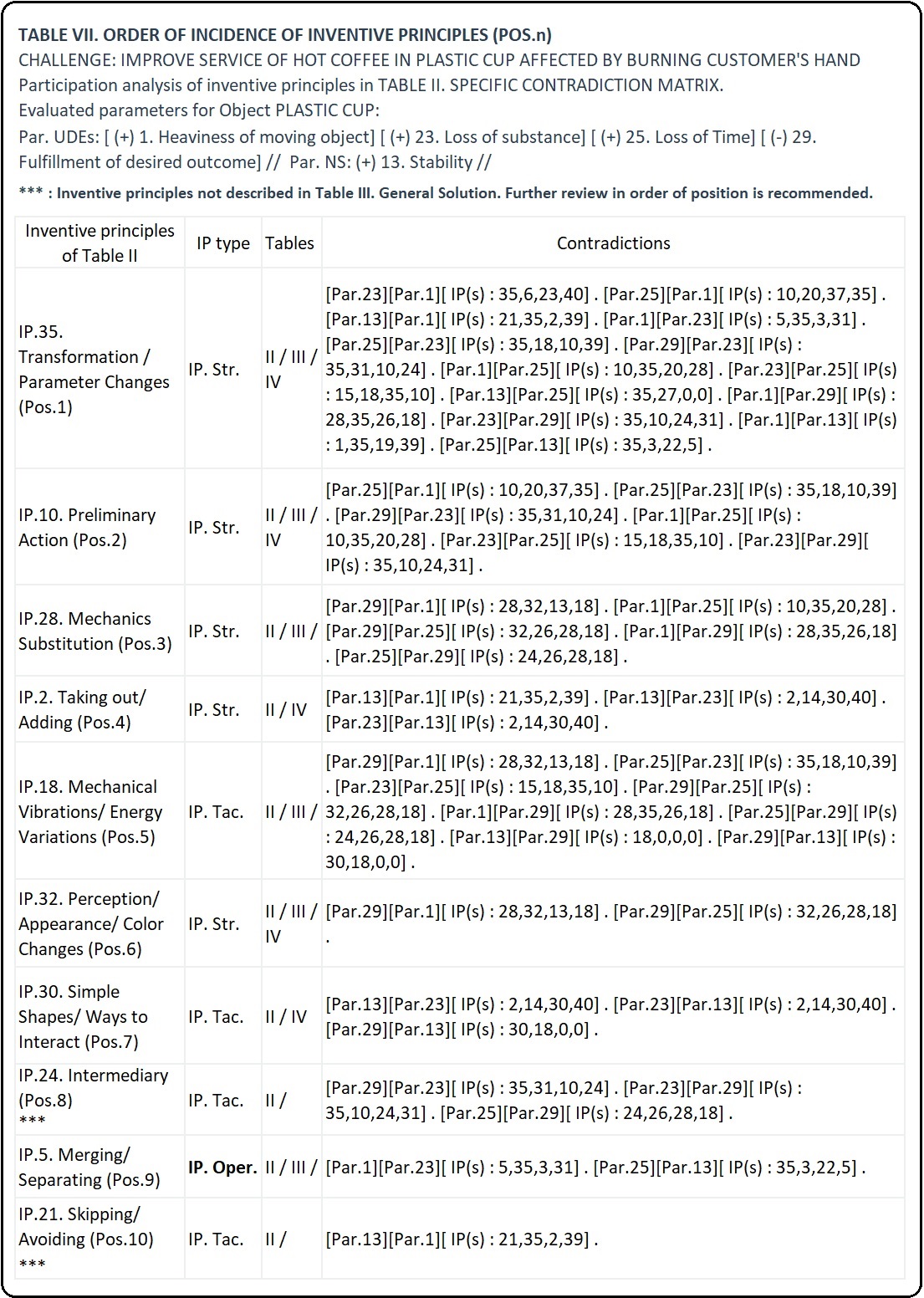

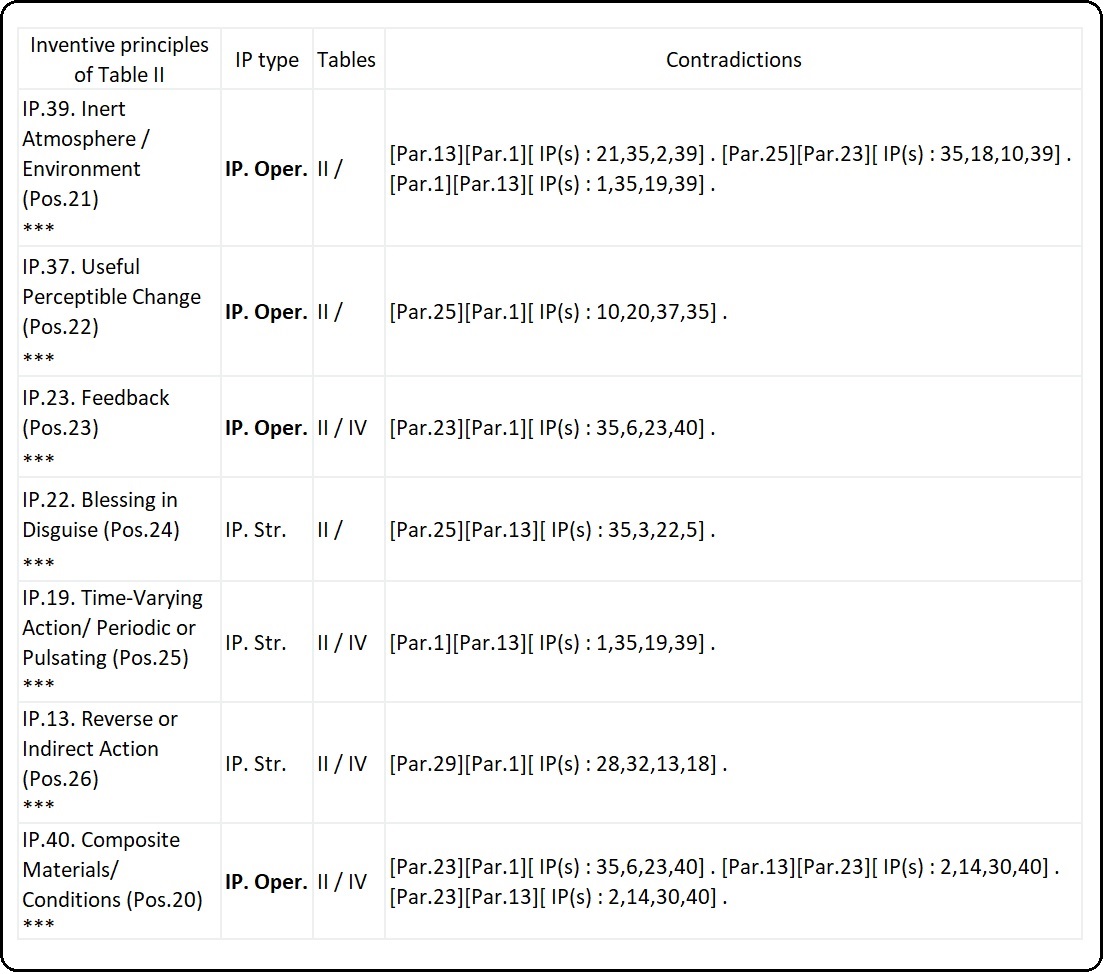
Inventive principles included only in Table II.
To decide the solution, make sure you have previously checked the contradiction(s) with Inventive Principles included only in Table II.
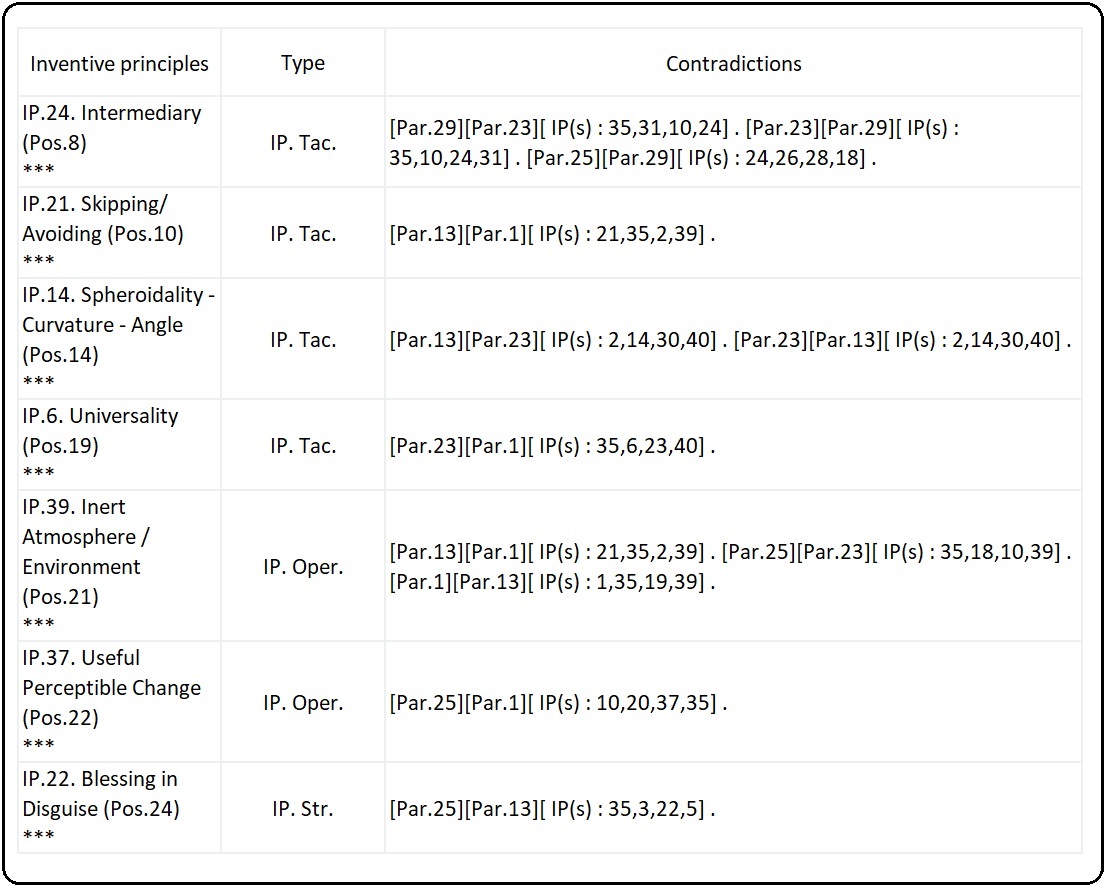
Inventive Principles of Table IV not included in Table II.
To decide the solution, make sure you have previously checked the contradiction(s) with Inventive Principles included only in Table IV.
IP.8. Anti-Weight/ Compensation, IP. Tac.
Contradiction: [ Improve 13. Stability] [ Preserve 38. Extent of automation/ autonomy][ IP(s): 1,8,35,0]
IP.34. Discarding and Recovering, IP. Tac.
Contradiction: [ Improve 13. Stability] [ Preserve 35. Adaptability or versatility][ IP(s): 35,30,34,2]
IP.16. Partial or Excessive Actions, IP. Oper.
Contradiction: [ Improve 13. Stability] [ Preserve 34. Ease of change, repair or maintain][IP(s): 2,35,10,16]
To the extent that this list contains a greater number of inventive principles, it will usually be more difficult to understand the solution proposed by Aatrizinventor and therefore difficult to implement. When in doubt, it is advisable to rethink the formulation of the challenge being evaluated.
Review the selected undesirable effects, verifying that the corresponding evidence exists and check if there is any other undesirable effect that was not initially considered. Finally, try some of the parameter combinations recommended by the sensitivity analysis, whose results for the case of hot coffee in a plastic cup are shown below in Table VI.
In the next Section, the exercise of constructing the specific solutions for all the cases presented in Topic 8 of the Manual will be carried out. The
Aatrizinventor Solution of these cases are delivered in the link shown above 'Enter to Algorithm'/'Aatrizinventor Examples'.
SECTION 3. Searching a Solution
TABLE IX. GENERAL SOLUTION ACCORDING TO THE MOST RELEVANT IDENTIFIED CONTRADICTIONS
OBJECTIVE: IMPROVE SERVICE OF HOT COFFEE SERVICE IN PLASTIC CUP AFFECTED BY BURNING THE CUSTOMERS' HAND
This Table shows the relevant contradictions already identified, which determine the direction and scope that
the solution to the innovation challenge under evaluation can cover. The general solution emerges from the inventive principles updated with a
universal description, which are detailed below, deduced from the solutions of the world, whose conceptual root arises from nature, postulated by
Nature's L.I.
To obtain a quality solution, the Innovation Team will be required to use all the knowledge acquired from the current situation of the innovation
challenge, which allowed them to formulate it and apply their relational thinking skills to the maximum. The solution that is postulated with the
inventive principles indicated in this Table, must be complemented with a review guided by such principles of all the others that participate in
this challenge, by level of incidence and type: strategic - tactical - operative, as detailed in Table VIII.
It should always be borne in mind, taking as reference the example case, that PLASTIC CUP is being evaluated when interacting with CUSTOMERS and
there is an affected function: SERVICE OF HOT COFFEE IN PLASTIC CUP AFFECTED BY BURNING THE CUSTOMERS' HAND, in a certain space and time. PLASTIC CUP
may require changes in space, time, physical composition or functional characteristics, partial or total replacement by another object or other
recommended change.
Each inventive principle described in table VI. may contain more than one recommended innovation concept,
identified as a, b, c, ... plus the applicable separation principles and solution strategies, then a rigorous review of each concept is required
associated with the corresponding inventive principles. The Innovation Team must select those innovation concepts that are best related to the evaluated innovation
challenge, according to its own knowledge and analysis of relational thinking that the Innovation Team must conduct and, if necessary, with the
support of third parties involved. It cannot be ensured that there is a single specific solution, then to determine a quality solution a
'Storm of solutions ' could be necessary, guided by the contradictions selected and bounded by the space and time defined for the evaluation.
The Innovation Team must have an open mind without paradigms to identify and apply in the specific solution these different scenarios
recommended by the inventive principles. It may also be necessary to reverse the evaluation, that is, evaluate CUSTOMERS instead of PLASTIC CUP. In
this new case, the undesirable effects to be evaluated may differ and the solution may have another orientation that could be easier to identify and
implement.
In the following descriptions of the inventive principles of the relevant contradictions, PLASTIC CUP is marked with an asterisk: PLASTIC CUP *, to
bear in mind that when reading an inventive principle, the object evaluated must be thought of changing to any of the following conditions: change
from status, condition or current situation, to a modified one, to a current one with new conditions or components added, or to a new one different
from the current one. Complete the reading of the inventive principles described below to determine the recommended change. As a result of the
innovation solution there will be a change in PLASTIC CUP, in a new context guided by inventive principles, not previously imagined".
Nature's Innovation Language brings speed and focus to people's innovative thinking, but it is not a substitute for it.
IX.A.- SOLUTION TO ESSENTIAL AND COMPLEMENTARY CONTRADICTIONS
NEED TO SATISFY: 13. Stability
Strategic Inventive Principles : IP Str.
Tactical Inventive Principles : IP Tac.
Inventive Operational Principles: IP Oper.
Pos.n : Order of incidence n of an inventive principle included in Table II. (see Table VIII.)
ESSENTIAL CONTRADICTION
Contradiction order wt.1
Parameter to improve: (+) 23. Loss of substance
=> IMPROVE (UDE): PLASTIC CUP has More LOSS OF HOT COFFEE SALES DUE TO CUSTOMERS REFUSAL TO CONSUME
Parameter to attenuate or preserve: (+) 25. Loss of Time
=> ATTENUATE OR PRESERVE (UDE):PLASTIC CUP has More LOSS OF TIME ON SALE OF HOT COFFEE DUE TO CUSTOMERS REFUSAL TO CONSUME
Inventive principles IP(s): [15,18,35,10]
15. Dynamics, Str. IP (Pos.11):
a. Allow (or design) the characteristics of PLASTIC CUP*, external environment, or process to change to an optimal, or to find an optimal, operating condition.
b. Divide PLASTIC CUP* into parts that are capable of relative movement between each other.
c. If PLASTIC CUP* (or process) is rigid or inflexible, make it flexible or adaptive.
Separation principle for PLASTIC CUP* : Separation in time
Solution strategy for PLASTIC CUP* : Improving attributes; Improving performance; Improving 7 quality factors (**); Improving if a solution has not yet emerged
18. Mechanical Vibrations/ Energy Variations, Tac. IP (Pos.5):
a. Cyclically move PLASTIC CUP* with energies that activate it.
b. Cause PLASTIC CUP* to oscillate or vibrate. Increase its frequency (even up to the ultrasonic). Use the resonant frequency of PLASTIC CUP*.
c. Use vibration-generating fields in, or for, PLASTIC CUP* instead of mechanical vibration generators. Combine sources of oscillations (e.g., ultrasonic, and electromagnetic).
Separation principle for PLASTIC CUP* : Separation in time
Solution strategy for PLASTIC CUP* : Improving 7 quality factors (**)
35. Transformation/ Parameter Changes, Str. IP (Pos.1):
a. Change PLASTIC CUP*'s physical or chemical state (e.g., in shape, in composition, to a gas, liquid, solid or plasma).
b. Change the composition or condition of PLASTIC CUP* by adding or removing components.
c. Change the concentration or consistency; change the degree of flexibility; change the temperature or the level of internal activity of PLASTIC CUP*.
Separation principle for PLASTIC CUP* : Separation by condition / Separation alternative
Solution strategy for PLASTIC CUP* : Improving attributes; Improving 7 quality factors (**)
10. Preliminary Action, Str. IP (Pos.2):
a. Perform the required change in, or for, PLASTIC CUP*, before it is needed (either fully or partially).
b. Pre-arrange PLASTIC CUP* and other objects, if necessary, in such a way that they can come into action from the most convenient place and without losing time for their delivery.
Separation principle for PLASTIC CUP* : Separation in time
Solution strategy for PLASTIC CUP* : Improving attributes; Improving performance
(**) Improving the 7 quality factors: Quality, Reliability, Maintainability, Supportability, Human Factors, Safety, Security
UNDERSTANDING THE SOLUTION OF A CONTRADICTION:
The solution to the contradiction described above, composed of inventive principles, tells a story that shows a consistent and determined thread of the proposed
general solution, where the knowledge expressed in the formulation of the problem or innovation challenge will be the basis for deciding a specific
solution.
For a correct interpretation of the solution of a contradiction, the first recommendation is to apply relational thinking, that is, for each inventive principle
that it includes, divided into innovation concepts detailed in its description with the letters a, b, c ... , You must be able to contextualize them, as
appropriate, in different areas, levels, dimensions, temporality, direction and / or sense in which they can be applied, always focused on the knowledge of the
innovation challenge in evaluation.
The innovation concepts indicated, a, b, c ... , can be applied independently or in a complementary way to each other. Some of them define more specific concepts
and others are broader, demonstrating in the latter case that there is the possibility of applying different solutions, depending on the case evaluated,
maintaining the general idea.
Additionally, the contradiction described above adds 3 more concepts, which help to define the specific solution, which are:
Types of inventive principles, proposed by Nature's L.I.
- Strategic inventive principles, which are the driving forces of change;
- Tactical inventive principles, which ensure the functionality required
for change; and
- Operational inventive principles , which allow change to work.
The strategic inventive principles are those that have the greatest participation in the TRIZ Contradiction Matrix, then the essential contradictions determined
by Nature's LI are mostly composed of this type of principles. For this reason, the essential contradiction provides general aspects of the solution, so the
Innovation Team must recognize and complete the review of all the contradictions selected by Nature's L.I., which will allow it to conceive a specific and
comprehensive solution for the challenge of innovation.
Relationship between TRIZ separation principles with inventive principles, proposed by Darrell Mann
- Principles of separation, which correspond to another TRIZ innovation technique to find solutions, which is applied here as a complement to the solutions
proposed by the inventive principles. These principles of separation are described in detail in Topic 2 of this Manual, being the following: Separation in time,
Separation in space, Separation according to condition and Separation between the parts and the whole. The latter is divided into: Separation by subsystems,
Integration in supersystem, Alternative separation and inverse or indirect separation. Each inventive principle is related to one or two separation principles,
whose practical recommendations facilitate the understanding of the solutions proposed by the inventive principles. This relationship to each inventive principle
is shown by end of each contradiction description selected by the Aatrizinventor algorithm.
Relationship between solution strategies and inventive principles, proposed by Darrell Mann
- Solution strategies, which correspond to known strategies in the management field to reach the solution with the evaluated object, which are associated with
the inventive principles, as explained in Topic 2 of this Manual. These recommendations are to improve attributes, improve performance / performance, improve quality
factors (quality, reliability, maintainability, compatibility, human factors, security, protection) and alleviate if a solution has not yet emerged. Each
inventive principle is related to one or more solution strategies, which facilitate the understanding of the solutions proposed by the inventive principles.
This relationship with each inventive principle is shown at the end of each contradiction description selected by the Aatrizinventor algorithm.
"Each contradiction delivers part of the general solution as a set of innovation concepts, contributed by the proposed TRIZ inventive principles, deduced from
the world's inventive solutions and that for Nature's L.I. they represent the Language of Innovation of Nature. The general solution that is obtained with all
the contradictions evaluated is not unique, since the solution will depend on several factors: existing knowledge, available resources and technological evolution,
to name a few. In order to obtain the most suitable specific solution, it will usually be necessary to conduct a 'Solution Storm'. This consists of analyzing
the selected general solution and deducing some alternative solutions that it is deemed necessary to consider, that meet the requirements established by the
selected inventive principles, within the evaluated space-time, to finally decide the specific solution that best solves the problem or challenge. of innovation
in evaluation.
Next, as an example, the analysis of the essential contradiction of the evaluated case is shown, applying the innovation concepts that deliver the inventive
principles contained in the contradiction and that contribute to improve the service of hot coffee in a plastic cup. The result of the contextualized analysis of
the contradictions selected for the cases presented in Topic 6 of this manual is shown in Topic 15. Building a specific solution.
CONTEXTUALIZED ANALYSIS OF ESSENTIAL CONTRADICTION
IP.15 Dynamic, strategic
It aims to improve the dynamics of the plastic cup with hot coffee. In the current situation the customers takes the cup and feels it burns, then drops it and
leaves it where it was. The first innovation concept of this inventive principle (a, b , c, ...) establishes that the current dynamics should be changed, the
second indicates that the innovated plastic cup could have parts that have a relative movement to each other, and the third indicates that the innovated plastic
cup should be flexible and adaptive. The IP.15 is formulating the strategy to be followed, but it is not yet possible to know which of the innovation concepts
will be applied to innovate, or a combination of them. Undoubtedly it is already possible to imagine some alternative solutions, but do not flag with none of
them, since the revision of the following contradictions and their inventive principles will define the solution.
Additionally, the separation principle tells us that the innovated plastic cup should have one condition at a certain time and a different one at another
time.
On the other hand, the solution strategy says that there could be different solution modalities: Improve attributes, improve performance, or
improve quality factors such as: quality, reliability, maintainability, supportability, human factors, security and / or protection.
IP.18 Mechanical Vibrations / Energetic Variations, tactical
It aims to generate a cyclical movement of the innovated plastic cup. Higher vibration levels would not apply in this case.
Additionally, the separation principle confirms that the innovated plastic cup should have one condition at a certain time and a different one at another
time.
On the other hand, the solution strategy says that it should improve some quality factors such as: Quality, Reliability, Maintainability,
Supportability, Human factors, Safety and / or Protection.
IP.35. Transformation / Change of Parameters, strategic
It aims to transform the current plastic cup or change its operating parameters. This is strategic inventive principle No. 1, which has the greatest impact on TRIZ's
Contradiction Matrix. In this case it is predictable that a physical transformation must be applied, which must be determined in conjunction with other inventive
principles and contradictions that participate in the solution. The inventive principles described above give an idea, but it still needs to be
refined.
Additionally, the principle of separation indicates two options: by condition or alternative. By condition it would apply if the plastic cup had different
temperatures in the evaluation period, a situation that does not occur. Then apply alternative separation, that is, there should be an innovated plastic cup
with some new added feature, which makes it more suitable to manage the current situation. more flexible and with a less harmful temperature for the hand, but
with hot coffee as the customers likes it.
On the other hand, the solution strategy says that the innovated plastic cup should have better attributes
and should improve some quality factors such as: Quality, Reliability, Maintainability, Supportability, Human factors, Safety and / or Protection
IP.10. Preliminary Action
It aims to define the opportunity in which the required changes should be made, this is preliminary or anticipated, either in action, composition and / or
disposition of its existing or new parts to be incorporated for the innovated plastic cup. In this case, the innovated plastic cup changes before the customers
takes it with his hand to drink hot coffee that revitalizes him.
"Additionally, the separation principle indicates that the innovated plastic cup could have a specific attribute at a certain time and a different one at another
time, that is, the plastic cup could change only before hot coffee is added to it.
On the other hand, the solution strategy says that the innovated
plastic cup should have better attributes and performance for the service provided.
The interpretation of the determined essential contradiction has been completed. The quality of this depends to a significant extent on the knowledge of the initial
situation and the disruptive level to be achieved. In general, the essential contradiction is more oriented to the strategy of the solution, then reading the
following contradictions will allow a more specific interpretation, those that include tactical and operative inventive principles.
COMPLEMENTARY CONTRADICTION 1
Contradiction order wt.2
Parameter to improve: (+) 1. Heaviness of moving object
=> IMPROVE (UDE): PLASTIC CUP has More HEAVINESS (THERMAL) FOR CUSTOMERS FOR HAVING HOT COFFEE
Parameter to attenuate or preserve: (+) 29. Fulfillment of desired outcome
=> ATTENUATE OR PRESERVE (DE) : PLASTIC CUP has Less COMPLIANCE WITH THE GOAL OF SELLING HOT COFFEE TO CUSTOMERS
Inventive principles IP(s): [28,35,26,18]
28. Mechanics Substitution, Str. IP (Pos.3):
a. Replace a direct or manual action in, or for, PLASTIC CUP*, with a mechanical action or a tool.
b. Replace a mechanical means in, or for, PLASTIC CUP*, with sensory (optical, acoustic, vibration, taste, smell, feelings or other sensory fields) means.
c. Use mechanical, pneumatic, hydraulic, electric, magnetic, and electromagnetic, chemical, biological, psychological or other fields to improve action of PLASTIC CUP*.
d. Change from static fields in, or for, PLASTIC CUP* to moving fields, from unstructured fields to those with structure, or vice versa.
e. Use fields in conjunction with field-activated parts, components, or particles (e.g., magnetic field and ferromagnetic particles) in, or for, PLASTIC CUP*.
Separation principle for PLASTIC CUP* : Separation by condition
Solution strategy for PLASTIC CUP* : Improving attributes
35. Transformation/ Parameter Changes, Str. IP (Pos.1):
a. Change PLASTIC CUP*'s physical or chemical state (e.g., in shape, in composition, to a gas, liquid, solid or plasma).
b. Change the composition or condition of PLASTIC CUP* by adding or removing components.
c. Change the concentration or consistency; change the degree of flexibility; change the temperature or the level of internal activity of PLASTIC CUP*.
Separation principle for PLASTIC CUP* : Separation by condition / Separation alternative
Solution strategy for PLASTIC CUP* : Improving attributes; Improving 7 quality factors (**)
26. Copying/ Replicating, Str. IP (Pos.13):
a. Instead of using PLASTIC CUP*, or any of its unavailable, expensive, fragile parts or properties, use simpler and inexpensive copies or replicates to perform the desired function and, if possible, do so with improved characteristics and properties, while disregarding the harmful, undesirable, or unnecessary ones.
b. Imitate PLASTIC CUP*, or any of its parts or properties, leveraging the relevant available environment.
c. If simple copies, or replicates are already being used, apply copies, or replicates of a higher level or technical complexity.
Separation principle for PLASTIC CUP* : Separation in space
Solution strategy for PLASTIC CUP* : Improving if a solution has not yet emerged
18. Mechanical Vibrations/ Energy Variations, Tac. IP (Pos.5):
a. Cyclically move PLASTIC CUP* with energies that activate it.
b. Cause PLASTIC CUP* to oscillate or vibrate. Increase its frequency (even up to the ultrasonic). Use the resonant frequency of PLASTIC CUP*.
c. Use vibration-generating fields in, or for, PLASTIC CUP* instead of mechanical vibration generators. Combine sources of oscillations (e.g., ultrasonic, and electromagnetic).
Separation principle for PLASTIC CUP* : Separation in time
Solution strategy for PLASTIC CUP* : Improving 7 quality factors (**)
COMPLEMENTARY CONTRADICTION 2
Contradiction order wt.3
Parameter to improve: (+) 1. Heaviness of moving object
=> IMPROVE (UDE): PLASTIC CUP has More HEAVINESS (THERMAL) FOR CUSTOMERS FOR HAVING HOT COFFEE
Parameter to attenuate or preserve: (+) 25. Loss of Time
=> ATTENUATE OR PRESERVE (DE): PLASTIC CUP has More LOSS OF TIME ON SALE OF HOT COFFEE DUE TO CUSTOMERS REFUSAL TO CONSUME
Inventive principles IP(s): [10,35,20,28]
10. Preliminary Action, Str. IP (Pos.2):
a. Perform the required change in, or for, PLASTIC CUP*, before it is needed (either fully or partially).
b. Pre-arrange PLASTIC CUP* and other objects, if necessary, in such a way that they can come into action from the most convenient place and without losing time for their delivery.
Separation principle for PLASTIC CUP* : Separation in time
Solution strategy for PLASTIC CUP* : Improving attributes; Improving performance
35. Transformation/ Parameter Changes, Str. IP (Pos.1):
a. Change PLASTIC CUP*'s physical or chemical state (e.g., in shape, in composition, to a gas, liquid, solid or plasma).
b. Change the composition or condition of PLASTIC CUP* by adding or removing components.
c. Change the concentration or consistency; change the degree of flexibility; change the temperature or the level of internal activity of PLASTIC CUP*.
Separation principle for PLASTIC CUP* : Separation by condition / Separation alternative
Solution strategy for PLASTIC CUP* : Improving attributes; Improving 7 quality factors (**)
20. Continuity of Useful Action, Oper. IP (Pos.15):
a. Make sure work is executed continuously with PLASTIC CUP*.
b. Make all parts of PLASTIC CUP* work at full load, all the time.
c. Eliminate all idle or intermittent actions or work of PLASTIC CUP*.
Separation principle for PLASTIC CUP* : Separation in time
Solution strategy for PLASTIC CUP* : Improving if a solution has not yet emerged
28. Mechanics Substitution, Str. IP (Pos.3):
a. Replace a direct or manual action in, or for, PLASTIC CUP*, with a mechanical action or a tool.
b. Replace a mechanical means in, or for, PLASTIC CUP*, with sensory (optical, acoustic, vibration, taste, smell, feelings or other sensory fields) means.
c. Use mechanical, pneumatic, hydraulic, electric, magnetic, and electromagnetic, chemical, biological, psychological or other fields to improve action of PLASTIC CUP*.
d. Change from static fields in, or for, PLASTIC CUP* to moving fields, from unstructured fields to those with structure, or vice versa.
e. Use fields in conjunction with field-activated parts, components, or particles (e.g., magnetic field and ferromagnetic particles) in, or for, PLASTIC CUP*.
Separation principle for PLASTIC CUP* : Separation by condition
Solution strategy for PLASTIC CUP* : Improving attributes
COMPLEMENTARY CONTRADICTION 3
Contradiction order wt.6.
Parameter to improve: (+) 29. Fulfillment of desired outcome
=> IMPROVE (UDE): PLASTIC CUP has More COMPLIANCE WITH THE GOAL OF SELLING HOT COFFEE TO CUSTOMERS.
Parameter to attenuate or preserve: (+) 25. Loss of Time
=> ATTENUATE OR PRESERVE (UDE) : PLASTIC CUP has More LOSS OF TIME ON SALE OF HOT COFFEE TO CUSTOMERS REFUSAL TO CONSUME
Inventive principles IP(s): [32,26,28,18].
32. Perception/ Appearance/ Color Changes, Str. IP (Pos.6):
a. Change how is perceived, the appearance or shape of PLASTIC CUP* in relation to the object (S2) with which it interacts.
b. Change the color, or appearance, of PLASTIC CUP* or its external environment.
c. Change the transparency of PLASTIC CUP* or its external environment.
Separation principle for PLASTIC CUP* : Separation by condition
Solution strategy for PLASTIC CUP* : Improving if a solution has not yet emerged
26. Copying/ Replicating, Str. IP (Pos.13):
a. Instead of using PLASTIC CUP*, or any of its unavailable, expensive, fragile parts or properties, use simpler and inexpensive copies or replicates to perform
the desired function and, if possible, do so with improved characteristics and properties, while disregarding the harmful, undesirable, or unnecessary ones.
b. Imitate PLASTIC CUP*, or any of its parts or properties, leveraging the relevant available environment.
c. If simple copies, or replicates are already being used, apply copies, or replicates of a higher level or technical complexity.
Separation principle for PLASTIC CUP* : Separation in space
Solution strategy for PLASTIC CUP* : Improving if a solution has not yet emerged
28. Mechanics Substitution, Str. IP (Pos.3):
a. Replace a direct or manual action in, or for, PLASTIC CUP*, with a mechanical action or a tool.
b. Replace a mechanical means in, or for, PLASTIC CUP*, with sensory (optical, acoustic, vibration, taste, smell, feelings or other sensory fields) means.
c. Use mechanical, pneumatic, hydraulic, electric, magnetic, and electromagnetic, chemical, biological, psychological or other fields to improve action of PLASTIC
CUP*.
d. Change from static fields in, or for, PLASTIC CUP* to moving fields, from unstructured fields to those with structure, or vice versa.
e. Use fields in conjunction with field-activated parts, components, or particles (e.g., magnetic field and ferromagnetic particles) in, or for, PLASTIC CUP*.
Separation principle for PLASTIC CUP* : Separation by condition
Solution strategy for PLASTIC CUP* : Improving attributes
18. Mechanical Vibrations/ Energy Variations, Tac. IP (Pos.5):
a. Cyclically move PLASTIC CUP* with energies that activate it.
b. Cause PLASTIC CUP* to oscillate or vibrate. Increase its frequency (even up to the ultrasonic). Use the resonant frequency of PLASTIC CUP*.
c. Use vibration-generating fields in, or for, PLASTIC CUP* instead of mechanical vibration generators. Combine sources of oscillations (e.g., ultrasonic, and
electromagnetic).
Separation principle for PLASTIC CUP* : Separation in time
Solution strategy for PLASTIC CUP* : Improving 7 quality factors (**)
COMPLEMENTARY CONTRADICTION 4
Contradiction order wt.10
Parameter to improve: (+) 1. Heaviness of moving object
=> IMPROVE (UDE): PLASTIC CUP has More HEAVINESS (THERMAL) FOR CUSTOMERS FOR HAVING HOT COFFEE
Parameter to attenuate or preserve: (+) 23. Loss of substance
=> ATTENUATE OR PRESERVE (UDE) : PLASTIC CUP has More LOSS OF TIME ON SALE OF HOT COFFEE DUE TO CUSTOMERS REFUSAL TO CONSUME
Inventive principles IP(s): [5,35,3,31]
5. Merging/ Separating, Str. IP (Pos.9):
a. Bring PLASTIC CUP* closer or merge with other objects with similar or identical operations or functions.
b. Bring PLASTIC CUP* closer or merge with other objects with similar operations or functions for them to act together at the same time.
c. Merge different shapes or actions into PLASTIC CUP*.
d. If objects are merged, and if necessary, apply a separation action.
Separation principle for PLASTIC CUP* : Separation in supersystem
Solution strategy for PLASTIC CUP* : Improving attributes
35. Transformation/ Parameter Changes, Str. IP (Pos.1):
a. Change PLASTIC CUP*'s physical or chemical state (e.g., in shape, in composition, to a gas, liquid, solid or plasma).
b. Change the composition or condition of PLASTIC CUP* by adding or removing components.
c. Change the concentration or consistency; change the degree of flexibility; change the temperature or the level of internal activity of PLASTIC CUP*.
Separation principle for PLASTIC CUP* : Separation by condition / Separation alternative
Solution strategy for PLASTIC CUP* : Improving attributes; Improving 7 quality factors (**)
3. Local quality, Str. IP (Pos.16):
a. Improve quality in a localized way, for parts, components, or conditions of PLASTIC CUP*.
b. Change the structure, action, or procedure of PLASTIC CUP* from uniform to non-uniform, or vice versa.
c. Change the external environment (or external influence) of PLASTIC CUP* from uniform to non-uniform, or vice versa.
d. Make each part of PLASTIC CUP* function in the conditions that are most suitable for its operation.
e. Make each part of PLASTIC CUP* fulfill a different and useful function.
Separation principle for PLASTIC CUP* : Separation in space
Solution strategy for PLASTIC CUP* : Improving attributes; Improving performance; Improving 7 quality factors (**); Improving if a solution has not yet emerged
31. Using/ Removing Unused Parts, Oper. IP (Pos.17):
a. Take advantage of unused parts of PLASTIC CUP*.
b. Remove or do not use unnecessary parts of PLASTIC CUP*.
(e.g., make an object porous or add porous elements – inserts, coatings, etc. If an object is already porous, use the pores to introduce a useful substance or
function).
Separation principle for PLASTIC CUP* : Separation by condition
Solution strategy for PLASTIC CUP* : Improving if a solution has not yet emerged
VI.B.- SOLUTION TO MORE RELEVANT CONTRADICTIONS AMONG THE NEEDS TO SATISFY
CONTRADICTION BETWEEN NEEDS TO SATISFY N°1
Parameter to improve: (+) 13. Stability
=> IMPROVE (DE): PLASTIC CUP has More STABILITY TO SERVE HOT COFFEE TO CUSTOMERS
Parameter to preserve: (+) 38. Extent of automation/ autonomy
=> PRESERVE (DE): PLASTIC CUP has More DESIRABLE EFFECT in parameter 38. Extent of automation/ autonomy
Inventive principles IP(s): [1,8,35,0]
1. Segmenting/ Integrating, Str. IP (Pos.12):
a. Divide PLASTIC CUP* into existing and/or new parts, shapes, phases, states, or conditions.
b. Integrate different existents or new parts, shapes, phases, states, or conditions of PLASTIC CUP* into a single entity.
c. Make PLASTIC CUP* easy to disassemble or assemble.
d. Increase or reduce the degree of fragmentation or segmentation of PLASTIC CUP*.
Separation principle for PLASTIC CUP* : Separation in space / Separation in subsystem
Solution strategy for PLASTIC CUP* : Improving attributes; Improving performance; Improving 7 quality factors (**); Improving if a solution has not yet emerged
8. Anti-weight/ Compensation, Tac. IP (Pos.38):
a. To compensate for the heaviness/lightness or incidence of PLASTIC CUP*, merge it with other objects or independent own parts that provide an effect to improve
the current situation.
b. To compensate for the heaviness/ lightness or incidence of PLASTIC CUP*, make it interact with the environment.
"For example, compensate for the heaviness of PLASTIC CUP* subject to a gravitational field, or exposed to a magnetic field, or subject to an economic value or
price, or subject to a chemical bond, or subject to intellectual rigidity, a paradigm, or prejudices.
Separation principle for PLASTIC CUP* : Separation alternative
Solution strategy for PLASTIC CUP* : Improving attributes
35. Transformation/ Parameter Changes, Str. IP (Pos.1):
a. Change PLASTIC CUP*'s physical or chemical state (e.g., in shape, in composition, to a gas, liquid, solid or plasma).
b. Change the composition or condition of PLASTIC CUP* by adding or removing components.
c. Change the concentration or consistency; change the degree of flexibility; change the temperature or the level of internal activity of PLASTIC CUP*.
Separation principle for PLASTIC CUP* : Separation by condition / Separation alternative
Solution strategy for PLASTIC CUP* : Improving attributes; Improving 7 quality factors (**)
CONTRADICTION BETWEEN NEEDS TO SATISFY N°2
Parameter to improve: (+) 13. Stability
=> IMPROVE (DE): PLASTIC CUP has More STABILITY TO SERVE HOT COFFEE TO CUSTOMERS
Parameter to preserve: (+) 35. Adaptability or versatility".
=> PRESERVE (DE): PLASTIC CUP has More DESIRABLE EFFECT in parameter 35. Adaptability or versatility
Inventive principles IP(s): [35,30,34,2]
35. Transformation/ Parameter Changes, Str. IP (Pos.1):
a. Change PLASTIC CUP*'s physical or chemical state (e.g., in shape, in composition, to a gas, liquid, solid or plasma).
b. Change the composition or condition of PLASTIC CUP* by adding or removing components.
c. Change the concentration or consistency; change the degree of flexibility; change the temperature or the level of internal activity of PLASTIC CUP*.
Separation principle for PLASTIC CUP* : Separation by condition / Separation alternative
Solution strategy for PLASTIC CUP* : Improving attributes; Improving 7 quality factors (**)
30. Simple Shapes/ Ways to Interact, Tac. IP (Pos.7):
a. Use flexible rods and ropes or shells and thin films for PLASTIC CUP*, instead of complex three-dimensional structures, in type and number of components and
shapes.
b. Separate/isolate PLASTIC CUP* from the external environment with simple shapes, using flexible rods and ropes or shells and thin films, or others.
c. Use simple shapes in, or for, PLASTIC CUP* or ways to interact instead or complex shapes or ways, in number and type of actions, to achieve the desired
objective.
Separation principle for PLASTIC CUP* : Separation in space
Solution strategy for PLASTIC CUP* : Improving attributes
34. Discarding and Recovering, Tac. IP (Pos.29):
a. Make portions of PLASTIC CUP* , which have fulfilled their functions or are unnecessary, go away (discard by absorption, dissolving, evaporating, etc.).
b. Conversely, restore consumable parts of PLASTIC CUP* directly in operation.
Separation principle for PLASTIC CUP* : Separation in time
Solution strategy for PLASTIC CUP* : Improving if a solution has not yet emerged
2. Taking Out/ Adding, Str. IP (Pos.4):
a. Separate an interfering part or a property from PLASTIC CUP*, or single out the only necessary part (or property) of PLASTIC CUP*.
b. Add new parts or properties to PLASTIC CUP*.
Separation principle for PLASTIC CUP* : Separation in space
Solution strategy for PLASTIC CUP* : Improving attributes.
CONTRADICTION BETWEEN NEEDS TO SATISFY N°3
Parameter to improve: (+) 13. Stability
=> IMPROVE (DE): PLASTIC CUP has More STABILITY TO SERVE HOT COFFEE TO CUSTOMERS
Parameter to preserve: (+) 34. Ease of change, repair or maintain".
=> PRESERVE (DE): PLASTIC CUP has More DESIRABLE EFFECT in parameter 34. Ease of change, repair or maintain
Inventive principles IP(s): [2,35,10,16]
"2. Taking Out/ Adding, Str. IP (Pos.4):
a. Separate an interfering part or a property from PLASTIC CUP*, or single out the only necessary part (or property) of PLASTIC CUP*.
b. Add new parts or properties to PLASTIC CUP*.
Separation principle for PLASTIC CUP* : Separation in space
Solution strategy for PLASTIC CUP* : Improving attributes
35. Transformation/ Parameter Changes, Str. IP (Pos.1):
a. Change PLASTIC CUP*'s physical or chemical state (e.g., in shape, in composition, to a gas, liquid, solid or plasma).
b. Change the composition or condition of PLASTIC CUP* by adding or removing components.
c. Change the concentration or consistency; change the degree of flexibility; change the temperature or the level of internal activity of PLASTIC CUP*.
Separation principle for PLASTIC CUP* : Separation by condition / Separation alternative
Solution strategy for PLASTIC CUP* : Improving attributes; Improving 7 quality factors (**)
10. Preliminary Action, Str. IP (Pos.2):
a. Perform the required change in, or for, PLASTIC CUP*, before it is needed (either fully or partially).
b. Pre-arrange PLASTIC CUP* and other objects, if necessary, in such a way that they can come into action from the most convenient place and without losing time
for their delivery.
Separation principle for PLASTIC CUP* : Separation in time
Solution strategy for PLASTIC CUP* : Improving attributes; Improving performance
16. Partial or Excessive Actions, Oper. IP (Pos.34):
a. If the goal of PLASTIC CUP* is hard to achieve fully, using a given solution’s method; then the problem may be easier to solve, using “slightly
less” or “slightly more” of the same method.
Separation principle for PLASTIC CUP* : Separation in time
Solution strategy for PLASTIC CUP* : Improving performance
"(**) Improving the 7 quality factors: Quality, Reliability, Maintainability, Supportability, Human Factors, Safety, Security
SPECIFIC SOLUTION OF CASES ACCORDING TO REVISED AATRIZINVENTOR SOLUTION
Based on the recommendations included in the Aatrizinventor Solution, the Innovation Team must build the specific solution
to the innovation challenge, applying knowledge of the current situation to incorporate the necessary modifications recommended by Aatrizinventor. You should
take advantage of the existence of similar solutions that meet the recommendations already mentioned, transferred to this case through relational thinking, or
apply a solution that emerged from a 'storm of solutions', where the solutions must be deduced from the selected contradictions. For each innovation challenge in evaluation,
the solution to be obtained is required to comply with the applicable innovation concepts, within the evaluated space-time, deduced from the inventive principles
that solve the selected relevant contradictions.
In this phase of analysis, it is recommended to keep in mind the meaning of the abbreviations that could have been used to enter information into the algorithm, since they facilitate the analysis to establish the specific solution.
"Nature's L.I. It brings speed and focus to people's innovative thinking, but it does not replace it.
Below is a generic procedure for the Innovation Team to build a specific solution, based on a well formulated Aatrizinventor solution. This procedure will be applied as an example to the cases formulated in Topic 8 of this Manual:
IMPROVE SERVICE OF HOT COFFEE IN PLASTIC CUP AFFECTED BY BURNING THE CUSTOMERS' HAND
> Managing human behavior soft variables
DESIGN THE BEST LEGO TOY FOR CHILDREN AFFECTED BY DESIGNER'S PARADIGMS
> An innovation classic now fully explained
IMPROVE MOVEMENT OF AN ANIMAL AFFECTED BY REFUSING TO WALK
> Avoiding the sinking of a ferry, a complex higher cost solution
ENSURE STABLE NAVIGATION OF FERRY AFFECTED WHEN WATER ENTERS CARGO SPACE
> Avoiding the sinking of a ferry, a simple lower cost solution
IMPROVE LOCKING PIN EXTRACTION OF CARGO SPACE VISOR DOOR FROM THE FERRY AFFECTED BY JAMMED WITH MALE-FEMALE PARTS
15.1 BACKGROUND FOR FORMULATING A SPECIFIC SOLUTION BASED ON AN AATRIZINVENTOR SOLUTION
A. An Aatrizinventor Solution must be available that includes the undesirable effects determined for the challenge under evaluation. For the cases that will be analyzed here, the specific tables that show how the undesirable effects were determined can be seen in Topic 8.
B. For the construction of the specific solution, it is a necessary condition that the Innovation Team has a sufficient understanding of each inventive principle, of the innovation concepts that each one contains and applies them using relational thinking, for example, make analogies to raise solutions . It should also be understood that the inventive principles are written in a certain sense. But depending on the situation evaluated, it might be necessary to apply them in the opposite direction. Normally, the context of the case being evaluated will tell you which meaning best applies. For example, if it vibrates in the current situation, it may be necessary for a solution that vibrates more, or vibrates less, to eliminate or reduce the undesirable effects.
Aatrizinventor provides a general solution oriented that will give speed and focus to the process of identifying a specific solution for the innovation challenge being evaluated.
C. The report with the Aatrizinventor Solution has a standard format, whose relevant aspects have been detailed in Topic 14 of this Manual. For the cases reviewed below, the Aatrizinventor Solution reports can be viewed by clicking on the 'Enter Algorithm' / 'Aatrizinventor Examples' link above. Now we will see how they are applied to build a specific solution.
15.2 BUILDING A SPECIFIC SOLUTION
Necessary condition to start the process:
A. The Innovation team looking for the specific solution must be the same one that formulated the innovation challenge and have a deep knowledge of the current situation under evaluation and of the undesirable effects identified.
B. The innovation team can be supported by open-minded specialists who have greater conceptual knowledge on the analyzed topic, as well as in the application of TRIZ parameters and principles with updated universal descriptions.
C. The Innovation team must assume that the process of building the specific solution, based on the recommendations of Aatrizinventor, is a detailed analysis that starts with a strategic approach, and then becomes more tactical and operative, which will finally allow the solution to be established. .
D. To arrive at the specific solution sought, a recursive reading could be necessary, given x then y, of the inventive principles and their corresponding applicable innovation concepts.
Steps to build the specific solution:
15.2.1 Give a complete reading of the selected contradictions that are delivered in Table VI. from the Aatrizinventor Solution report.
A. The first contradictions will present a general approach to the solution that does not yet allow to focus on a specific solution but provides the strategic framework to develop the solution. These contradictions will mostly include strategic inventive principles that are repeated in many solutions of a diverse nature, so that until now it will be difficult for you to postulate a specific solution.
B. As you read the Contradictions, more specific recommendations will appear, based on inventive tactical and operative principles combined. This information will allow you to discover the first ideas to postulate a possible solution.
C. Once the readings of the contradictions listed in Table VI have been completed, the Innovated Team must evaluate if it is in a position to formulate a first idea of a solution. If so, and with the initial solution in mind, reread all the selected contradictions in Table VI. Verify that the solution you postulate is consistent with the inventive principles included, of the strategic, tactical and operative type.
D. If the solution you obtain does not satisfy or raises doubts, then check other contradictions, with the criteria detailed below.
15.2.2 Give a complete reading to additional contradictions that are indicated now and that are not included in Table VI. referred.
A. Review the essential contradictions shown in Table V for the same initial undesirable effects evaluated and with different 'Need to Satisfy' parameters. The Innovation Team must verify that the 'need to satisfy' that it has initially selected ranks first or second in the table. If this is correct, continue with the next review step.
Otherwise, it is highly likely that you are not getting an optimal and easy to implement solution. Here the Innovation Team can make three decisions:
a) Continue the analysis with the Aatrizinventor Solution obtained.
b) Change the need to satisfy for one that is better positioned in Table V and reevaluate, or
c) Select a combination of parameters recommended by the sensitivity analysis, Table IX. options A and B and reevaluate.
The practical experience of applying the Aatrizinventor Algorithm indicates that option c) is the first recommended, before continuing with the following recommendations.
If you get a new Aatrizinventor Solution, go back to point 15.2.1
B. Check the contradictions that contain inventive principles included only in Table II. They can be found in the Aatrizinventor Solution report below table VIII. To read its content, click on the 'Enter Algorithm'/'Contradiction between parameters' link, entering the corresponding parameters.
C. Check the contradictions of Table IV, starting from the fourth position, which contain inventive principles marked as included only in this Table. To read its content, click on the same previous link.
D. Review the inventive principles presented in Table VII in order of occurrence. Give priority to the operative type and then to the tactical type. Review the Contradictions that include these inventive principles. Click the 'Enter Algorithm'/'Inventive Principles' link and select the principle you wish to review.
E. Review the Top 5 declared contradictions. To read them, click on the link on in letter B. above.
Having completed the above analysis, see if you are in a position to formulate a new solution idea. With a new solution in mind, reread all the contradictions described in Table VI and include those you add based on the previous analysis. Verify that the solution you postulate is consistent with the described inventive, strategic, tactical and operative principles.
15.2.3 Constructing a solution validation diagram..
If a solution idea satisfies you, then build a solution validation diagram including:
i. Graphic expression of the 'current situation'.
ii. Graphic expression of the 'situation with innovation'.
iii. Draw with boxes all the contradictions that you have selected to support the selected solution, tables III. and IV. mainly, ordered by priority and indicating the type of inventive principle: strategic, tactical or operative. Describe with short text the function that each contradiction represents for the solution.
iv. Following the diagram, describe each contradiction, detailed by inventive principles, writing only the corresponding innovation concepts that apply, expressing them in the context of its contribution to the innovation challenge being solved.
15.3 REFORMULATING AN INNOVATION CHALLENGE
If with the formulation of the innovation challenge that has been given, you cannot build a specific solution that satisfies you, then try one of the following options:
A. Review the undesirable effects evaluated and eliminate one or two that seem less significant.
Request a new Aatrizinventor Solution and build a specific solution. You can get a convenient solution, but with higher degrees of freedom.
B. Review the undesirable effects evaluated and add one or two that you did not initially consider.
Request a new Aatrizinventor Solution and build a specific solution. You can get a convenient solution, with higher precision.
C. Reverse the evaluated objects: S2 becomes S1 and S1 becomes S2. Determine the undesirable effects for the new Object S1, which may be different from those applied in the evaluation for initial S1.
Request a new Aatrizinventor Solution and build a specific solution. You may find pleasant surprises.
D. For the same innovation challenge, select a different pair of objects S1 and S2 to evaluate and run the entire process again. A different and convenient solution may arise. It is advisable to previously review the Functional Object Diagram that has been created for the evaluated case. It should be verified if it is necessary to further segment the objects already considered or if it would be convenient to integrate some of the initially included ones. This work will be better conducted by Innovation Team that knows the 'current situation' and the innovation challenge to be solved.
E. There is a possibility that you think you will not find a solution to your problem, or innovation challenge. To overcome this disappointment, it is necessary to remember that, as shown in Topic 2 of this Manual, the development of an innovation line follows an 'S' curve of evolution determined by the inventive principles associated with the Needs to Satisfy, as postulated by Nature's L.I.
Innovation processes commonly follow the indicated innovation curve, generating consecutive changes of an irreversible nature, which will reach a plateau of innovation-evolution where they will no longer be able to change.
So, for the case you are evaluating, if you do not find a solution, it is likely that the referred case corresponds to a highly evolved one, which in a process of innovation by evolution is delivering a solution of little significance, difficult to identify.
It is not easy to objectively detect that we are facing an advanced case or the end of an innovation-evolution process for an object evaluated.
In doubt, which has been the differentiating factor of the human being, the recommendation is to apply other types of innovation, already described with examples in Topic 9, called 'Innovation by Imagination' or 'Innovation by Imposition'.
In this change of strategy, the great challenge will be to predict the undesirable effects associated with the solution in a process of innovation by imagination or imposition.
In life and in organizations there are many people with skills to find problems in novel solutions, so I could say that the identification of the required undesirable effects is assured.
In the traditional analysis, the aforementioned undesirable effects could lead to the rejection of a proposed new solution, without being evaluated. With Aatrizinventor these undesirable effects become the source of knowledge that will allow finding a viable solution, hopefully disruptive that there will be a new line of innovation.
Don't forget, formulating an innovation challenge is an art, never give up, there is a possible solution.
There will always be a better future with a solution of minimum cost and maximum benefit/cost ratio.

15.4 SPECIFIC SOLUTION OF CASES BASED ON AN AATRIZINVENTOR SOLUTION
A. IMPROVE SERVICE OF HOT COFFEE IN PLASTIC CUP AFFECTED BY BURNING THE CUSTOMERS' HAND
Losing sales, a business case

EVALUATED SPACE-TIME:
space: Place where hot coffee is served in a plastic cup and there is the customer who wants to consume it.
Time: Period that elapses between the moment the plastic cup with hot coffee is left available for the client to lift with his hand
and the moment the client returns it to the place where he was, feeling that his hand is burning.
SOLUTION TABLES
Below are the most important tables that determine the specific solution sought. These are contained in the Aatrizinventor Solution of
the case evaluated, which you can see in full in the link above 'Enter to algorithm'/'Aatrizinventor Examples'.






SYSTEMATIC IDEATION OF THE SOLUTION
Nature's L.I. postulates and has verified that if the prerequisites established by this
methodology in Topic 3 to 11 of this Manual are met, it is possible to generate a general solution in a systematic and guided way, by
using the Aatrizinventor algorithm, which will allow the Innovation Team to build a specific solution with a high degree of certainty.
To achieve this, the 5 relevant contradictions of 'Table III. Recommended base solution' must be evaluated, together with the three
relevant contradictions from 'Table IV. Matrix of contradictions between Needs to satisfy', which contain inventive principles that
are not included in Table II. Specific Contradiction Matrix. Eventually, the solution could be improved or supplemented with some
additional contradiction contained in Tables II or IV.
Nature's L.I. postulates that it is possible to build a robust specific solution
from the 8 relevant contradictions that have been mentioned.
The general description of the relevant contradictions of this evaluated case of
hot coffee service in a plastic cup, which represent the general TRIZ solution, are provided
in the Aatrizinventor Solution which is accessed through the link shown above 'Enter to algorithm'/'Aatrizinventor Examples'. These contradictions were also described in Item 14 above, where the Aatrizinventor Solution was explained.
These same contradictions are presented below, but now interpreted by the Innovation Team, according to the specific aspects of the
case being evaluated, so that the specific solution required can be determined.
The Innovation Team freely selects a name for
each relevant contradiction, to highlight the most significant impact it has on the solution.
Assigning this name is an exercise to summarize the contradictions and help to get a global idea of the specific solution.
The implementation of the specific solution obtained will depend on:
- The experience and knowledge of the Innovation Team that allows it to apply solutions to the current case evaluated based on its own past applications.
- The Innovation Team's knowledge of similar solutions in other areas, nature or human development, which allows them to transfer them to the current case evaluated.
- The technological research conducted by the Innovation Team, which allows it to apply similar solutions existing in the world to the current case evaluated. By having an Aatrizinventor Solution, the technological research of patents to find an applicable solution has a radical turn, since you change from reviewing a sea of patents that could be useful to you, to reviewing only those that solve problems with characteristics similar to yours and that apply the same inventive principles that the obtained Aatrizinventor Solution recommends.
TRIZ and its inventive principles are quite noble, apply common sense and always show more than one way to reach the same solution.
Success in finding the solution depends on the formulation of the innovation challenge. If you have difficulty interpreting a selected
inventive principle, review this same principle applied in other solved challenges using relational thinking, remember, TRIZ teaches that for the same problem, the same solution. Also, it could be that you are not familiar with your problem, or it is poorly formulated, check the formulation logic again. Ask yourself: Are all undesirable effects identified? Do the undesirable effects all apply in the same defined space-time for the innovation challenge? Is there measurable or felt evidence of all identified undesirable effects? Do not assume anything without evidence.
Check for the evaluated space-time, the following: Do the 'x-y' relationships between each selected undesirable effect and the evaluated need to satisfy have the same linear variation of change, that is, if 'x' increases then 'y' always increases, or if 'x' increases
then 'y' always decreases? Remembering my old studies of linear control systems, in innovation there will be as many evaluation
scenarios as there are linear subsystems in a process or system under study.
Also check the pair of selected objects, usually the simplest and lowest cost solutions are related to objects evaluated with lower volume and/or low technical complexity. Review the case of the sinking of the Ferry, the solution based on the cargo space is notably more expensive than the solution based on the visor door locking pin.
If finally, the solution you get is not convincing or satisfying, reformulate the challenge with another approach. Review recommendations given above in 15.4. Also see the concepts given in Point 9 of this Manual, about types of innovation defined by Nature's L.I.: by evolution, by imagination or by imposition.
Keep in mind that at this stage of the innovation process, the Innovation Team must apply their relational thinking skills to the
maximum, as a good change manager to generate ideas according to the recommended inventive principles, with a measured perfectionism for
thinking outside the box. Remember, practice will make you a Master.
SOLUTION VALIDATION
The validation of the solution is a job that must be conducted by the Innovation Team, which must be able to describe the specific solution for the evaluated innovation challenge, based on the Aatrizinventor Solution obtained. It is recommended to graphically present the current situation and the specific solution proposed, which deduces from the contradictions selected from Tables III. and IV., described in Table VI.A and VI.B in the Aatrizinventor Solution report that can be seen in the aforementioned link.
In practice it will be an iterative process or a 'Storm of solutions', where the solutions will be deduced from the selected contradictions and their corresponding inventive principles, composed of innovation concepts a, b, c... that are applied in independently or in combination, as appropriate for the evaluated case, until the most convenient solution is achieved.
Below is a graph with the current situation, the specific solution for the case of serving hot coffee in a plastic cup and the description of the relevant contradictions adapted to the evaluated case, which explains how the recommended solution is formed.
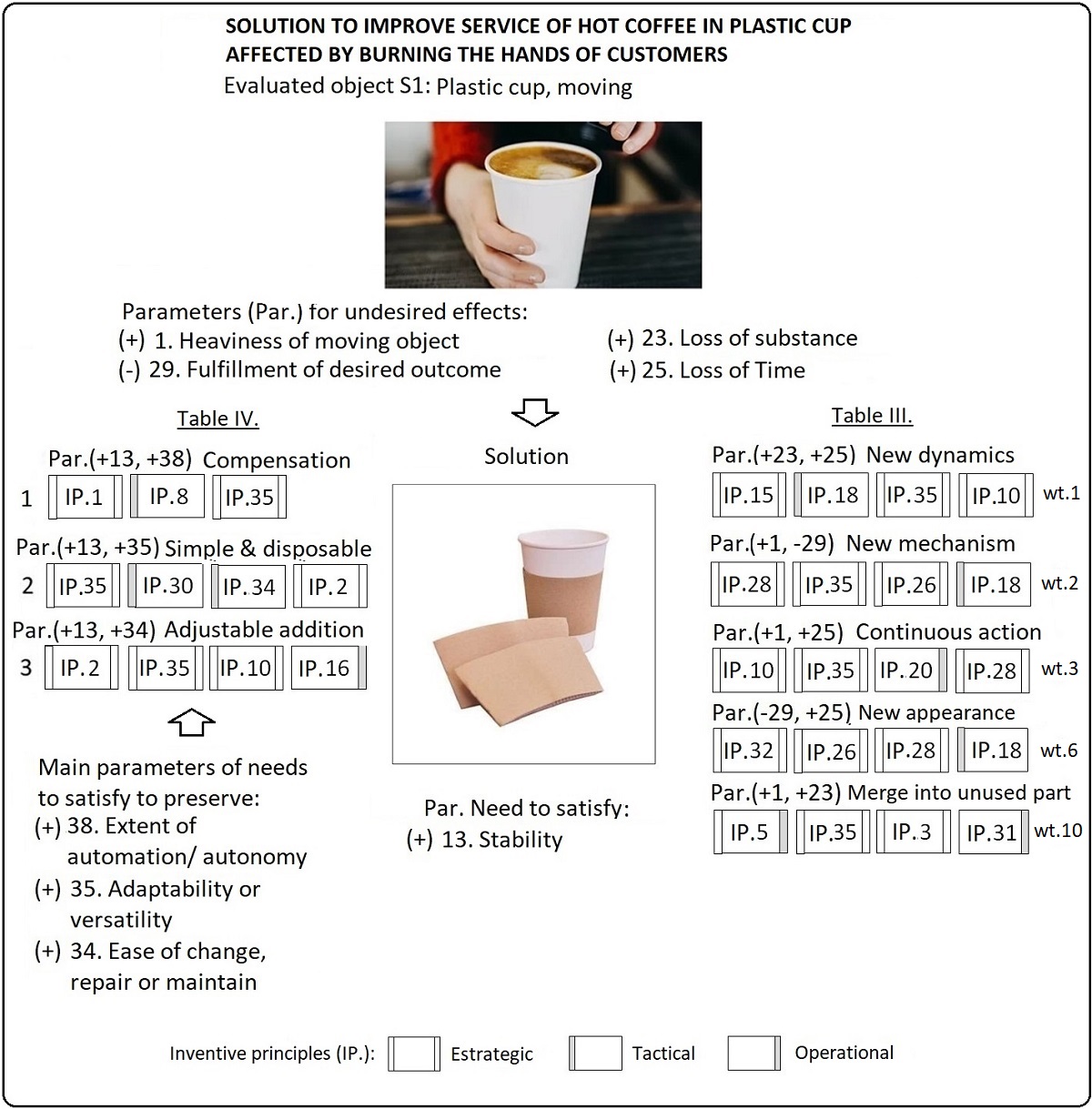
SPECIFIC DESCRIPTION OF THE RELEVANT CONTRADICTIONS
CONTRADICTIONS of TABLE III.
Contradiction N°1 - Order wt.1 : New Dynamics
Parameter to improve: (+) 23. Loss of substance
=> Improve (UDE) : Plastic Cup has More Loss of hot coffee sales to refusal to consume by customers.
Parameter to attenuate or preserve: (+) 25. Loss of time
=> Attenuate or preserve (UDE): Plastic Cup has More Loss of time on sale hot coffee to customers.
Inventive principles IP(s):[15,18,35,10]
" To Improve existence of greater Loss of sale of hot coffee due to customer refusal (Par.23) and attenuate or preserve greater Loss of time in the sale of hot coffee to customers (Par.25), it is necessary to change the conditions to mobilize the Plastic Cup (PI.15 Dynamics), which must move between supplier and client in a cyclical manner with energy from the client that activates it (PI.18 Mechanical vibrations/ Energy variations). Plastic Cup must be transformed and made more adaptive to clients (PI.35 Transformation/Change of parameters) and the required change must be made in advance (PI.10 Preliminary action).
".
Contradiction N°2 - Order wt.2 : New Mechanism
Parameter to improve: (+) 1. Heaviness of moving object
=> Improve (UDE): Plastic Cup has More Heaviness (thermal) for customers for having hot coffee.
Parameter to attenuate or preserve: (-) 29. Fulfillment of desired outcome
=> Attenuate or preserve (UDE): Plastic Cup has Less Compliance with the goal
of selling hot coffee to customers.
Inventive principles IP(s):[28,35,26,18]
" The Plastic Cup * action mechanism must be changed, going from manual to one with the use of a tool (IP.28). Plastic Cup * must be
transformed and made more adaptable to customers (IP.35). A copy or modified glass must be generated to serve hot coffee (IP.26).
Plastic Cup * must move cyclically with energies that activate it (IP.18)
Contradiction N°3 - Order wt.3 : Continuous Action
Parameter to improve:: (+) 1. Heaviness of moving object
=> Improve (UDE): Plastic Cup has More Heaviness (thermal) for customers for having hot coffee.
Parameter to attenuate or preserve: (+) 25. Loss of time
=> Attenuate or preserve (UDE): Plastic Cup has More Loss of time selling hot coffee due to customer refusal
to consume.
Inventive principles IP(s):[10,35,20,28]
"Change required for Plastic Cup * must be done in advance (IP.10). Plastic Cup * must be transformed to make it more adaptable to
customers (IP.35). It must be ensured that the mobility conditions of the Plastic Cup * are continuous (IP.20). The Plastic Cup * action
mechanism must be changed, going from manual to one with the use of a tool (IP.28).
Contradiction N°4 - Order wt.6 : New appearance
Parameter to improve: (-) 29. Fulfillment of desired outcome
=> Improve (UDE): Plastic Cup has Less Compliance with the goal
of selling hot coffee to customers.
Parameter to attenuate or preserve: (+) 25. Loss of time
=> Attenuate or preserve (UDE): Plastic Cup has More Loss of time selling hot coffee due to
customer refusal to consume.
Inventive principles IP(s):[32,26,28,18]
" The way in which Plastic Cup * is perceived by customers must be changed (IP.32). A copy or modified glass must be generated to serve
hot coffee (IP.26). The Plastic Cup * action mechanism must be changed, going from manual to one with the use of a tool (IP.28). Plastic
Cup * must move cyclically with energies that activate it (IP.18)
Contradiction N°5 - Order wt.10 : Merge on unused part
Parameter to improve: (+) 1. Heaviness of moving object
=> Improve (UDE): Plastic Cup has More Heaviness (thermal) for customers for having hot coffee.
Parameter to attenuate or preserve: (+) 23. Loss of substance
=> Improve (UDE) : Plastic Cup has More Loss of hot coffee sales to refusal to consume by
customers.
Inventive principles IP(s):[5,35,3,31]
"Plastic Cup * should be brought close or fused with another compatible object so that they act together at the same time (IP.5).
Plastic Cup * must be transformed to make it more adaptable to customers (IP.35). Operation quality of Plastic Cup * should be improved
locally (IP.3), Unused parts of Plastic Cup * should be used to achieve a positive effect (IP.31).
CONTRADICTIONS of TABLE IV.
Contradiction between needs to satisfy N ° 1 : Compensation
Parameter to improve: (+) 13. Stability
=> Plastic Cup has More satisfactory results Stability in selling hot coffee to customers.
Parameter to preserve: (+) 38. Extent of automation/ Autonomy
=> Plastic Cup has more autonomy in selling hot coffee to customers.
Inventive principles IP(s):[1,8,35,0]
" Plastic Cup* must be divided into parts that can fulfill distinct functions (IP.1). Deficiency of Plastic Cup * must be compensated
to protect consumers' hands (IP.8). Plastic Cup * must be transformed to make it more adaptable to customers (IP.35).
Contradiction between needs to satisfy N° 2 : Simple and disposable
Parameter to improve: (+) 13. Stability
=> Plastic Cup has More Stability in selling hot coffee to customers.
Parameter to preserve: (+) 35. Adaptability or versatility
=> Plastic Cup has more adaptability in selling hot coffee to customers.
Inventive principles IP(s):[35,30,34,2]
" Plastic Cup * must be transformed to make it more adaptable to customers (IP.35). Thin flexible sheets should be used to insulate
Plastic Cup * so as not to burn customer' hand (IP.30). A part which is easy to discard should be considered for Plastic Cup * when it
has fulfilled its function (IP.34). Object must be added to Plastic Cup * to improve its function (IP.2).
Contradiction between needs to satisfy N°3 : adjustable addiction
Parameter to improve: (+) 13. Stability
=> Plastic Cup has More Stability in selling hot coffee to customers.
Parameter to preserve: (+) 34. Ease of Change, Repair or Maintain
=> Plastic Cup has more ease to change the way to sell hot coffee to customers.
Inventive principles IP(s):[2,35,10,16]
" Object must be added to Plastic Cup * to improve its function (IP.2). Plastic Cup * must be transformed to make it more adaptable to
customers (IP.35). Change required for Plastic Cup * must be done in advance (IP.10). If the objective of Plastic Cup * is difficult to
achieve completely, using a given solution method, then the problem, can be easier to solve, using 'a little less' or 'a
little more' of the same method (IP.16).
The focused description of the contradictions allows the Innovative Team to specify the solution in a free format. As an example, the following Solution Summary is shown for this case:
The plastic cup must be segmented (IP.1. Segmenting/ Integrating), adding a new part (IP.2. Taking out/ Adding) to create a copy of it (IP.26). The modification must be done previously (IP.10. Preliminary Action), placing a sheet of cardboard (IP.30. Simple Shapes/ Ways to Interact) disposable (IP.34. Discarding and Recovering) in the plastic cup, located on the external wall of the plastic cup (IP. 3 Local Quality, IP.5 Merging/ Separating, IP.31 Using/ Removing unused parts). This compensates the current service weakness (IP.8. Anti-Weight/ Compensation) and facilitates the movement of the plastic cup with hot coffee (IP.15. Dynamics), without discontinuities (IP.20 Continuity of Useful Action) The plastic cup is conveniently transformed (IP.35) for the consumer, at low cost, changing the way it is perceived by customers (IP.32. Perception/ Appearance/ Color Changes) The thickness of the cardboard sheet it is determined empirically (IP.16. Partial or Excessive Actions), that it does not burn the customer, but that it is of minimum cost. The customer is induced to take the plastic cup to drink hot coffee and place it back on the table, cyclically (IP.18. Mechanical Vibrations/ Energy Variations), so that they do not feel the heat emitted by the plastic cup.
You could reread the contradictions described above and see how the principles stated above have generically described the particular solution that has been applied. Also, if you consider the described solution and read the contradictions included in Table II for this case, you should be able to understand its contribution to the solution, using relational thinking.
B. DESIGN THE BEST LEGO TOY FOR CHILDREN AFFECTED BY DESIGNER'S PARADIGMS
Managing human behavior soft variables

EVALUATED SPACE-TIME:
Space: Place where the designer creates a new toy for children, plus a place where children reject it, because it is
not to their liking.
Time: Period that elapses between the moment the designer starts creating a new toy for children until the moment they reject it.
SOLUTION TABLES
The information required to build the solution is similar to that shown in letter A above. The Aatrizinventor Solution report for this case can be seen at the link above in 'Login to Algorithm'/'Aatrizinventor Examples'.
Below are the relevant tables to build the solution for the evaluated case. Tables are displayed exactly in the format used by the Aatrizinventor algorithm.
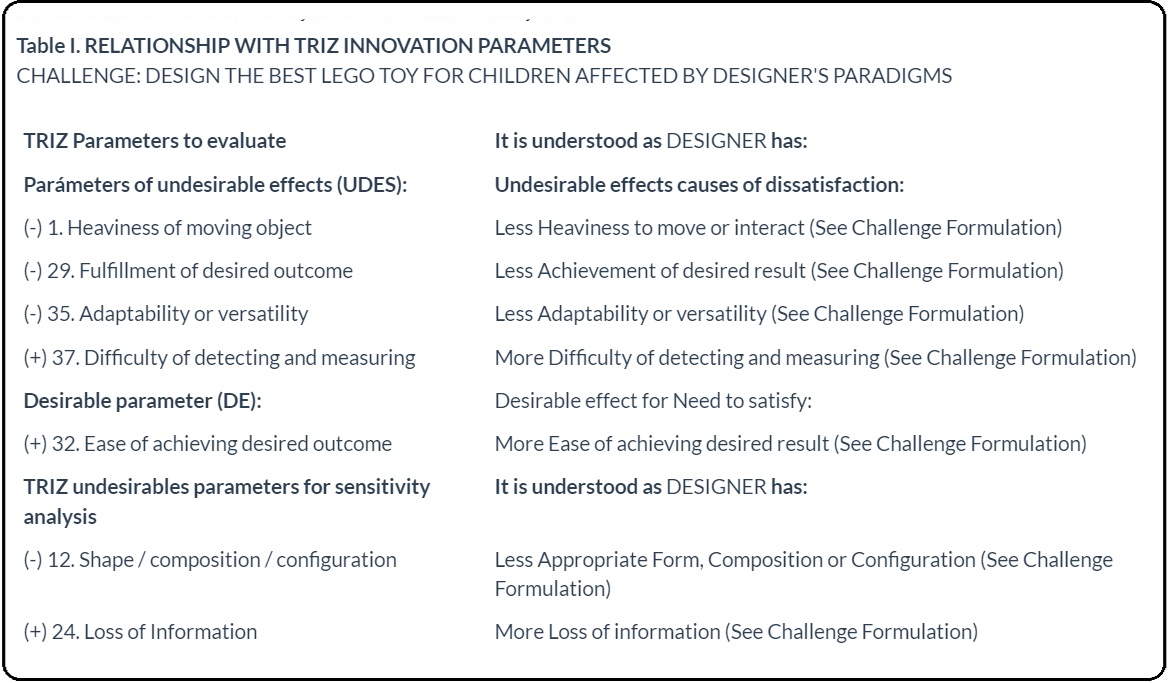
Table I, which provides the algorithm, describes the undesirable effects and the desirable effect in a generic way. The description provided by the User is not sent to the Server environment to maintain the confidentiality of the analysis. The following table shows the information available in the Challenge Formulation, which must be used for the private analysis of the Aatrizinventor Solution.
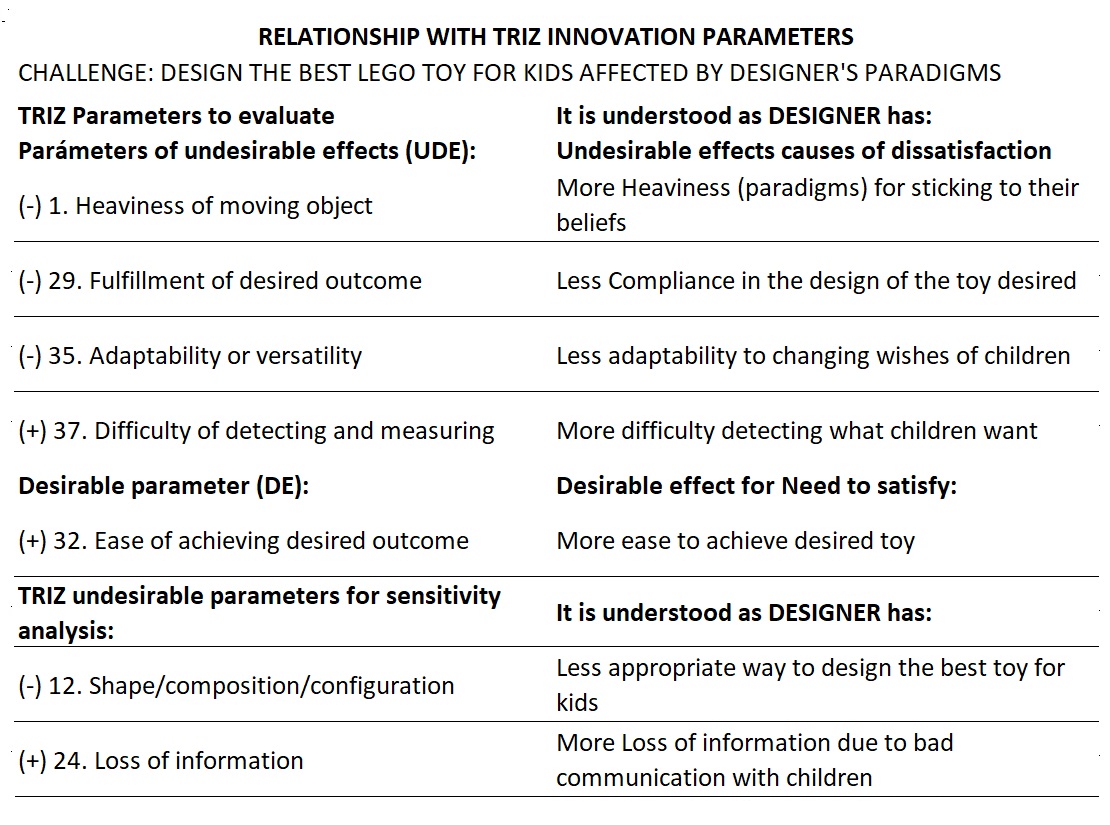


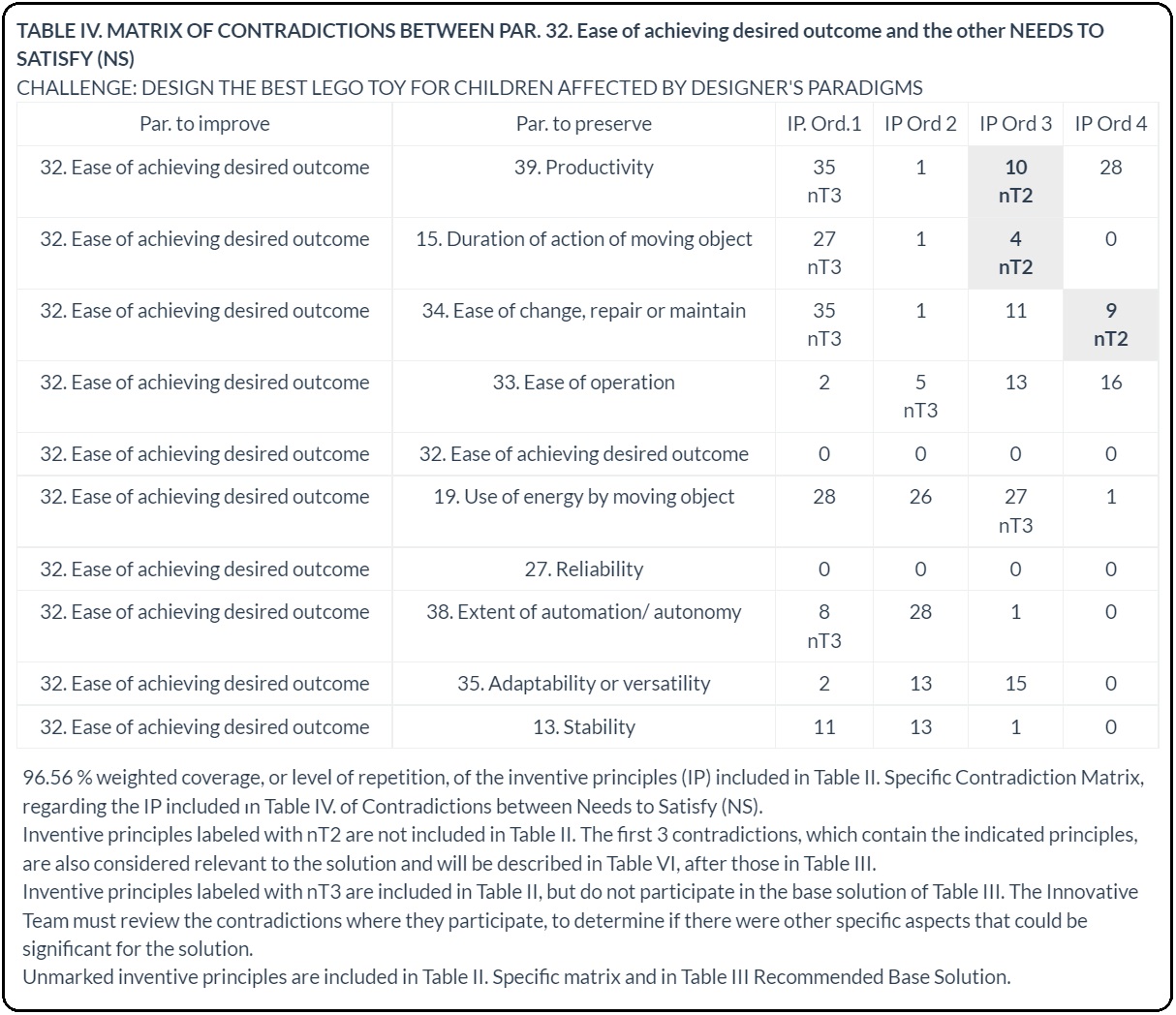

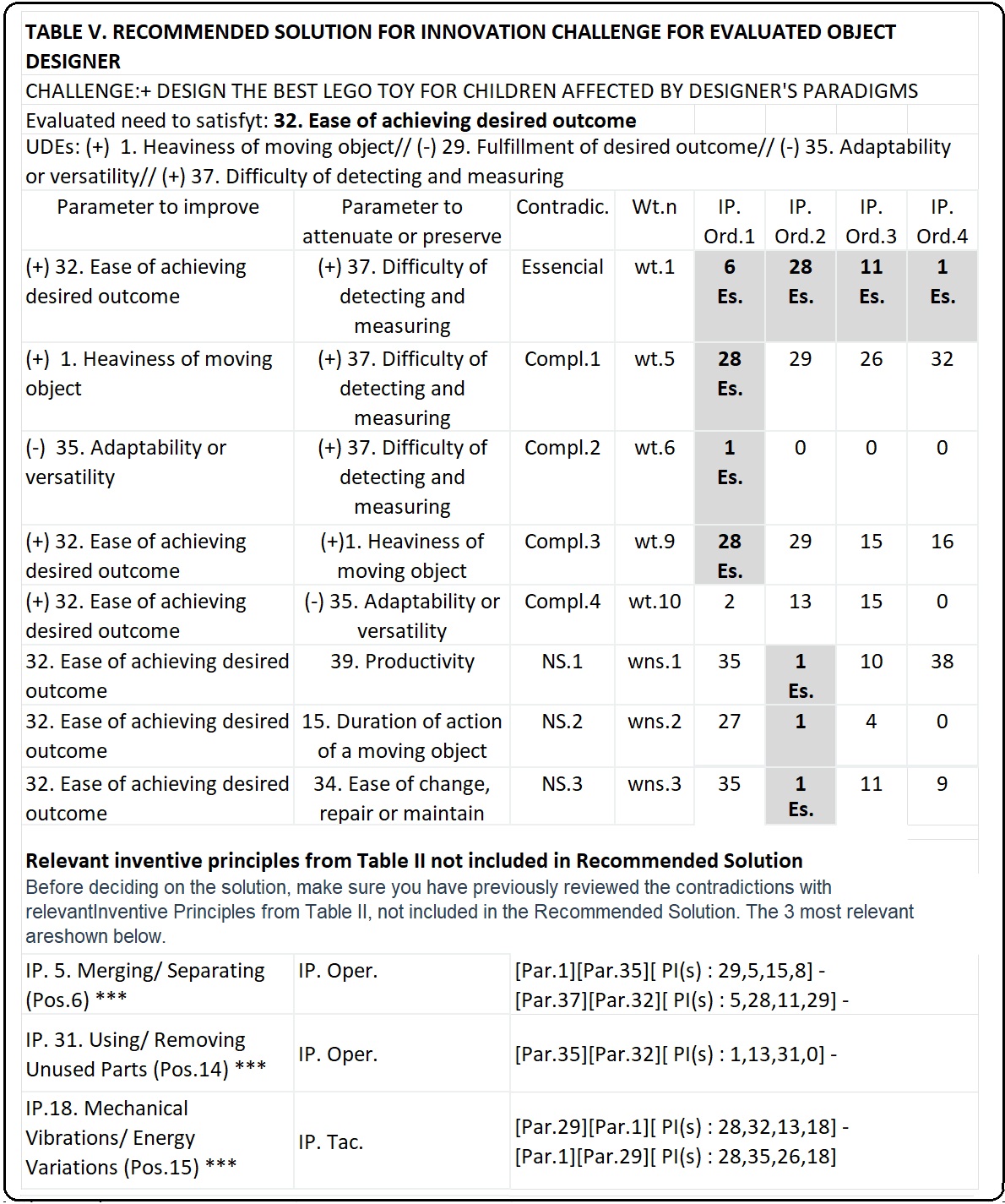

SYSTEMATIC IDEATION OF THE SOLUTION
The ideation criteria are the same as those indicated in letter A above.
SOLUTION VALIDATION
The validation criteria are the same as those indicated in letter A above.
Below is a graph with the current situation, the specific solution for the case of designing the best toy for children and the description of the relevant contradictions adapted to the evaluated case, which explains how the recommended solution is formed.
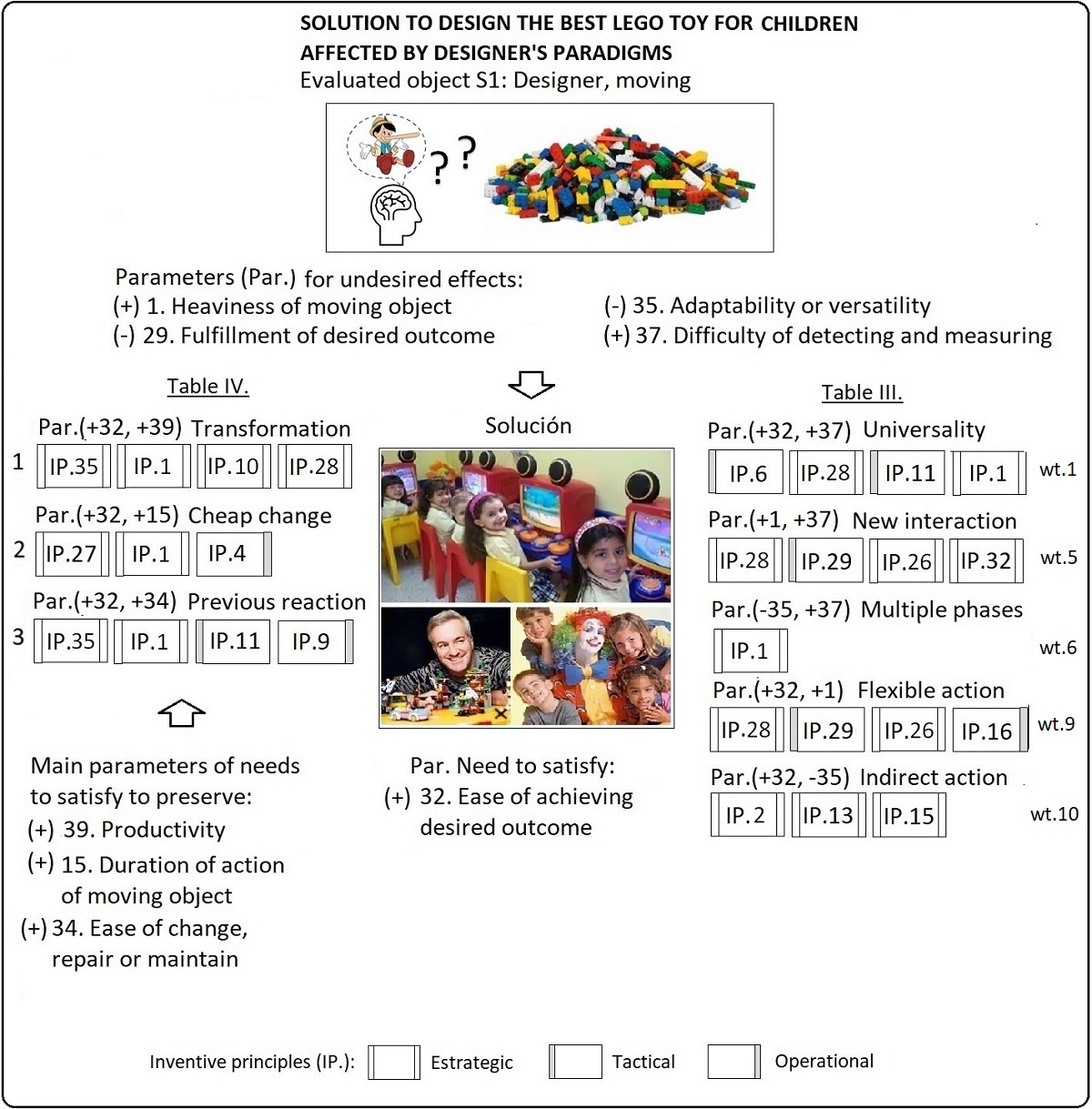
SPECIFIC DESCRIPTION OF THE RELEVANT CONTRADICTIONS
CONTRADICTIONS of TABLE III.
Contradiction order wt.1 : Universality
Parameter to improve: (+) 32. Ease of achieving desired outcome
=> Improve (DE): Designer has More Ease of achieving a toy desired by children
Parameter to attenuate or preserve: (+) 37. Difficulty of detecting and measuring
=> Attenuate or Preserve (UDE): Designer has More Difficulty detecting which
toy children want
Inventive principles IP(s):[6,28,11,1]
To facilitate the achievement of the desired objective (Par.32) and to attenuate the difficulty of detecting the wishes of the Children (Par.37),
the Designer must be multifunctional (IP.6) and must interact with the children, using sensory means , psychological approaches and electromagnetic
tools (computer software and applications) to capture children's wishes (IP. 28). The Designer must take anticipated action to compensate for the low
reliability (IP.11) of the current design method. This requires dividing the Action of the Designer (IP.1) into different forms of action and applied resources.
Contradiction order wt.5 : New interaction
Parameter to improve: (+) 1. Heaviness of moving object
=> Improve (UDE): Designer has More heaviness for sticking to their own beliefs
Parameter to attenuate or preserve: (+) 37. Difficulty of detecting and measuring
=> Attenuate or Preserve (UDE): Designer has More Difficulty detecting which
toy children want
Inventive principles IP(s):[28,29,26,32]
To reduce the intellectual rigidity of the Designer (Par.1) and to attenuate the greater difficulty of detecting Children's desires (Par.37), must
interact with the children, using sensory means , psychological approaches and electromagnetic
tools (computer software and applications) to capture children's wishes (IP. 28). This action should be controlled with soft variables (IP.29),
either social, psychological and digital form, using a replica or copy of the
Designer (IP.26) to interact with the Children indirectly. This will allow the Designer to be perceived in a friendlier way (IP.32).
Contradiction order wt.6 : Multiple phases
Parameter to improve: (-) 35. Adaptability or versatility
=> Improve (UDE): Designer has Less Adaptability to children's variable desires
Parameter to attenuate or preserve: (+) 37. Difficulty of detecting and measuring
=> Attenuate or Preserve (UDE): Designer has More Difficulty detecting which
toy children want
Inventive principles IP(s):[[1,0,0,0]
To improve the adaptability of the Designer (Par. 35) to Children and to attenuate the greater difficulty of detecting Children's desires (Par. 37),
the action of the Designer should be divided into different forms of action and applied resources (IP.1)
Contradiction order wt.6 : Flexible action
Parameter to improve: (+) 32. Ease of achieving desired outcome
=> Improve (DE): Designer has More Ease of achieving a toy desired by children
Parameter to attenuate or preserve: (+) 1. Heaviness of moving object
=> Attenuate or Preserve (UDE): Designer has More heaviness for sticking to their own beliefs
Inventive principles IP(s):[[28,29,15,16]
To facilitate the achievement of the desired result (Par.32) and attenuate the intellectual rigidity of the Designer (Par.1), current means to
capture the wishes of children should be replaced by sensory, psychological and electromagnetic fields (software and computer applications) (IP.28),
applying soft control variables (IP.29). The Designer must change his rigid and inflexible design criteria into moving and adaptive criteria (IP.15),
adjusting his methods, a little more or a little less, for achieve the desired optimal result (IP.16).
Contradiction order wt.10 : Indirect action
Parameter to improve: (+) 32. Ease of achieving desired outcome
=> IMPROVE (DE): Designer has More Ease of achieving a toy desired by children
Parameter to attenuate or preserve: ((+) 35. Adaptability or versatility
=> Attenuate or Preserve (DE): Designer has Less Adaptability to children's variable
desires
Inventive principles IP(s):[[2,13,15,0]
To facilitate the achievement of the desired objective result (Par.32) and attenuate the low adaptability of the Designer to Children (Par.35), the
innovative design approach requires adding new parts and properties to the Designer (IP.2), who should reverse their traditional way of designing (IP.13)
and change the design dynamics from rigid to adaptive (IP.15)
CONTRADICTIONS of TABLE IV.
Contradiction between Needs to Satisfy N° 1 : Transformation
Parameter to improve: (+) 32. Ease of achieving desired outcome
=> Improve (DE): Designer has More Ease of achieving a toy desired by children
Parameter to preserve: ((-) (+) 39. Productivity
=> Preserve (UDE): Designer has More desirable productivity to design the best children's toy
Inventive principles IP(s):[[35,1,10,28]
To facilitate the achievement of the desired result (Par.32) and preserve greater productivity (Par.39), the Designer must be transformed (IP.35),
so that they act through distinct parts and properties (IP.1). Any change must be made in advance (IP.10), and the means to capture desires must
be correctly substituted by sensory, psychological and electromagnetic means (software and computer applications) (IP.28), moving from the paradigms
of the Designer to the experience that motivates children.
Contradiction between Needs to Satisfy N° 2 : Cheap change
Parameter to improve: (+) 32. Ease of achieving desired outcome
=> Improve (DE): Designer has More Ease of achieving a toy desired by children
Parameter to preserve: ((+) 15. Duration of action of moving object
=> Preserve (DE): Designer has More desirable duration to design the best children's toy
Inventive principles IP(s):[[27,1,4,0]
To facilitate the achievement of the desired result (Par.32) and preserve more efficient duration Designer action (Par.15), the Designer or its
action must be replaced or divided (either fully or partially) with multiple inexpensive or short-living objects, actions, or sub-parts (IP.27).
This requires dividing the role of the Designer into different forms of action and applied resources (IP.1). The action of Designer should be
variable in time and space, asymmetrical, not routine, that facilitates communication with children (IP.4).
Contradiction between Needs to Satisfy N° 3 : Previous reaction
Parameter to improve: (+) 32. Ease of achieving desired outcome
=> Improve (DE): Designer has More Ease of achieving a toy desired by children
Parameter to preserve: ((+) 34. Ease of change, repair or maintain
=> Preserve (DE): Designer has More Ease to change the way to design best children's toy
Inventive principles IP(s):[[35,1,11,9]
To facilitate the achievement of the desired result (Par. 32) and preserve the ease of changing the mindset of the designer (Par, 34), the designer
must transform himself (IP.35). The action of the Designer should be divided into forms of action and applied resources (IP.1). Emergency measures
should be taken to compensate for the low reliability of the current children's toy design process (IP.11) and, if useful and potentially harmful
actions are necessary for the children participating in the design process, consideration should be given to the use of anti-actions, which oppose
the predicted unwanted effects (IP.9).
The focused description of the contradictions allows the Innovation Team to specify the solution, in a free format. As an example, the following Solution Summary is shown for this case:
" The solution aims to solve the great challenge that the Designer has of knowing what toy children want, which does not fit their paradigms, to achieve a successful design. For this, the Designer must transform his action into a multifunctional one (IP.6. Universality), using existing interaction mechanisms not applied with the children (IP.28. Mechanics Substitution), which allows him to compensate in advance for the rejection he has had (IP.11 Beforehand Cushioning). Designer requires dividing her performance with the children into different forms of action and applied resources (IP.1. Segmenting/ Integrating), existing or new, using soft, psychological test and technological tools, such as application software (IP.29. Controllable Soft Variables). Designer must generate a copy of himself (IP.26. Copying/ Replicating), disguised or camouflaged, acting directly or by some means, which allows a good perception in children (IP.32. Perception/ Appearance/ Color Changes). Designer must apply adapted dynamics to the children (IP.15. Dynamics), adjustable, a little more or a little less, depending on the results obtained (IP.16. Partial or Excessive Actions). Designer must change his design criteria by adding new functionalities and eliminating some unnecessary current ones (IP.2. Taking out/ Adding), inverting his way of working to a more flexible and adapted to the children (IP.13. Inverse or Indirect Action). Designer must make these changes in advance (IP.10. Preliminary Action) and must anticipate the use of reactive actions, which counteract the undesired effects that could occur (IP.9. Preliminary Anti-action).
C. IMPROVE MOVEMENT OF AN ANIMAL AFFECTED BY REFUSING TO WALK
An innovation classic now fully explained

EVALUATED SPACE-TIME:
space: Space: Path traveled where a person repeatedly pulls an animal to walk, it is reluctant, moves slowly and exhausts the person.
Time: Period that elapses between the moment the person begins to pull the animal until the moment it reaches its destination after a
lot of effort.
SOLUTION TABLES
Below are the most important tables that determine the specific solution sought. These are contained in the Aatrizinventor Solution of
the case evaluated, which you can see in full in the link above 'Enter to algorithm'/'Aatrizinventor Examples'.


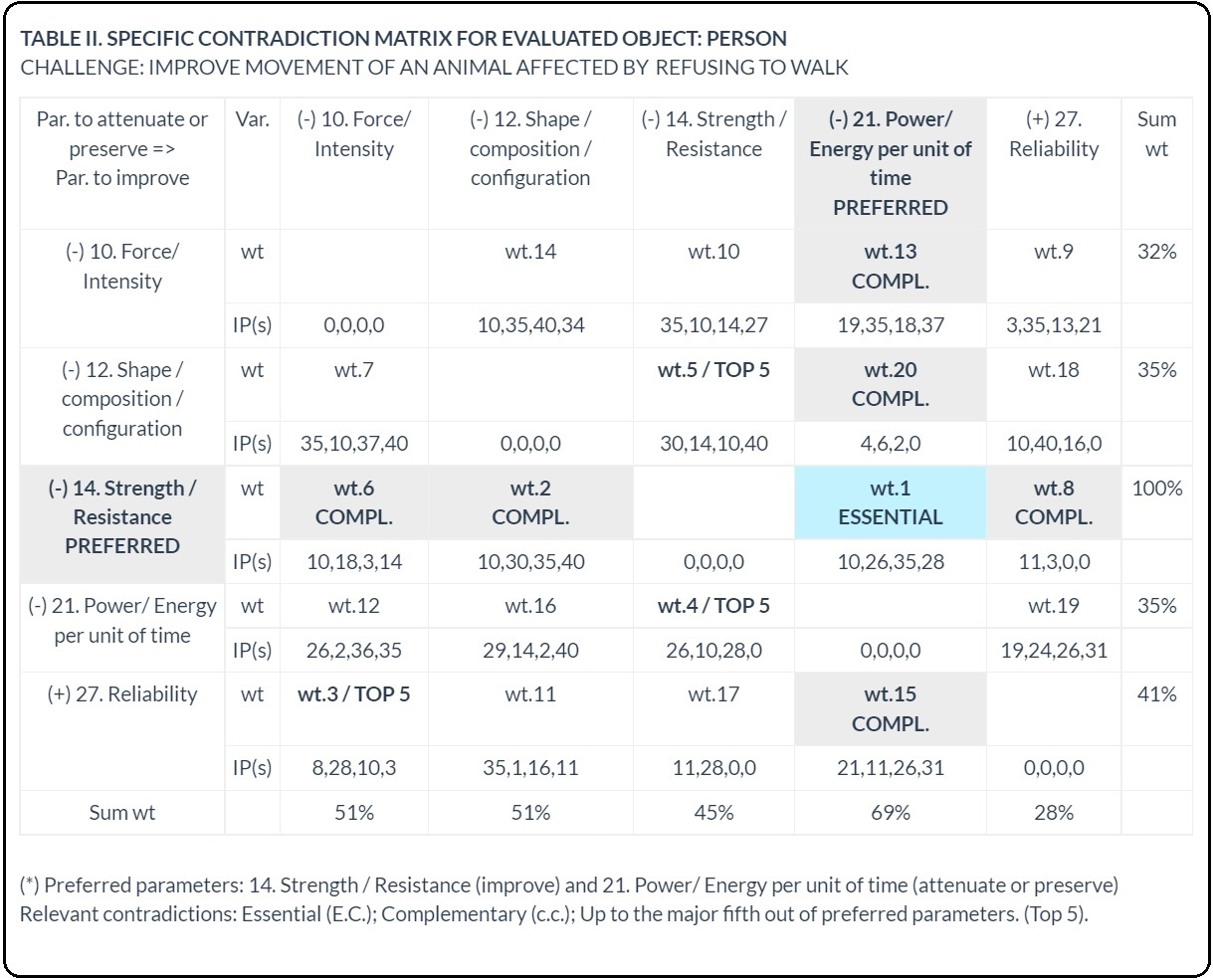
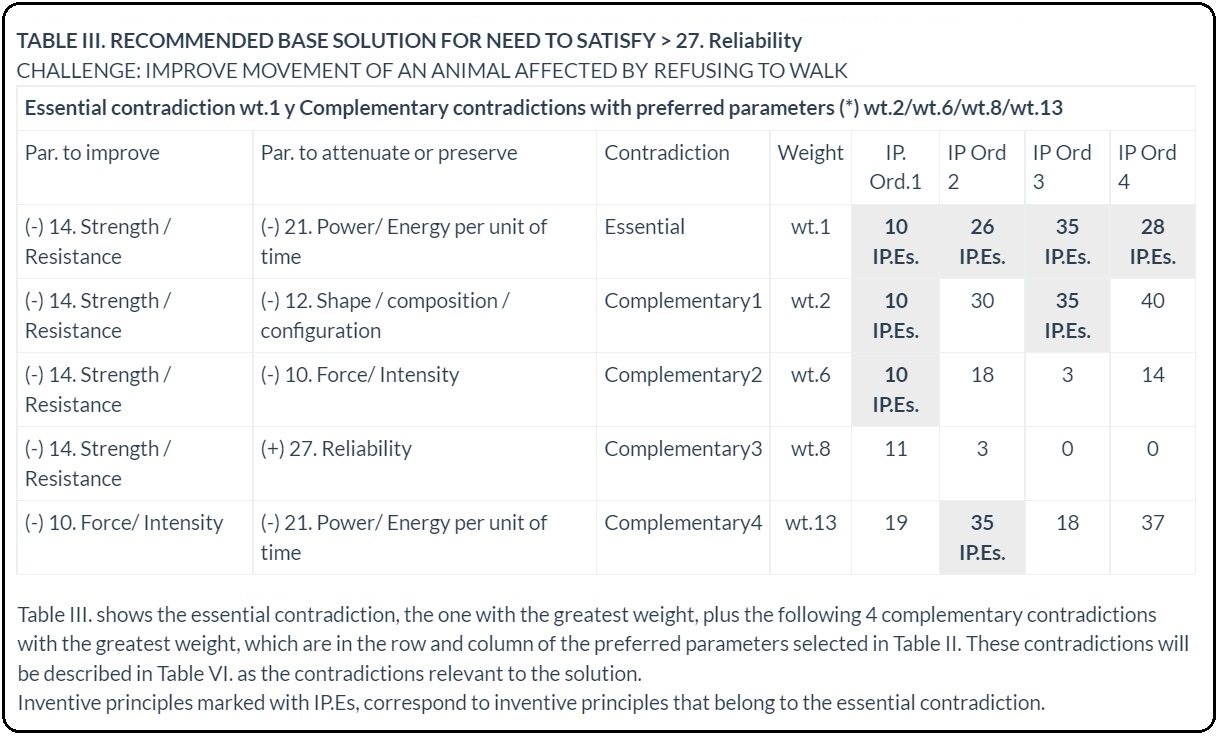
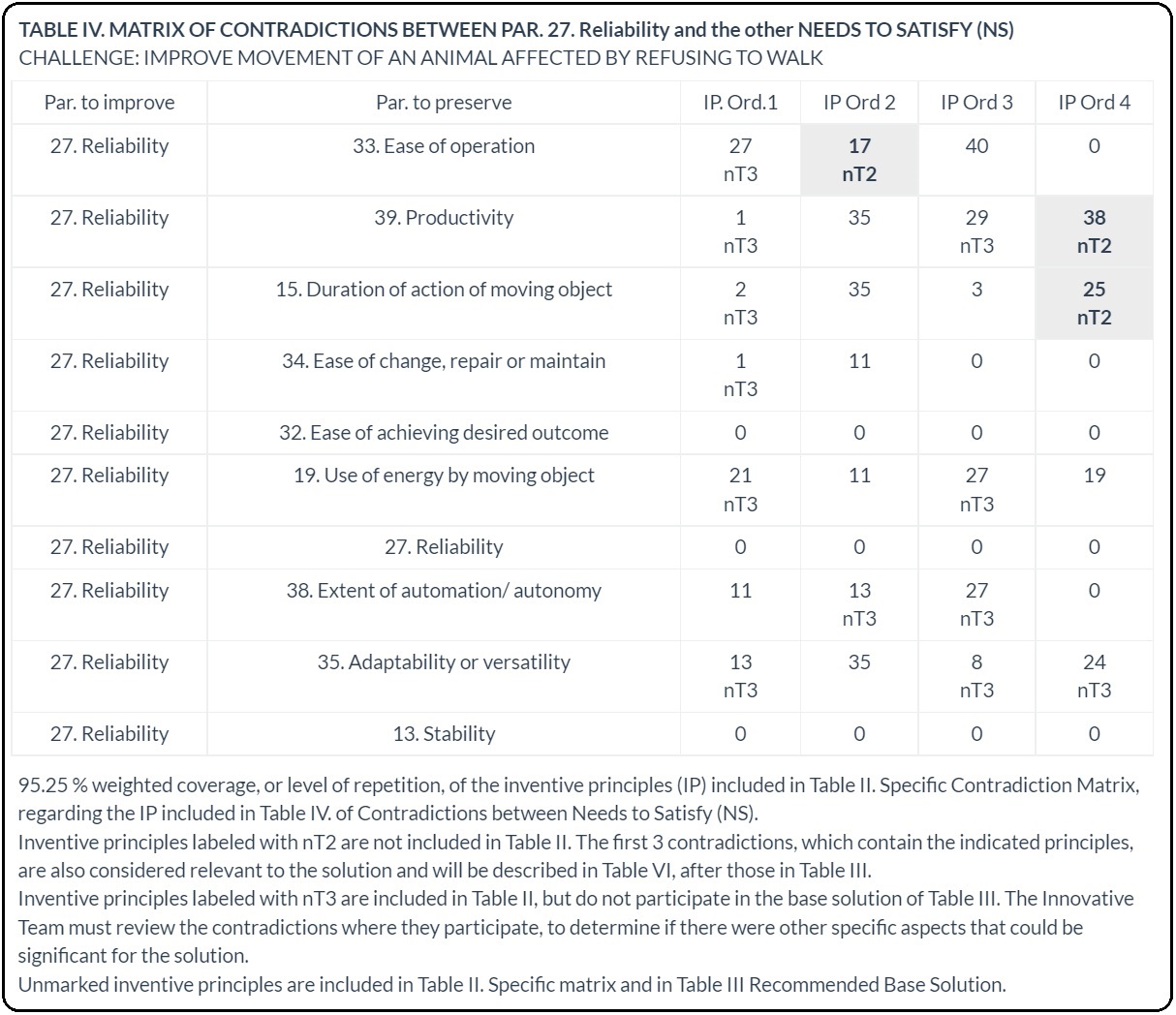
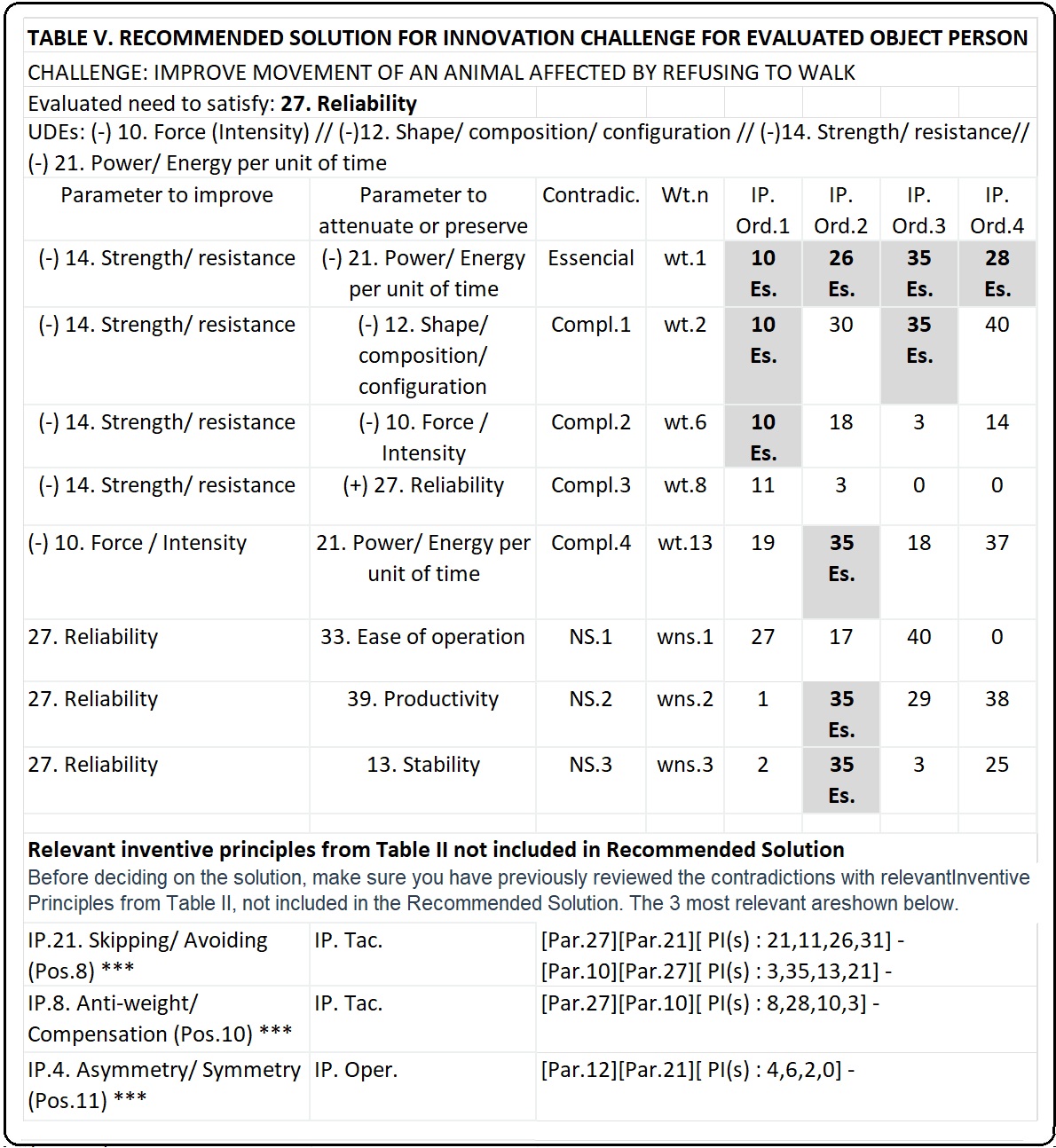

SYSTEMATIC IDEATION OF THE SOLUTION
The ideation criteria are the same as those indicated in letter A above.
SOLUTION VALIDATION
The validation criteria are the same as those indicated in letter A above.
Below is a graph with the current situation, the specific solution for the case of moving an animal that refuses to walk and the description of the relevant contradictions adapted to the evaluated case, which explains how the recommended solution is formed.

SPECIFIC DESCRIPTION OF THE RELEVANT CONTRADICTIONS
CONTRADICTIONS of TABLE III.
Contradiction order wt.1 : Active replication
Parameter to improve: (-) 14. Strength / Resistance
=> Improve (UDE): Person has Less Strength to move an animal
Parameter to attenuate or preserve: (-) 21. Power/ energy per unit of time
=> Attenuate or Preserve (UDE): Person has Less Power to move an animal
Inventive principles IP(s):[10,26,35,28]
To improve the low strength of the Person (Par.14) and to attenuate its low power (Par.21), the Person must have a previous change
(IP.10), generating a replica, like a copy (IP.26) , that the animal will see it as a new incentive to keep going. This must be
obtained by adding another component to the Person (IP.35), which replaces the mechanism currently used to move an animal, with a
new one that is more successful (IP.28).
Contradiction order wt.2 : Simple shapes/ways
Parameter to improve: (-) 14. Strength / Resistance
=> Improve (UDE): Less Strength to move an animal.
Parameter to attenuate or preserve: (-) 12. Shape / composition / configuration
=> Attenuate or Preserve (UDE): Less Appropriate way
to move an animal.
Inventive principles IP(s):[10,30,35,40]
To improve the low strength of the Person (Par.14) and to attenuate their inappropriate way (Par.12) of moving an animal, the replica
of the Person must be prepared beforehand (IP. 10). It must include a simple mechanism like a flexible rod (IP. 30), which adds a new
component (IP. 35), to form a compound system (IP. 40) for moving an animal.
Contradiction order wt.6 : Local dynamics
Parameter to improve: (-) 14. Strength / Resistance
=> Improve (UDE): Person has Less Strength to move an animal.
Parameter to attenuate or preserve: (-) 10. Force/ Intensity
=> Attenuate or Preserve (UDE): Person has Less Force to move an animal.
Inventive principles IP(s):[10,18,3,14]
To improve the low strength of the Person (Par.14) and attenuate or preserve their low force (Par.10) to move an animal, the replica
of the Person must be prepared beforehand (IP. 10). It should act in a cyclical (IP. 18) and localized (IP. 3) manner, by using
curved or angled shapes (IP. 14).
Contradiction order wt.8 : Previous compensation
Parameter to improve: (-) 14. Strength / Resistance
=> Improve (UDE): Person has Less Strength to move an animal.
Parameter to attenuate or preserve: (+) 27. Reliability
=> Preserve (DE): Person has More Reliability to move an animal.
Inventive principles IP(s):[11,3,0,0]
To improve the low strength of the Person (Par.14) and to preserve reliability (Par.27) of the action on animal, anticipated emergency
measures should be undertaken, to improve low reliability of the current situation (IP.11), and the interaction between Person and
animal should be changed from uniform to non-uniform (IP. 3).
Contradiction order wt.13 : Cyclical signal
Parameter to improve: (-) 10. Force/ Intensity
=> Improve (UDE): Person has Less Force to move an animal.
Parameter to attenuate or preserve: (-) 21. Power/ Energy per unit of time
=> Preserve (UDE): Person has Less Power to move an animal.
Inventive principles IP(s):[19,35,18,37]
To improve the low force of the Person (Par.10) and to attenuate their low power (Par.21) to move an animal, the incentive to make
the animal move forward should be by periods or time pulses (IP. 19). This can be achieved by adding a component to the Person (IP.35),
which acts cyclically, as needed (IP. 18). Additionally, a change should be made in the Person, so that they become more sensitive and
helpful to encouraging the animal to move (IP.37).
CONTRADICTIONS of TABLE IV.
Contradiction between Needs to Satisfy N° 1 : Cheap and compound
Parameter to improve: (+) 27. Reliability
=> Improve (DE): Person has More Reliability to move an animal.
Parameter to preserve: (+) 33. Ease of operation
=> Preserve (DE): Person has More Ease of operation to move an animal
Inventive principles IP(s):[[27,17,40,0]
To improve the reliability (Par.27) and to preserve the ease of the operation (Par.33) to move an animal, the Person should be divided
into subsystems, adding low-cost and short-lived parts (IP. 27) and should be relocated in a multi-arrangement (IP. 17); that form
a compound system (IP. 40) for moving an animal.
Contradiction between Needs to Satisfy N° 2 : Strong incentive
Parameter to improve: (+) 27. Reliability
=> Improve (DE): Person has More Reliability to move an animal.
Parameter to preserve: (+) 39. Productivity
=> Preserve (DE):Person has More Productivity to move an animal
Inventive principles IP(s):[[1,35,29,38]
To improve the reliability (Par.27) and to preserve the productivity (Par.39) to move an animal, the Person should be divided into
existing and new parts, Integrated into a single entity (IP.1), transforming a Person to adapt to an animal (IP.35), through the
application of soft variables, such as the incentive to eat (IP.29), which will foreseeably generate a strong reaction from the
animal to walk (IP.38).
Contradiction between Needs to Satisfy N° 3 : Self-service
Parameter to improve: (+) 27. Reliability
=> Improve (DE): Person has More Reliability to move an animal.
Parameter to preserve: (+) 15. Duration of action of moving object
=> Preserve (DE): Person has More desirable duration to move an animal
Inventive principles IP(s):[[2,35,3,25]
To improve its reliability (Par.27) and to preserve the duration of action to move animal (Par.15), any necessary parts should be
added to the Person (IP.2). Physical state of Person should be transformed, adding new components (IP.35). The interaction between
Person and Animal should be changed from uniform to non-uniform (IP.3). Finally, Person should serve itself by performing auxiliary
useful functions (IP. 25).
The focused description of the contradictions allows the Innovation Team to specify the solution, in a free format. As an example, the following Solution Summary is shown for this case:
" To improve the reliability of movement of an animal, the Person must have a previous change (IP.10 Preliminary Action), generating a replica, a copy of itself (IP.26 Coping/ Replicating), that the animal sees as a new incentive to move forward. This can be achieved by transforming the Person, adding other components to it (IP.35 Transformation/Change of parameters), which replace the mechanism currently used to move an animal, with a new one that is more successful (IP.28 Mechanics Substitution). This requires including a simple mechanism of interaction with the animal, such as a flexible rod (IP.30 Simple Shapes/Ways to Interact) to form a composite system (IP.40 Composite Materials/Conditions) to move an animal. The incentive mechanism for the animal to move must act cyclically (IP.18 Mechanical Vibration/ Energy Variations), in a localized and non-uniform manner (IP.3 Local Quality), using curved or angled shapes (IP.14 Spheroidality - Curvature - Angle). The new movement mechanism must consider early emergency measures to improve the low reliability of the current situation (IP.11 Beforehand Cushioning), divide into subsystems, adding new low-cost and short-lived parts (IP.27 Cheap Short-Living Objects), be predisposed in a multiple arrangement (IP.17 Another Dimension or Field), segment into parts, existing and new, integrated into a single entity (IP.1. Segmenting/ Integrating), and take advantage of soft variables, such as the instinct to eat (IP.29. Controllable Soft Variables) , which will predictably generate a strong reaction in the animal to walk (IP.38 Strong and/or Fast reactions). New parts should be added as needed and interfering ones removed (IP.2 Taking out/ Adding) and the Person should serve itself by executing useful auxiliary functions (IP.25. Self-service).
D.1 ENSURE STABLE NAVIGATION OF FERRY AFFECTED WHEN WATER ENTERS CARGO SPACE
As explained in Topic 5, this is one of two options that are evaluated to prevent the sinking of a ferry. Here a solution is sought to avoid the impact to the Ferry when water enters the cargo space.
Avoiding the sinking of a Ferry, a complex solution with a higher cost

EVALUATED SPACE-TIME:
space: Place occupied by cargo space affected by water ingress that destabilizes Ferry and overturns it.
Time: Period that elapses between the moment the water enters the cargo space and until the moment the Ferry becomes unstable and capsizes.
SOLUTION TABLES
Below are the most important tables that determine the specific solution sought. These are contained in the Aatrizinventor Solution of
the case evaluated, which you can see in full in the link above 'Enter to algorithm'/'Aatrizinventor Examples'.
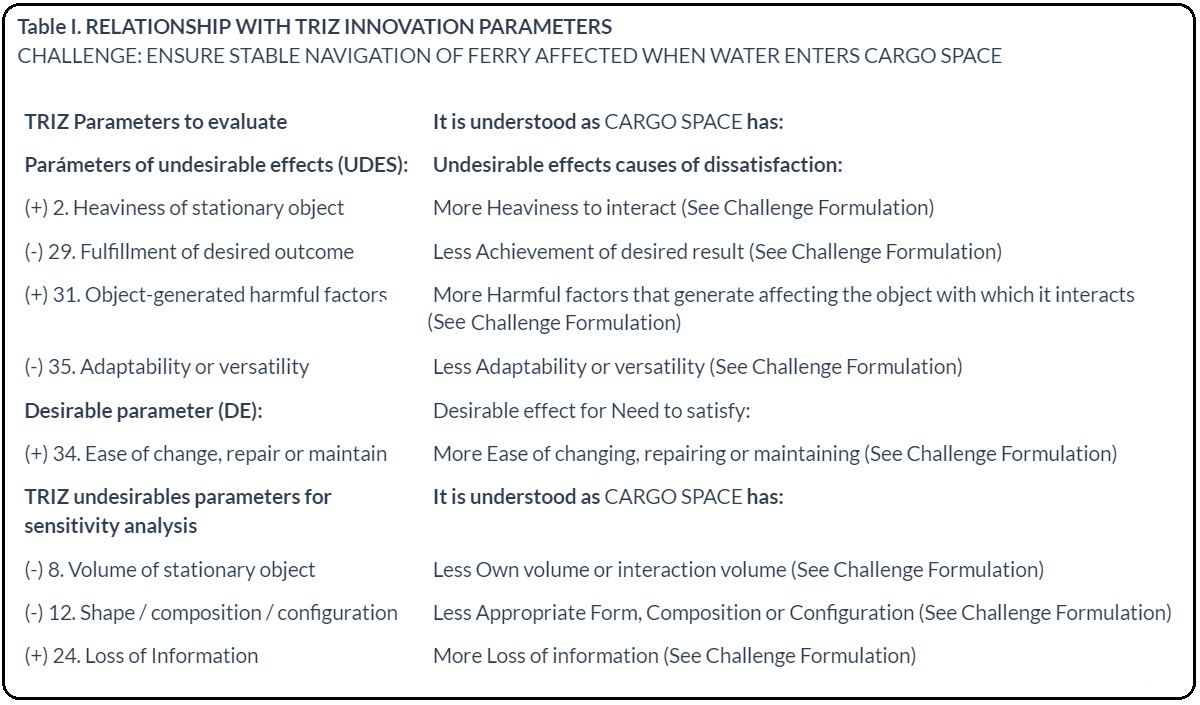
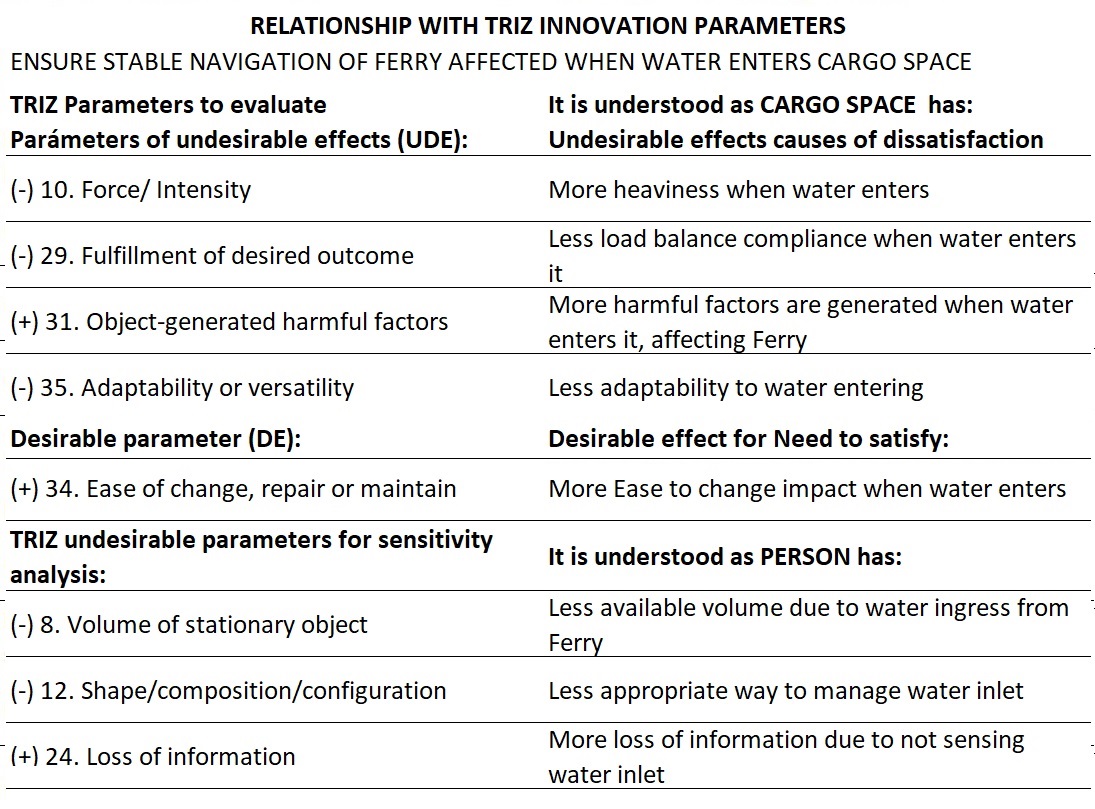





SYSTEMATIC IDEATION OF THE SOLUTION
The ideation criteria are the same as those indicated in letter A above.
SOLUTION VALIDATION
The validation criteria are the same as those indicated in letter A above.
Below is a graph with the current situation, the specific solution for the case to ensure ferry stability when water enters cargo space and the description of the relevant contradictions adapted to the evaluated case, which explains how the recommended solution is formed.
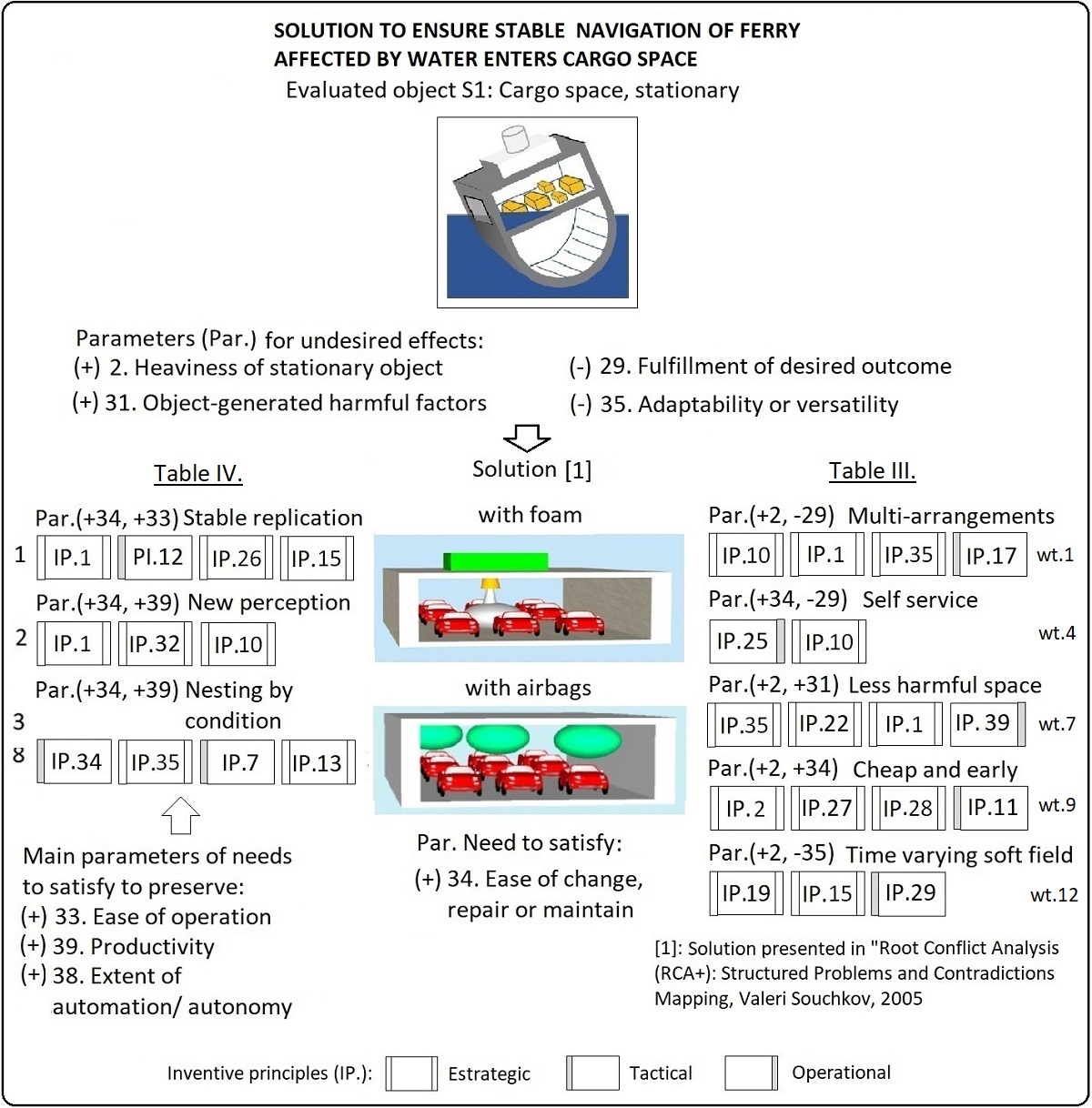
SPECIFIC DESCRIPTION OF THE RELEVANT CONTRADICTIONS
CONTRADICTIONS of TABLE III.
Contradiction N°1 - wt.1 : Multi-arrangements
Parameter to improve: (+) 2. Heaviness of Stationary object
=> Improve (UDE): Cargo space has More heaviness when water enters
Parameter to attenuate or preserve: (-) 29. Fulfillment of desired outcome
=> Attenuate or preserve (UDE): Cargo space has Less load balancing fulfillment
when water enters
Inventive principles IP(s):[10,1,35,17]
To improve the effect of the increased weight of the Cargo Space (Par.2) and attenuate its poor load balance compliance when water enters (Par.29), the Cargo Space must have a previous change (IP.10 Preliminary action) , divided into several parts (IP.1 Segmenting/ Integrating). Is required transform cargo space, adding new components that make it more adaptive to water ingress (IP.35 Transformation/ Change of parameters), organized in multi-arrangements (IP. 17 Another dimension or field).
Contradiction N°2 - wt.4 : Self-service
Parameter to improve: (+) 34. Ease of change, repair or maintain
=> Improve (DE): Cargo space has More ease to change water inlet impact
Parameter to attenuate or preserve: (-) 29. Fulfillment of desired outcome
=> Attenuate or preserve (UDE): Cargo space has Less load balancing fulfillment
when water enters
Inventive principles PI(s) [25,10,0,0]
To improve ease of changing (Par.34) and attenuate its poor balance compliance when water enters it (Par.29), Cargo Space should be made to serve itself by performing useful auxiliary functions (IP. 25 Self-service), which must be predisposed in such a way that they can act from the most convenient place and without wasting time for their contribution (IP.10 Preliminary action).
Contradiction N°3 - wt.7 : Protected environment
Parameter to improve:(+) 2. Heaviness of stationary object
=> Improve (UDE): Cargo space has More heaviness when water enters
" Parameter to attenuate or preserve: (+) 31. Object-generated harmful factors
=> Attenuate or Preserve (UDE): Cargo Space has More harmful Factors generated, which affect the Ferry's stability
Inventive principles IP(s):[35,22,1,39]
To improve the effect of the increased weight of the Cargo Space (Par.2) and attenuate the harmful factors generated that affect the Ferry (Par.31), cargo space must be transformed by adding new components (IP.35 Transformation / Change of parameters), which allow removing a primary damaging action by adding another action to Cargo Space that counteracts the damaging action to solve the problem (IP.22 Convert harmful to benefit), This requires dividing Cargo Space into different parts and shapes (IP.1 Segmenting/ Integrating) to generate an inert environment (IP.39 Atmosphere/ Inert environment), protected against the ingress of water.
Contradiction N°4 - wt.9 : Low cost and anticipated
Parameter to improve: (+) 2. Heaviness of stationary object
=> Improve (UDE): Cargo space has More heaviness when water enters.
" Parameter to attenuate or preserve: (+) 34. Ease of change, repair or maintain
=> Preserve (DE): Cargo space has More Ease to change water inlet impact
"inventive principles IP(s):[2,27,28,11]
To improve the effect of increased Cargo Space weight (Par.2) and preserve the ease of changing water inlet impact (Par.34), interfering portions of Cargo Space should be removed (not used), and left only the necessary part (IP.2 Taking out/ Adding) Risky empty spaces must be replaced or covered with low-cost and short-lived objects (IP.27 Cheap and short-lived objects), so as not to alter the movement mechanics of the Space of Cargo (IP.28 Substitution of mechanics), which affects the Ferry's stability. These compensation actions must be anticipated in advance (IP.11 Anticipated compensation)
Contradiction N°5 - wt.12: Variable over time
Parameter to improve: (+) 2. Heaviness of stationary object
=> Improve (UDE): Cargo space has More heaviness when water enters
Parameter to attenuate or preserve: (-) 35. Adaptability or versatility
=> Attenuate or preserve (UDE): Cargo space has less adaptability to water ingress.
Inventive principles IP(s) [19,15,29,0]
To improve the effect of the greater weight of the Cargo Space (Par.2) and attenuate or preserve the lower adaptability to water ingress (Par.35), variable actions must be carried out over time, as required (IP.19 Variable action in time/ periodic or pulsating). Cargo space must be divided into parts that have relative movement between each other (IP.15 Dynamic), managed with controllable soft variables such as pneumatic, electric or digital (IP.29 Controllable soft variables).
CONTRADICTIONS of TABLE IV.
Contradiction between Needs to Satisfy N° 1: Stable Replication
Parameter to improve: (+) 34. Ease of changing, repairing or maintaining
=> Improve (DE): Cargo space has Easier to change water inlet impact
Parameter to preserve: (+) 33. Ease of operation
=> Preserve (DE): Cargo space has More Ease of Operation when water enters.
"IP(s) inventive principles [1,12,26,15]
To improve Ease of changing impact of water ingress (Par.34) and Preserve Ease of Operation when water enters (Par.33), Cargo Space must be divided into different parts and shapes (IP.1 Segmenting / Integrating), whose operation ensures a stable balance of the Cargo Space (IP.12 Equipotential) This will require a modified Cargo Space, a copy of itself (IP.26 Copy/Replicate), with components that have relative movement to each other (PI .15 Dynamics) to achieve the desired goal
Contradiction between Needs to Satisfy N° 2: New perception
Parameter to improve: (+) 34. Ease of changing, repairing or maintaining
=> Improve (DE): Cargo space has More ease to change water inlet impact
Parameter to preserve: (+) 39. Productivity
=> Preserve (DE): Cargo space has More Productivity when water enters.
Inventive principles PI(s) [1,32,10,0]
To improve Ease of changing impact of water ingress (Par.34) and Preserve Productivity when water enters (Par.39), Cargo Space must be divided into different parts and shapes (IP.1 Segmenting / Integrating), so that Ferry has a better perception of the Cargo Space (IP.32 Change perception/ Appearance/ Color) The required changes must be made in advance (IP.10 Preliminary action).
.
Contradiction between Needs to Satisfy N° 3: Nesting by condition
Parameter to improve: (+) 34. Ease of change, repair or maintain
=> Improve (DE): Cargo space has More ease to change water inlet impact
Parameter to preserve: (+) 38. Extension of automation/ autonomy
=> Preserve (DE): Cargo space has More autonomy when water enters.
"inventive principles IP(s):[34,35,7,13]
To improve Ease of changing water ingress impact (Par.34) and Preserve autonomy when water enters (Par.38), cause unused parts of the cargo space to be disabled( IP.34 Discard and recover) , which is achieved with a transformation of the Cargo Space (IP.35 Transformation / Change of parameters), placing low-weight objects in the empty places of the cargo space (IP.7 Nest/ Disperse), which indirectly prevents them from entering water and unbalance the Ferry (IP.13 Reverse or Indirect Action).
" The interpreted description of the selected contradictions allows the Innovation Team to specify the solution, whose characteristics are shown in the figure above. It is proposed, as an exercise for the reader, to write the summary of the solution, as shown at the end of cases A, B and C above.
D.2 IMPROVE LOCKING PIN EXTRACTION OF CARGO SPACE VISOR DOOR FROM THE FERRY AFFECTED BY JAMMED WITH MALE-FEMALE PARTS
Avoiding the sinking of a ferry, a simple lower cost solution

As explained in Topic 5, this is the second option that is evaluated to prevent the sinking of the Ferry. A redesign without gaps between the locking pin and the male-female parts, belonging to the closure mechanism of the Ferry's cargo space door-visor, is sought, which avoids wear of the locking pin until it finally breaks.
Obviously, it should be easy to put the locking pin in and out. Impressive challenge.
EVALUATED SPACE-TIME:
"Espacio: Place occupied by the loading space Door-Visor closing mechanism, made up of a locking pin and male-female parts where the pin fits.
Time: Period that elapses between the moment in which the operator initiates removal of the locking pin until the moment it is extracted or is jamming,
after a lot of effort and work.
SOLUTION TABLES
Below are the most important tables that determine the specific solution sought. These are contained in the Aatrizinventor Solution of
the case evaluated, which you can see in full in the link above 'Enter to algorithm'/'Aatrizinventor Examples'.

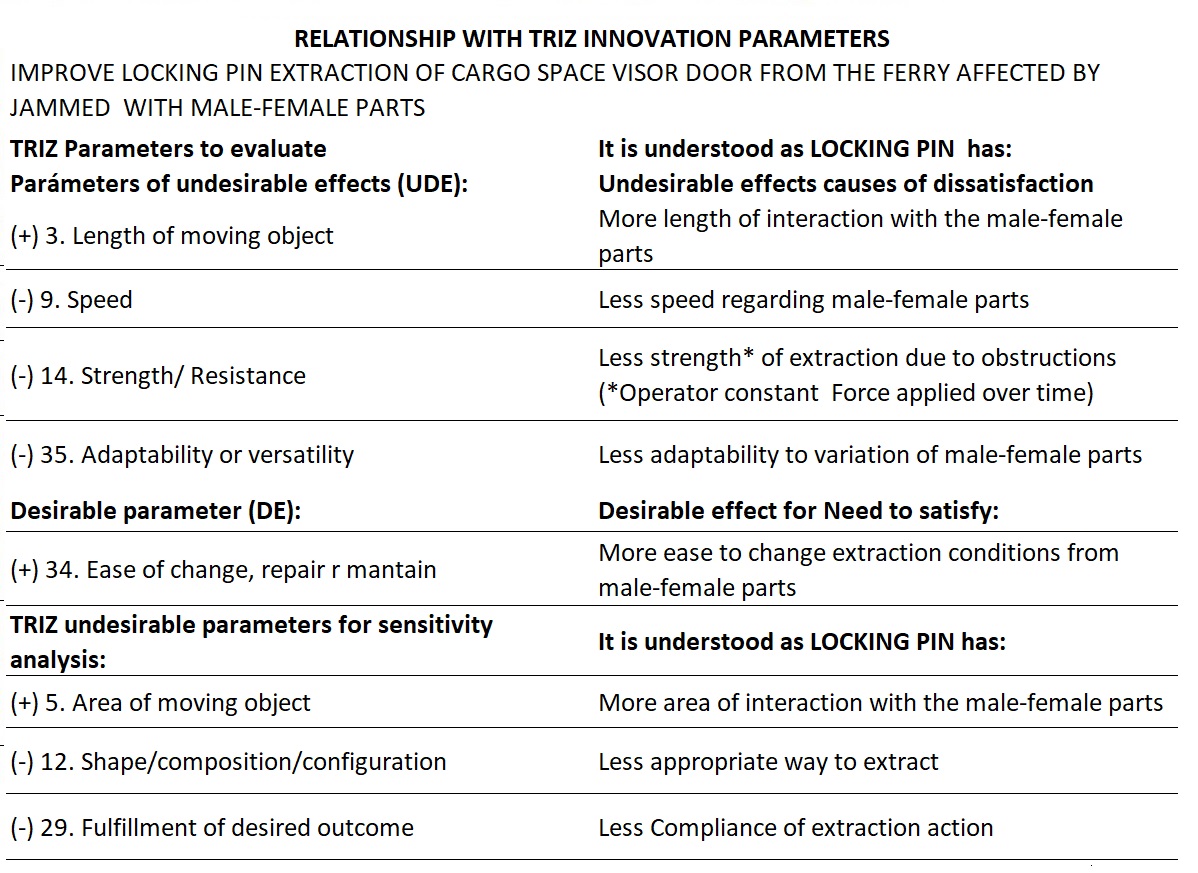
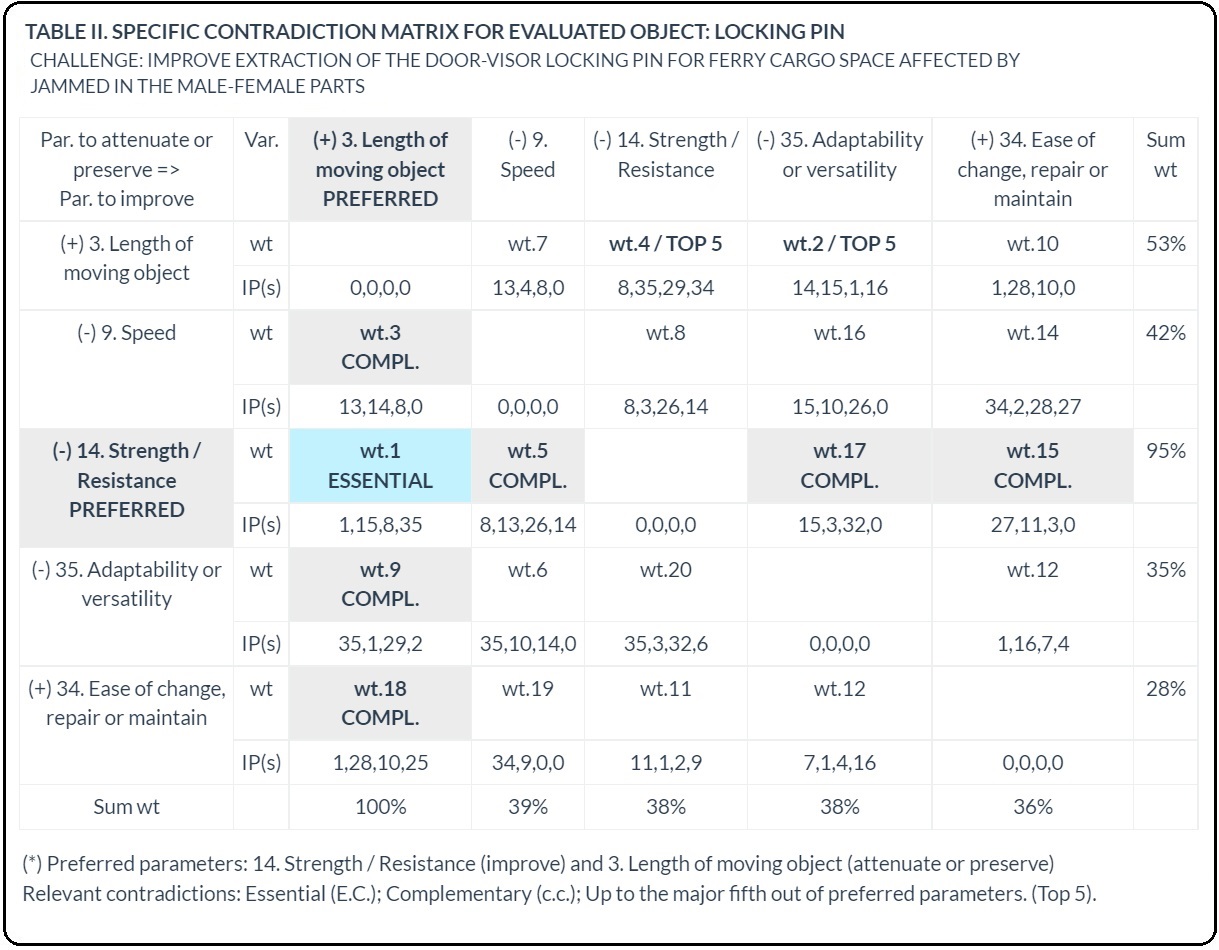
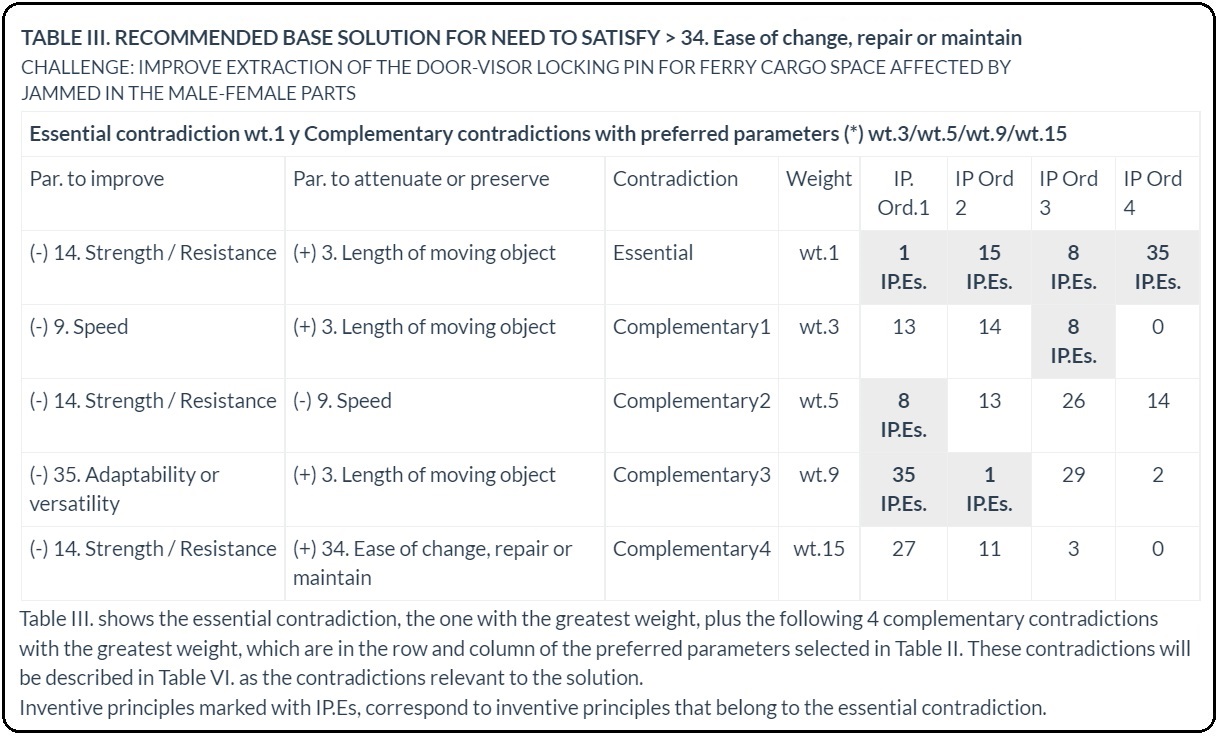


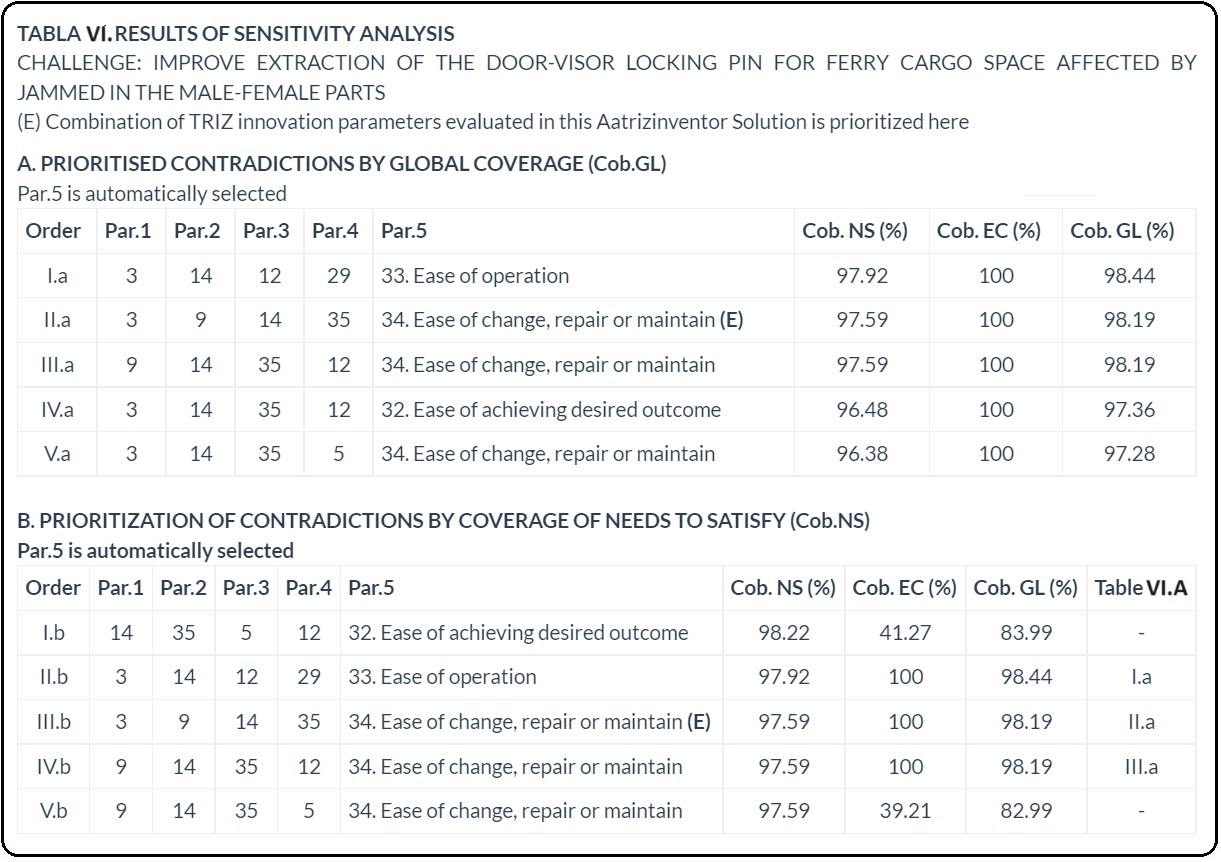
SYSTEMATIC IDEATION OF THE SOLUTION
The ideation criteria are the same as those indicated in letter A above.
SOLUTION VALIDATION
The validation criteria are the same as those indicated in letter A above.
Below is a graph with the current situation, plus the specific solution for the case of improve removal of jammed locking pin with male-female parts in a locking mechanism and the description of the relevant contradictions adapted to the evaluated case, which explains how the recommended solution is formed.

SPECIFIC DESCRIPTION OF THE RELEVANT CONTRADICTIONS
CONTRADICTIONS of TABLE III.
Contradiction N°1 - wt.1 : Compensated dynamics
Parameter to improve: (-) 14. Strength/ Resistance
=> Improve (UDE): Locking pin has Less strength, provided by the Operator, for extraction from male-female parts.
Parameter to attenuate or preserve: (+) 3. Length of moving object
=> Attenuate or preserve (UDE): Locking pin has More length of interaction with the male-female parts.
Inventive principles IP(s): [1,15,8,35]
" To improve the extraction strength of the Locking Pin (Par.14) and attenuate or preserve its greater length of interaction with male-female parts (Par.3), the Locking Pin must be segmented into several parts (IP.1 Segmenting/Integrating) to improve the dynamics of extraction avoiding interferences that affect its movement (IP.15 Dynamics).For this, a new design is required that compensates or limits movement difficulties (IP.8 Counterweight/Compensation), changing its operating condition to a more flexible and adaptable one (PI.35 Transformation / Change of parameters).
Contradiction N°2 - wt.3 : Angled compensation
Parameter to improve: (-) 9. Speed
=> Improve (UDE): Lock pin has Less relative speed to male-female parts.
Parameter to attenuate or preserve: (+) 3. Length of moving object
=> Attenuate or preserve (UDE): Locking pin has More length of interaction with the male-female parts.
Inventive principles IP(s): [13,14,8,0]
To improve the lower relative speed to male-female parts (Par.9) and attenuate or preserve the greater length of interaction (Par.3), the condition of the Locking Pin must be changed (IP.13 Inverse or indirect action ), incorporating curved or angled shapes (IP.14 Sphericity -Curvature -Angle), which allow compensation for poor extraction dynamics (IP.8 Counterweight / Compensation).
Contradiction N°3 - wt.5 : Compensated Replica
Parameter to improve: (-) 14. Strength/ Resistance
=> Improve (UDE): Locking pin has less strength, provided by the Operator, for extraction from male-female parts.".
".
Parameter to attenuate or preserve: (-) 9. Speed
=> Attenuate or preserve (UDE): Locking pin has less speed regarding male-female parts.
Inventive principles IP(s): [8,13,26,14]
To improve the extraction strength of the Locking Pin (Par.14) and attenuate or preserve the lower speed of extraction (Par.9), the limitations of movement of the Locking Pin must be compensated (IP.8 Counterweight / Compensation), by a change of condition or position (IP.13 Inverse or indirect action), considering using an improved replica of the locking pin (IP.26 Coping/Replicating), including curved or angled shapes to facilitate removal (IP.14 Sphericity -Curvature -Angle).
Contradiction N°4 - wt.9 : Controlled segmentation
Parameter to improve: (-) 35. Adaptability or Versatility
=> Improve (UDE): Locking pin has Less adaptability to male-female parts.
.
Parameter to attenuate or preserve: (+) 3. Length of moving object
=> Attenuate or preserve (UDE): Locking pin has More length of interaction with the male-female parts.
Inventive principles IP(s): [35,1,29,2]
To improve the adaptability of extraction of the Locking Pin to the male-female parts (Par.35) and to Attenuate or preserve the greater length of interaction (Par.3), the Locking Pin must be transformed (IP.35 Transformation/Change), with a design by segments (IP.1 Segmenting/Integrating), containing adjustable design variables (IP.29 Controllable Soft Variables). The new Locking Pin design should separate the interfering parts and leave only the necessary for a reliable extraction (IP.2 Taking out/ Adding).
Contradiction N°5 - wt.15: Cheap pre-mitigation
Parameter to improve: (-) 14. Strength/ Resistance
=> Improve (UDE): Lock pin has less strength for extraction from male-female parts.
Parameter to preserve: (+) 34. Ease of change, repair or maintain
=> Preserve (DE): Locking pin has More Ease to change extraction conditions from male-female parts
Inventive principles IP(s): [27,11,3,0]
To improve the strength for extraction of Locking Pin (Par.14) and preserve greater ease of changing extraction conditions (Par.34), Locking Pin should be replaced (in whole or in part) with multiple low-cost items or subparts (IP.27 Cheap and short-lived objects), which allow undesirable effects that are expected to occur to be compensated in advance (IP.11 Beforehand cushioning), changing its form from uniform to non-uniform (IP.3 Local quality)." .
CONTRADICTIONS of TABLE IV.
Contradiction between needs to satisfy N°1: Equipotential segmented replica
Parameter to improve: (+) 34. Ease of change, repair or maintain
=> Improve (DE): Locking pin has More Ease to change the extraction conditions from male parts- female.
Parameter to preserve: (+) 33. Ease of operation
=> Preserve (DE): Locking pin has More ease of extraction operation.
Inventive principles IP(s): [1,12,26,15]
To improve the ease of changing the extraction conditions from male-female parts (Par.34) and Preserve the ease of operation of the extraction (Par.33), the Locking Pin must be segmented (IP.1 Segmenting / Integrating ), so that it is exposed to constant stresses during extraction (IP.12 Equipotentiality) This requires generating an improved replica of the Locking Pin (IP.26 Coping/Replicating), which has a dynamic that is not affected by interference (IP.15 Dynamic).
"OTHER CONTRADICTIONS IN TABLE II.
Contradiction order wt.2 : Angled dynamics +/-
Parameter to improve: (+) 3. Length of moving object
=> Improve (UDE): Locking pin has more length of interaction with the male-female parts."."< br>".
Parameter to attenuate or preserve: (-) 35. Adaptability or Versatility
=> Attenuate or preserve (UDE): Locking pin has less adaptability for extraction due to variability of male-female parts.
Inventive principles IP(s): [14,15,1,16]
To improve the greater length of interaction of the Locking Pin with the male-female parts (Par.3) and Attenuate or preserve the lower adaptability to the male-female parts (Par.35), the new Locking Pin must be incorporated curved or angled shapes (IP.14 Sphericity -Curvature -Angle), which allow a dynamic that is not affected by external interference (IP.15 Dynamic) A segmented Locking Pin design is required (IP.1 Segment/ Integrate), which has the possibility of adjusting the applied solution a little more or a little less to achieve the desired result.(IP.16 Partial or excessive actions).
Parameter to improve: (+) 34. Ease of change, repair or maintain
=> Improve (DE): Locking pin has More ease to change the extraction conditions from male parts- female.
Parameter to attenuate or preserve: (-) 35. Adaptability or Versatility
=> Attenuate or preserve (UDE): Locking pin has less adaptability for extraction due to variability of male-female parts.
Inventive principles IP(s): [7,1,4,16]
To improve the ease of removal of the Locking Pin (Par.34) and Attenuate or preserve the less adaptability to the male-female parts (Par.35), the Locking Pin must be nested with the male-female parts (PI .7 Nesting/Dispersing), which requires a segmented (IP.1 Segment/Integrate) and asymmetric (IP.4 Asymmetry/ Symmetry) design. For the new locking pin, the applied solution should be adjusted a little more or a little less to achieve the desired result.(IP.16 Partial or excessive actions).
Operation order wt.14 : Use and discard of simple mechanics
Parameter to improve: (-) 9. Speed
=> Improve (UDE): Lock pin has Less speed regarding male-female parts.
Parameter to attenuate or preserve: (+) 34. Ease of change, repair or maintain
=> Preserve (DE): Locking pin has More ease to change extraction conditions from parts male-female.
Inventive principles IP(s): [34,2,28,27]
To improve the slower extraction speed of the Locking Pin (Par.9) and preserve greater ease of changing extraction conditions (Par.34), the Locking Pin must be designed so that it has the appropriate locking capacity and can be released quickly (IP.34 Discarding and Recovering), which requires removing the interfering parts and leaving only the necessary ones (IP.2 Taking out/Adding). The new Locking Pin design should change the removal mechanic from fixed to variable to interact with the male-female parts (IP.28 mechanical substitution) The Locking Pin should be divided (either fully or partially) into several inexpensive parts, sufficient to achieve the desired result.(IP.27 Cheap and short living objects).
" The interpreted description of the selected contradictions allows the Innovation Team to specify the solution, whose characteristics are shown in the figure above. It is proposed, as an exercise for the reader, to write the summary of the solution, as shown at the end of cases A, B and C above.
"WHAT COMES NOW?
The development of the innovation challenges presented in point 8 of this Manual has been completed and there is a specific solution. What comes next?
"Undoubtedly, every innovative idea requires an implementation plan. Nature's L.I. unties a critical knot of many innovation projects,
systematically developing a solution, based on often-applied innovation concepts, without brainstorming or innovator paradigms. Then there is more confidence that the solution will achieve the desired effect. In addition, Nature's L.I. it can help solve other challenges that arise in the implementation process of the solution, accelerating the realization of the innovation sought. Consequently, once the solution has been obtained from Nature's L.I., the next step will be to work and work to make the solution obtained a reality.
The Nature's Language of Innovation, Nature's L.I., is more than a methodology, it is a philosophical approach that says that: The innovation-evolution in Nature, which includes the human being, follows
immutable laws in time and space.
"When you decide to integrate Nature's into your daily life, you will be giving way to a fascinating adventure.
You may face feelings of rejection of this idea, leaving your space of comfort can generate insecurity and fears.
Nature's will be your mentor, showing you application examples and will give you advice when you need it.
Crossing the threshold is not easy, seek support from your own 'Big Boss', share this new vision, invite others to this challenge.
Make tests, conquer allies, contain your enemies and convert the disbelievers.
Get involved with Nature's L.I., train, learn a new way of thinking, leave your old paradigms behind.
Reaches the point of no return to be reborn, decides to use Nature's L.I. in your daily life, to think outside the box.
When this happens, you will be prepared to face all your challenges, even those that seemed impossible to solve.
Accept it, there will be some who do not believe you, but you will have the tools to design a new way of working and you should share it.
The satisfactory results will come for everyone's satisfaction.
The human being, part of this Nature, who dares to be a follower of this revealed language and listens to Nature,
will innovate better and faster and will be happy.
" The human being, part of this Nature, who dares to be a follower of this revealed language and listens to Nature,
will innovate better and faster and will be happy.
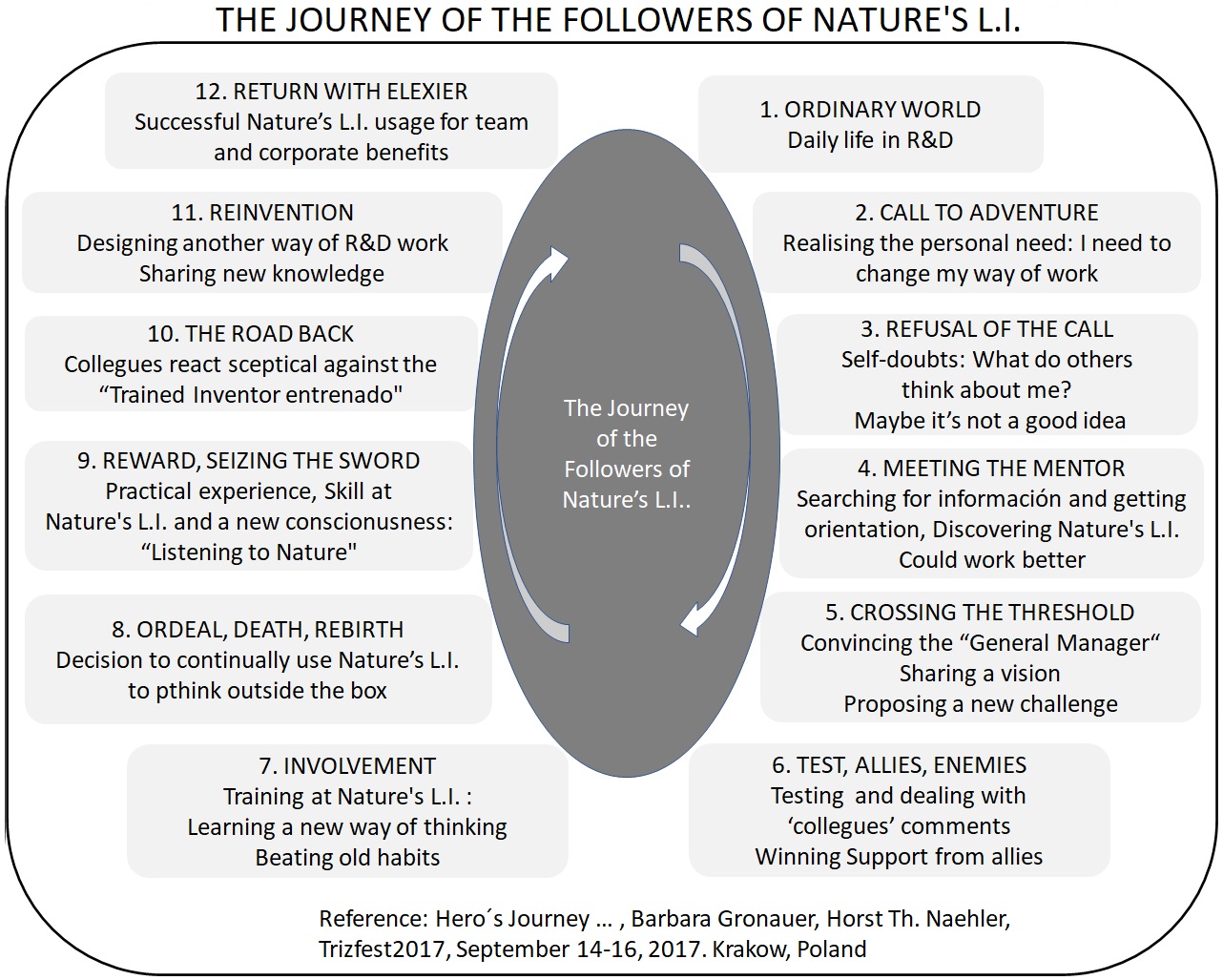
Below is the classic TRIZ Contradiction Matrix. It has been divided into 7 sections, showing an increase in the number of parameters from left to right.
At each intersection between parameters are the inventive principles that solve the corresponding contradiction.
Contradictions between all parameters to improve and the parameters to mitigate or preserve from 1 to 6
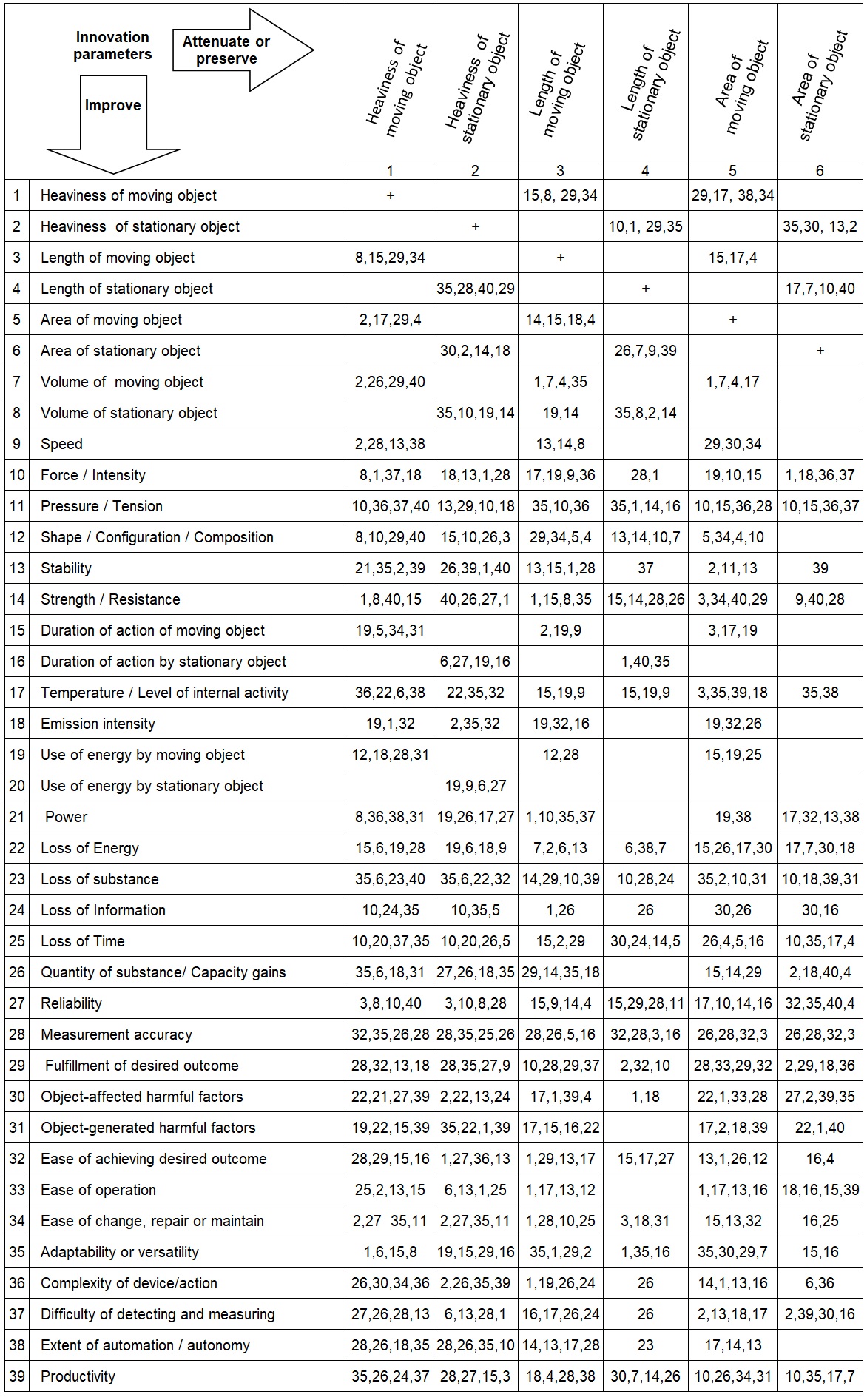
Contradictions between all parameters to improve and the parameters to mitigate or preserve from 7 to 12
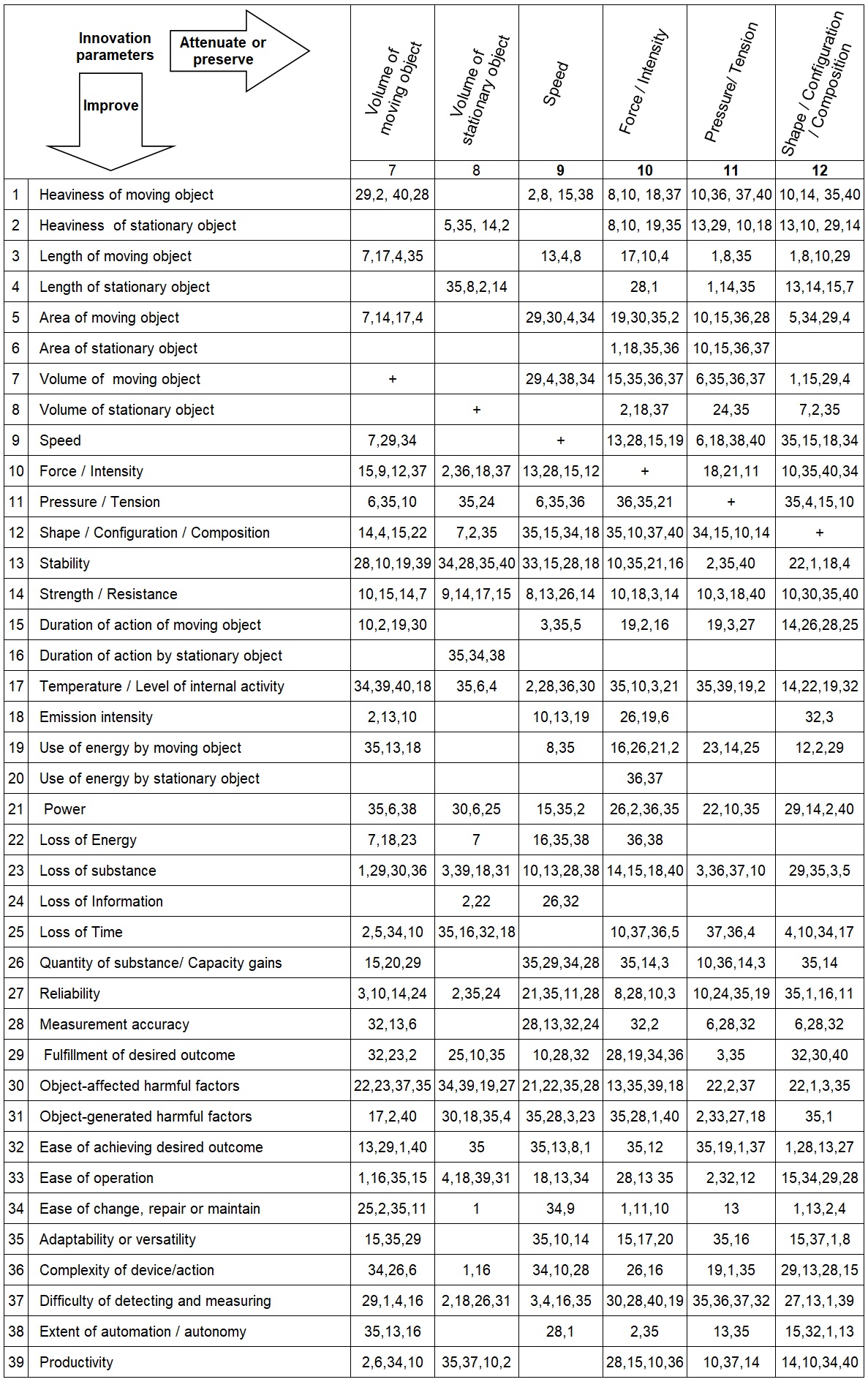
Contradictions between all parameters to improve and the parameters to mitigate or preserve from 13 to 18
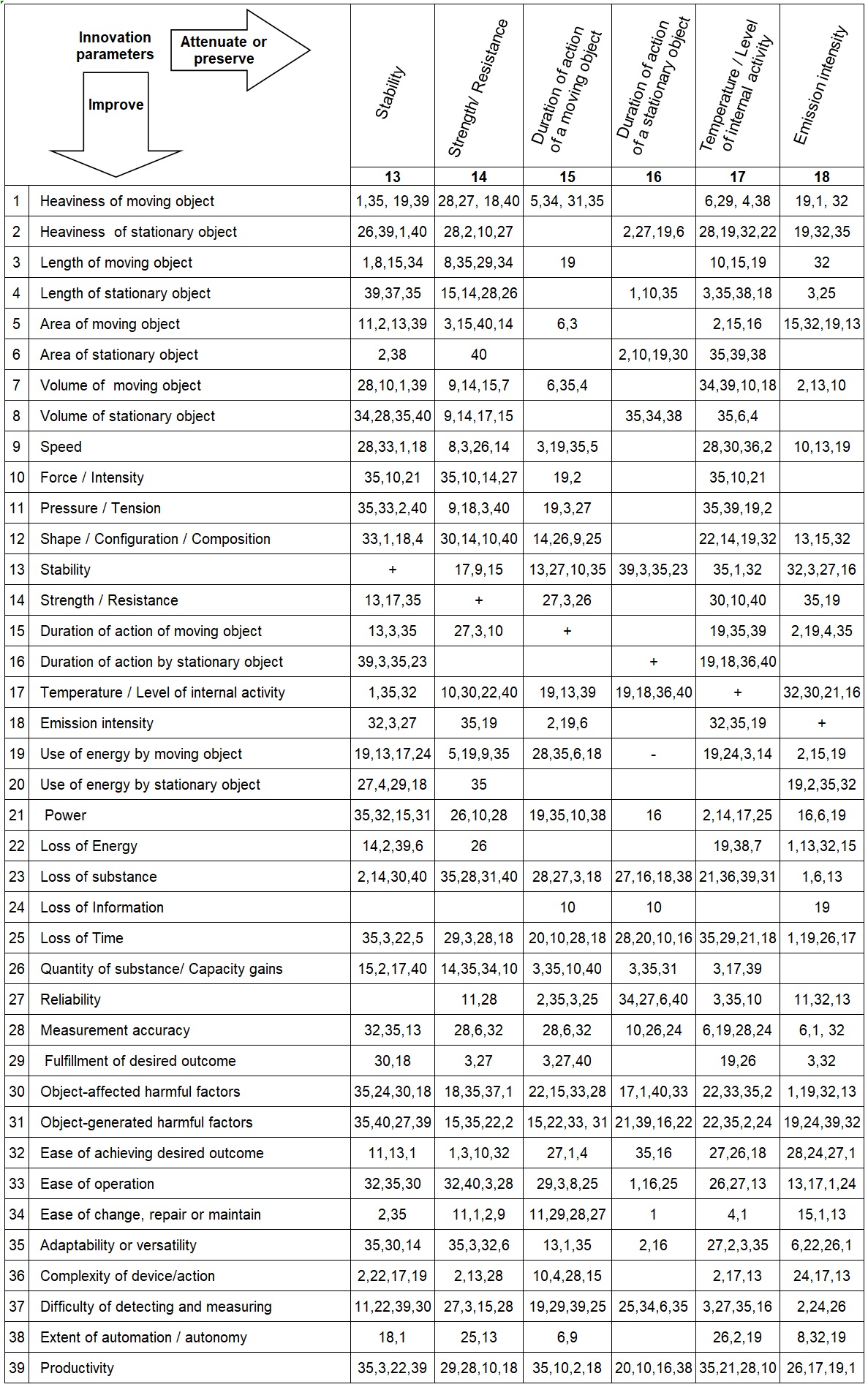
Contradictions between all parameters to improve and the parameters to mitigate or preserve from 19 to 24
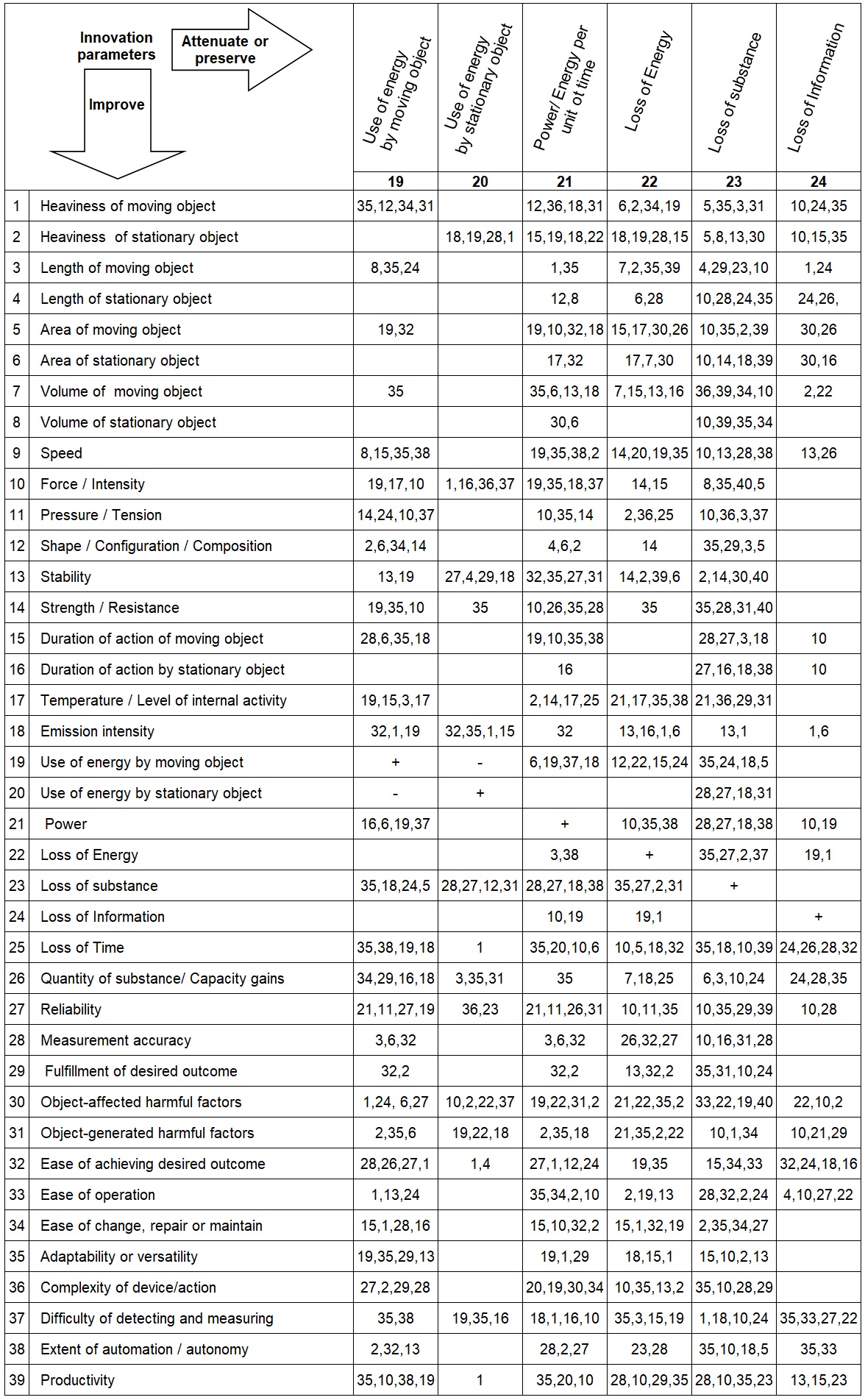
Contradictions between all parameters to improve and the parameters to mitigate or preserve from 25 to 30

Contradictions between all parameters to improve and the parameters to mitigate or preserve from 31 to 36

Contradictions between all parameters to improve and the parameters to mitigate or preserve from 37 to 39

